Paul van Yperen's Blog, page 13
May 29, 2025
Leo Slezak
Leo Slezak (1873-1946) was an Austrian dramatic tenor. He was associated in particular with Austrian opera as well as the title role in Verdi's 'Otello'. In 1932, he started a second career as a character actor and singer in German and Austrian films. Slezak is the father of actors Walter Slezak and Margarete Slezak and the grandfather of soap actress Erika Slezak.
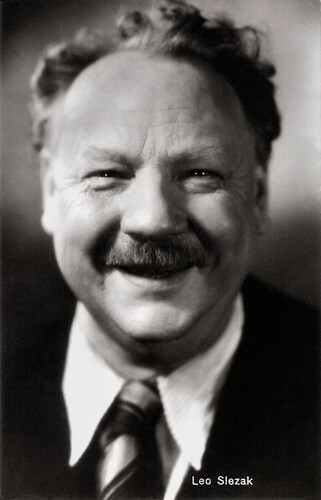
German card.
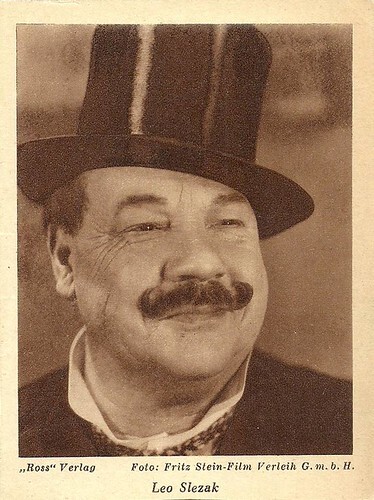
German postcard or collector's card by Ross Verlag. Photo: Fritz-Stein-Film Verleih GmbH.
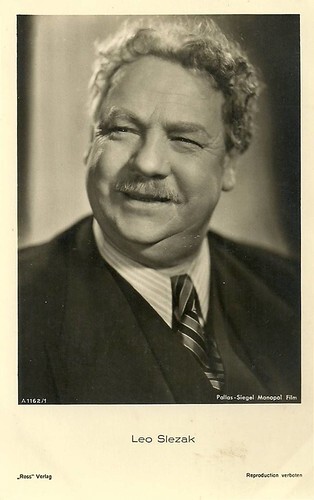
German postcard by Ross Verlag, no. A1161/1, 1937-1938. Photo: Pallas-Siegel Monopol-Film.
A tall, barrel-chested man with a large and attractive lyric-dramatic voice
Leo Slezak was born in Šumperk (German: Mährisch-Schönberg), northern Moravia (then part of Austria-Hungary), as the son of a miller. Slezak worked briefly as a blacksmith and an engineer's fitter, and he served in the army before taking singing lessons with the first-class baritone and pedagogue, Adolf Robinson.
He made his debut as Lohengrin in the Opera by Richard Wagner in 1896 in Brno (Brünn) and proceeded to sing leading roles in Bohemia and Germany, appearing in 1898–1899 in Berlin. He then moved to Breslau, where he met his future wife, the actress Elsa Wertheim. From 1901 onwards, he was a permanent member of the ensemble of the Vienna State Opera. His successful career began.
A tall, barrel-chested man, Slezak possessed a large and attractive lyric-dramatic voice which enabled him to undertake all but the very heaviest Wagnerian parts such as Tristan or Siegfried. Slezak's international career commenced in London at the Royal Opera House, Covent Garden, where he sang Siegfried and Lohengrin in 1900. In 1907, he studied in Paris with the great tenor Jean de Reszke. Slezak wanted to learn to sing his roles in the original language, especially in Italian (Gaetano Donizetti, Giuseppe Verdi, Giacomo Puccini, Ruggiero Leoncavallo, etc.) and French (Léo Delibes, Giacomo Meyerbeer, Georges Bizet, Fromental Halévy, François-Adrien Boieldieu, etc.).
He purposefully laid the foundations for an international career. Slezak had a distinctive tonal quality, which became markedly darker after his studies with de Reszke. In 1909, Slezak secured a three-year contract with the New York Metropolitan Opera. Met audiences acclaimed him in performances of works by Richard Wagner and Giuseppe Verdi. Along with Italy's Giovanni Zenatello, he became one of the most famous Otellos of his generation, famously performing the role at the Met with Arturo Toscanini conducting.
Leo Slezak had a versatile repertory which embraced 66 roles. When the First World War broke out during a guest performance in Russia, he had to flee and was welcomed back with open arms by the Viennese. He was not only successful on the opera stage but also as a lieder singer. In April 1934, he took to the stage of the Vienna State Opera for the last time as Otello.
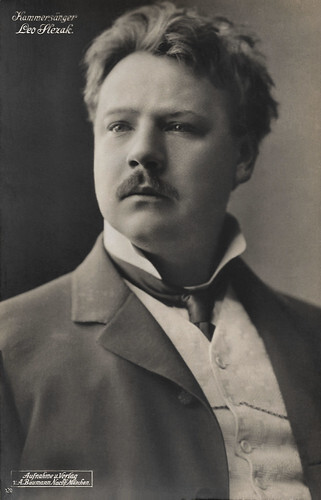
German postcard by Verlag A. Baumann Naeff, München, no. 120. Photo: A. Baumann Naeff. Caption: Chamber singer Leo Slezak.
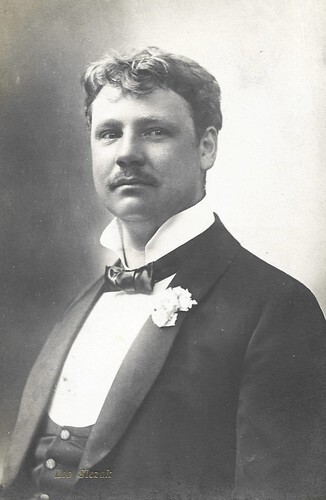
Austrian postcard. Photo: Carl Pietzner, Vienna.
A doomed audition for Frau Wagner at Bayreuth
Leo Slezak made hundreds of disc and cylinder recordings from the early 1900s into the 1930s. They were produced by several different record companies and include arias, duets and songs by a wide selection of composers, ranging from Mozart to Wagner. Most of his best records have been released on CD compilations.
Some of his film work as an actor survives as well. Slezak appeared and sang in two early sound shorts, Wilhelm Tell: Die Sonne strahlt / Wilhelm Tell: The Sun Shines (1907) and Troubadour: Miserere (1909). The first shows in three minutes the finale of Gioaccino Rossini’s opera 'William Tell' (1829), staged for the Deutsche Bioscop camera as a very static tableau, with a painted backdrop of rocks, ocean waves, and a ship’s bowsprit.
In 1932, Slezak began his second career as a star in German and Austrian films. He mostly played comic roles and almost always sang as well. His films included La Paloma / The Dove (Karl Heinz Martin, Robert Neppach, 1934), Rendezvous in Wien / Rendezvous in Vienna (Victor Janson, 1936), and Konfetti / Confetti (Hubert Marischka, 1936). A big hit was the Operetta film Gasparone (Georg Jacoby, 1937), starring Marika Rökk and Johannes Heesters . Another box-office hit was Es war eine rauschende Ballnacht / The Life and Loves of Tschaikovsky (Carl Froelich, 1939) with Zarah Leander and Marika Rökk.
Slezak's final film role was as the portly Sultan Abd ul Hamid in the Ufa prestige production Münchhausen (Josef von Báky, 1943), starring Hans Albers. In 1944, Slezak was on the 'Gottbegnadeten-Liste', the list of those pardoned by the Reich Ministry for Popular Enlightenment and Propaganda. Slezak's autobiography, published in 1938 in English as 'Song of Motley: Being the Reminiscences of a Hungry Tenor', contains pen-portraits of many of the musicians and artists with whom he worked, including Gustav Mahler, Arturo Toscanini and Cosima Wagner. It describes his tours of America, Russia and the Balkans and recalls his doomed audition for Frau Wagner at Bayreuth, when he foolishly chose to sing music from 'Pagliacc'i.
Later in life, he published several very humorous, semi-autobiographical books, notably 'Meine sämtlichen Werke' (All of my Works), 'Der Wortbruch' (The Broken Promise), and 'Der Rückfall' (The Relapse). Leo Slezak spent the last years of his life in Rottach-Egern, where he died of a heart attack in 1946. He is buried in the cemetery of St Laurentius Church (Egern) next to his wife, Elisabeth. His son, Walter Slezak , was a successful character actor in Hollywood during the 1940s and appeared in anti-Nazi films. His granddaughter and Walter's daughter is the actress Erika Slezak, noted for her role on the soap opera One Life to Live (1971-2013).
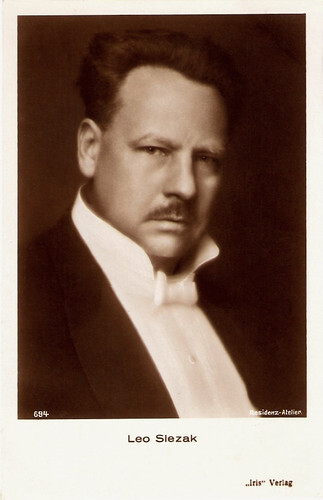
Austrian postcard by Iris Verlag, no. 694. Photo: Residenz-Atelier.
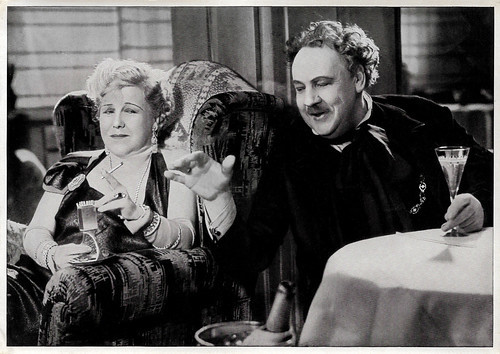
German collector card in the series 'Vom Werden deutscher Filmkunst - Der Tonfilm', album no. 11, picture no. 30. Photo: Ufa / Ross Verlag. Ida Wüst and Leo Slezak in Freut Euch des Lebens / Enjoy Yourselves (Hans Steinhoff, 1934).
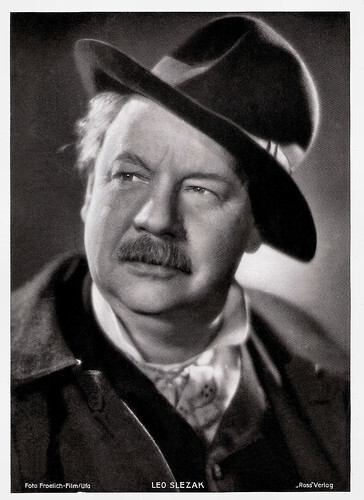
German collector card by Ross Verlag. Photo: Froelich-Film / Ufa.
Sources: Annti Alanen (Annti Alanen: Film Diary), Wikipedia (English and German) and .

German card.

German postcard or collector's card by Ross Verlag. Photo: Fritz-Stein-Film Verleih GmbH.

German postcard by Ross Verlag, no. A1161/1, 1937-1938. Photo: Pallas-Siegel Monopol-Film.
A tall, barrel-chested man with a large and attractive lyric-dramatic voice
Leo Slezak was born in Šumperk (German: Mährisch-Schönberg), northern Moravia (then part of Austria-Hungary), as the son of a miller. Slezak worked briefly as a blacksmith and an engineer's fitter, and he served in the army before taking singing lessons with the first-class baritone and pedagogue, Adolf Robinson.
He made his debut as Lohengrin in the Opera by Richard Wagner in 1896 in Brno (Brünn) and proceeded to sing leading roles in Bohemia and Germany, appearing in 1898–1899 in Berlin. He then moved to Breslau, where he met his future wife, the actress Elsa Wertheim. From 1901 onwards, he was a permanent member of the ensemble of the Vienna State Opera. His successful career began.
A tall, barrel-chested man, Slezak possessed a large and attractive lyric-dramatic voice which enabled him to undertake all but the very heaviest Wagnerian parts such as Tristan or Siegfried. Slezak's international career commenced in London at the Royal Opera House, Covent Garden, where he sang Siegfried and Lohengrin in 1900. In 1907, he studied in Paris with the great tenor Jean de Reszke. Slezak wanted to learn to sing his roles in the original language, especially in Italian (Gaetano Donizetti, Giuseppe Verdi, Giacomo Puccini, Ruggiero Leoncavallo, etc.) and French (Léo Delibes, Giacomo Meyerbeer, Georges Bizet, Fromental Halévy, François-Adrien Boieldieu, etc.).
He purposefully laid the foundations for an international career. Slezak had a distinctive tonal quality, which became markedly darker after his studies with de Reszke. In 1909, Slezak secured a three-year contract with the New York Metropolitan Opera. Met audiences acclaimed him in performances of works by Richard Wagner and Giuseppe Verdi. Along with Italy's Giovanni Zenatello, he became one of the most famous Otellos of his generation, famously performing the role at the Met with Arturo Toscanini conducting.
Leo Slezak had a versatile repertory which embraced 66 roles. When the First World War broke out during a guest performance in Russia, he had to flee and was welcomed back with open arms by the Viennese. He was not only successful on the opera stage but also as a lieder singer. In April 1934, he took to the stage of the Vienna State Opera for the last time as Otello.

German postcard by Verlag A. Baumann Naeff, München, no. 120. Photo: A. Baumann Naeff. Caption: Chamber singer Leo Slezak.

Austrian postcard. Photo: Carl Pietzner, Vienna.
A doomed audition for Frau Wagner at Bayreuth
Leo Slezak made hundreds of disc and cylinder recordings from the early 1900s into the 1930s. They were produced by several different record companies and include arias, duets and songs by a wide selection of composers, ranging from Mozart to Wagner. Most of his best records have been released on CD compilations.
Some of his film work as an actor survives as well. Slezak appeared and sang in two early sound shorts, Wilhelm Tell: Die Sonne strahlt / Wilhelm Tell: The Sun Shines (1907) and Troubadour: Miserere (1909). The first shows in three minutes the finale of Gioaccino Rossini’s opera 'William Tell' (1829), staged for the Deutsche Bioscop camera as a very static tableau, with a painted backdrop of rocks, ocean waves, and a ship’s bowsprit.
In 1932, Slezak began his second career as a star in German and Austrian films. He mostly played comic roles and almost always sang as well. His films included La Paloma / The Dove (Karl Heinz Martin, Robert Neppach, 1934), Rendezvous in Wien / Rendezvous in Vienna (Victor Janson, 1936), and Konfetti / Confetti (Hubert Marischka, 1936). A big hit was the Operetta film Gasparone (Georg Jacoby, 1937), starring Marika Rökk and Johannes Heesters . Another box-office hit was Es war eine rauschende Ballnacht / The Life and Loves of Tschaikovsky (Carl Froelich, 1939) with Zarah Leander and Marika Rökk.
Slezak's final film role was as the portly Sultan Abd ul Hamid in the Ufa prestige production Münchhausen (Josef von Báky, 1943), starring Hans Albers. In 1944, Slezak was on the 'Gottbegnadeten-Liste', the list of those pardoned by the Reich Ministry for Popular Enlightenment and Propaganda. Slezak's autobiography, published in 1938 in English as 'Song of Motley: Being the Reminiscences of a Hungry Tenor', contains pen-portraits of many of the musicians and artists with whom he worked, including Gustav Mahler, Arturo Toscanini and Cosima Wagner. It describes his tours of America, Russia and the Balkans and recalls his doomed audition for Frau Wagner at Bayreuth, when he foolishly chose to sing music from 'Pagliacc'i.
Later in life, he published several very humorous, semi-autobiographical books, notably 'Meine sämtlichen Werke' (All of my Works), 'Der Wortbruch' (The Broken Promise), and 'Der Rückfall' (The Relapse). Leo Slezak spent the last years of his life in Rottach-Egern, where he died of a heart attack in 1946. He is buried in the cemetery of St Laurentius Church (Egern) next to his wife, Elisabeth. His son, Walter Slezak , was a successful character actor in Hollywood during the 1940s and appeared in anti-Nazi films. His granddaughter and Walter's daughter is the actress Erika Slezak, noted for her role on the soap opera One Life to Live (1971-2013).

Austrian postcard by Iris Verlag, no. 694. Photo: Residenz-Atelier.

German collector card in the series 'Vom Werden deutscher Filmkunst - Der Tonfilm', album no. 11, picture no. 30. Photo: Ufa / Ross Verlag. Ida Wüst and Leo Slezak in Freut Euch des Lebens / Enjoy Yourselves (Hans Steinhoff, 1934).

German collector card by Ross Verlag. Photo: Froelich-Film / Ufa.
Sources: Annti Alanen (Annti Alanen: Film Diary), Wikipedia (English and German) and .
Published on May 29, 2025 22:00
May 28, 2025
Natalie Portman
Israeli-American actress, director and film producer Natalie Portman (1981) got her first role in the action thriller Léon / The Professional (1994) as Jean Reno's co-star. The big success came when she got the role of Padmé Amidala in Star Wars Episode I, II and III (1999, 2002 and 2005). She was nominated for an Oscar for her role in Closer (2005), which won her a Golden Globe. In 2011, she won the Oscar for Best Female Lead for Black Swan.
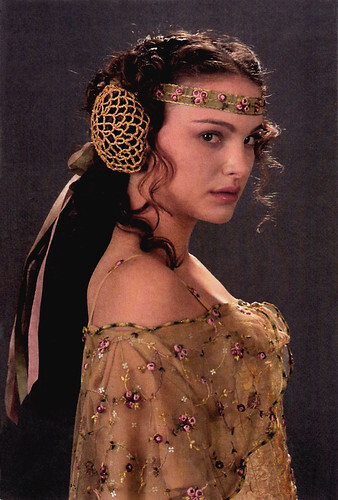
Chinese postcard by Oriental City Publishing Group. Photo: Lucasfilm. Natalie Portman as Queen Amidala in Star Wars: Episode II - Attack of the Clones (George Lucas, 2002).
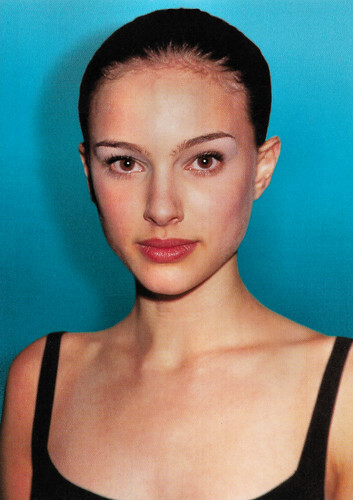
British postcard by Pyramid, Leicester, no. PC 2104. Photo: Mitchell Gerber / Corbis. Caption: Natalie Portman, Portrait.
An orphan girl befriends a middle-aged hitman
Natalie Portman was born Natalie Hershlag (Hebrew: נטע-לי הרשלג) in Jerusalem, Israel, in 1981. She is the only child of Israeli doctor Avner Hershlag and his Jewish-American wife, born Shelley Stevens. ‘Portman’ is a stage name, after her grandmother's original surname. The family moved to Maryland due to her father's job, then Connecticut, before settling on Long Island.
Portman was discovered in a pizzeria when she was 11 years old by an agent of Revlon, who wanted her as a model. She turned his offer down with a view to an acting career. Her mother became her agent.
At 12, she made her film debut as Matilda in the action drama Léon / The Professional (Luc Besson, 1994). Her role as an orphan girl who befriends a middle-aged hitman ( Jean Reno ) was the beginning of a pattern of portraying characters who are usually particularly intelligent and mature for their age.
Michael Mann offered her the small part of the suicidal stepdaughter of Al Pacino 's character in the action film Heat (1995). Ted Demme cast her as a precocious teenager who flirts with her much-older neighbour (Timothy Hutton) in the ensemble comedy-drama Beautiful Girls (1996). Portman received good reviews for her part.
She next appeared in Tim Burton's comic Science Fiction film Mars Attacks! (1996) and Woody Allen's musical Everyone Says I Love You (1996). In 1997, she briefly withdrew from film to take part in the Broadway revival of ‘The Diary of Anne Frank'. This stage role was followed by the coming-of-age film Anywhere but Here (Wayne Wang, 1999) in which Susan Sarandon played her mother. Portman was nominated for a Golden Globe in 1999 for her role as Ann August in the film.
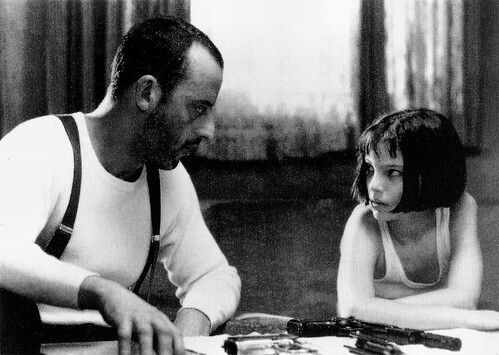
French postcard, no. PP 104. Jean Reno and Natalie Portman in Léon/Léon: The Professional (Luc Besson, 1994).
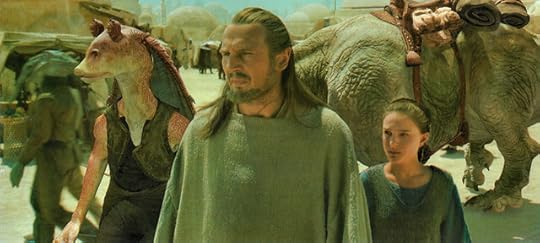
American postcard by Classico San Francisco, no. 490-005. Photo: Lucasfilm. Ahmed Best as Jar Jar Binks, Liam Neeson as Qui-Gon Jinn and Natalie Portman as Padmé in Star Wars - Episode I - The Phantom Menace (George Lucas, 1999).
A young woman looking for her place in life
Star Wars fans know Natalie Portman as Padmé Amidala in George Lucas’s prequel trilogy, Star Wars: Episode I: The Phantom Menace (1999), Star Wars: Episode II: Attack of the Clones (2002) and Star Wars: Episode III: Revenge of the Sith (2005), her first big-budget productions. She worked closely with the director, George Lucas, on her character's accent and mannerisms.
She did not attend the first episode's premiere so she could study for her high school finals. In 1999, Portman graduated from Syosset High School in Syosset, Long Island. In 2003, she graduated from Harvard University with a degree in psychology. The following year, Portman returned to Israel and participated in various courses at the Hebrew University of Jerusalem.
In the Summer of 2001, Portman acted in a stage production of ‘The Seagull’, based on a play by Anton Chekhov. The production, directed by Mike Nichols and also starring Meryl Streep and Kevin Kline, was a hit with audiences at the Delacorte Theatre in New York's Central Park. In the film Closer (Mike Nichols, 2004), she played Alice, a young woman looking for her place in life alongside Julia Roberts , Jude Law and Clive Owen. She won the Golden Globe Award for this film and was nominated for Best Supporting Actress at the 2005 Academy Awards. Closer grossed over $115 million worldwide against a $27 million budget.
Also in 2004, she portrayed the upbeat and disorderly Sam in the independent romantic comedy Garden State (Zach Braff, 2004). She then played Evey Hammond in V for Vendetta (James McTeigue, 2005), based on the comics of the same name, about an alternative future where a neo-fascist regime has subjugated the United Kingdom. For this role, she had her head shaved. In 2007, Portman was featured in the music video for Paul McCartney 's single 'Dance Tonight'. In 2012, she collaborated again with McCartney in the song 'My Valentine'.
Scarlett Johansson and Portman portrayed rival sisters Mary and Anne Boleyn in the period drama The Other Boleyn Girl (Justin Chadwick, 2008). She served as a jury member of the 2008 Cannes Film Festival and also launched her own production company, named Handsomecharlie Films, after her late dog. Portman's directorial debut, the short film Eve, opened the short-film screenings at the 65th Venice International Film Festival. Portman is known for her social engagement. In Venice, she won the ‘Movie for Humanity’ award, an award for the actor or actress who has done the most for good causes that year. In 2009, she appeared in a faux perfume commercial called Greed, directed by Roman Polanski.
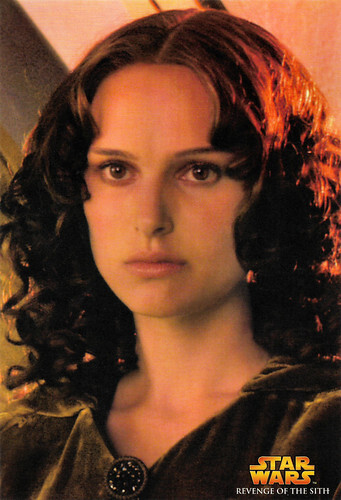
American postcard by Classico San Francisco, no. 106-128. Photo: Lucasfilm. Natalie Portman as Padmé Amidala in Star Wars: Episode 3 - Revenge of the Sith (George Lucas, 2005).
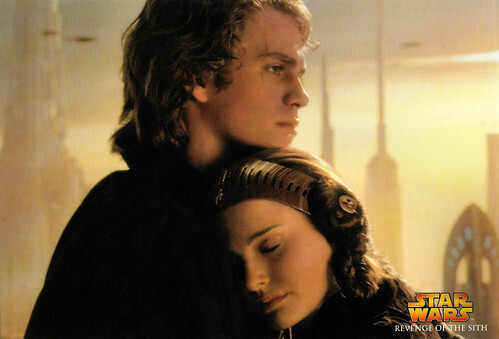
American postcard by Classico San Francisco, no. 106-136. Photo: Lucasfilm. Hayden Christensen as Anakin Skywalker and Natalie Portman as Padmé Amidala in Star Wars: Episode 3 - Revenge of the Sith (George Lucas, 2005).
An ambitious ballerina overwhelmed with the prospect of performing Swan Lake
After producing and co-starring alongside Joseph Gordon-Levitt in the black comedy Hesher (Spencer Susser, 2010), Natalie Portman played the title role of Nina Sayers, a ballet dancer, in the psychological thriller Black Swan (Darren Aronofsky, 2010). The ambitious ballerina is overwhelmed with the prospect of performing Swan Lake. Portman was trained by the professional ballerina Mary Helen Bowers, and in preparation, she trained for five to eight hours daily for six months and lost 20 pounds (9 kg). Her acclaimed performance earned her her second Golden Globe Award and an Oscar. Black Swan emerged as a sleeper hit, grossing over $329 million worldwide against a $13 million budget.
Her film adaptation of Amos Oz's autobiographical novel, A Tale of Love and Darkness (Natalie Portman, 2015) premiered at the Cannes International Film Festival. In 2016, she took on the role of presidential wife Jacqueline Kennedy in the biopic Jackie (Pablo Larraín, 2016), about Kennedy's life immediately after the 1963 assassination of her husband. It earned Portman a third Oscar nomination.
She has also been part of the Marvel Cinematic Universe since her role as Jane Foster in the comic adaptation Thor (Kenneth Branagh, 2011), followed by Thor - The Dark Kingdom (Alan Taylor, 2013) and Thor: Love and Thunder (Taika Waititi, 2022) with Chris Hemsworth as the title character. This established her as one of the world's highest-paid actresses.
As a producer, she was involved in the films Hesher (Spencer Susser, 2010), Jane Got a Gun (Gavin O'Connor, 2016) and Pride and Prejudice and Zombies (Burr Steers, 2016). Portman has also directed the short film Eve (2008) and the biographical drama A Tale of Love and Darkness (2015), in which she also starred. In 2021, Portman and her producing partner, Sophie Mas, founded the production company MountainA, under which she produced and starred in the film May December (Todd Haynes, 2023) with Julianne Moore and the miniseries Lady in the Lake (Alma Har'el, 2024).
While filming Black Swan (2010), Portman got into a relationship with choreographer Benjamin Millepied. In 2010, their spokesperson announced that they were engaged and that Portman was pregnant. She gave birth to a son, Aleph (2011) and a daughter, Amalia (2017). Portman and Millepied married in 2012. Portman separated from Millepied after allegedly having an affair with a 25-year-old climate activist in the summer of 2023. The divorce was finalised in early 2024. Natalie Portman will next star in Fountain of Youth, an adventure film directed by Guy Ritchie.

American postcard by Classico San Francisco, no. 106-021. Photo: Lucasfilm. Natalie Portman as Queen Amidala in Star Wars: Episode I - The Phantom Menace (George Lucas, 1999).
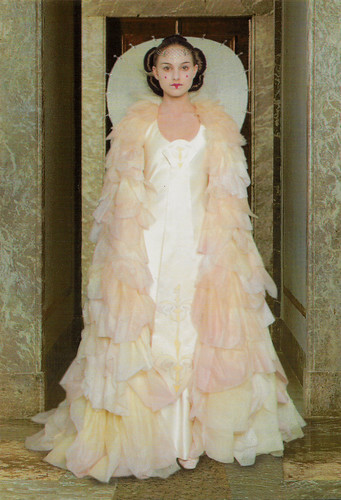
American postcard by Classico San Francisco, no. 106-004. Photo: Lucasfilm. Natalie Portman as Queen Amidala in Star Wars - Episode I - The Phantom Menace (George Lucas, 1999).
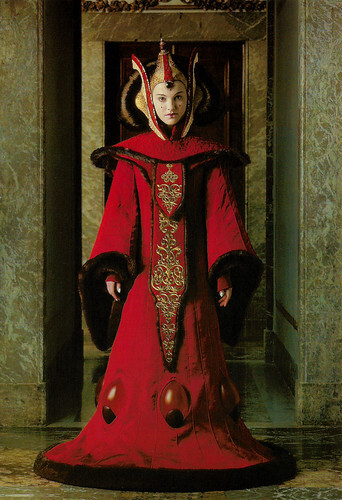
American postcard by Classico San Francisco, no. 106-032. Photo: Lucasfilm. Natalie Portman as Queen Amidala in Star Wars - Episode I - The Phantom Menace (George Lucas, 1999).
Sources: Wikipedia (Dutch, German and English) and .

Chinese postcard by Oriental City Publishing Group. Photo: Lucasfilm. Natalie Portman as Queen Amidala in Star Wars: Episode II - Attack of the Clones (George Lucas, 2002).

British postcard by Pyramid, Leicester, no. PC 2104. Photo: Mitchell Gerber / Corbis. Caption: Natalie Portman, Portrait.
An orphan girl befriends a middle-aged hitman
Natalie Portman was born Natalie Hershlag (Hebrew: נטע-לי הרשלג) in Jerusalem, Israel, in 1981. She is the only child of Israeli doctor Avner Hershlag and his Jewish-American wife, born Shelley Stevens. ‘Portman’ is a stage name, after her grandmother's original surname. The family moved to Maryland due to her father's job, then Connecticut, before settling on Long Island.
Portman was discovered in a pizzeria when she was 11 years old by an agent of Revlon, who wanted her as a model. She turned his offer down with a view to an acting career. Her mother became her agent.
At 12, she made her film debut as Matilda in the action drama Léon / The Professional (Luc Besson, 1994). Her role as an orphan girl who befriends a middle-aged hitman ( Jean Reno ) was the beginning of a pattern of portraying characters who are usually particularly intelligent and mature for their age.
Michael Mann offered her the small part of the suicidal stepdaughter of Al Pacino 's character in the action film Heat (1995). Ted Demme cast her as a precocious teenager who flirts with her much-older neighbour (Timothy Hutton) in the ensemble comedy-drama Beautiful Girls (1996). Portman received good reviews for her part.
She next appeared in Tim Burton's comic Science Fiction film Mars Attacks! (1996) and Woody Allen's musical Everyone Says I Love You (1996). In 1997, she briefly withdrew from film to take part in the Broadway revival of ‘The Diary of Anne Frank'. This stage role was followed by the coming-of-age film Anywhere but Here (Wayne Wang, 1999) in which Susan Sarandon played her mother. Portman was nominated for a Golden Globe in 1999 for her role as Ann August in the film.

French postcard, no. PP 104. Jean Reno and Natalie Portman in Léon/Léon: The Professional (Luc Besson, 1994).

American postcard by Classico San Francisco, no. 490-005. Photo: Lucasfilm. Ahmed Best as Jar Jar Binks, Liam Neeson as Qui-Gon Jinn and Natalie Portman as Padmé in Star Wars - Episode I - The Phantom Menace (George Lucas, 1999).
A young woman looking for her place in life
Star Wars fans know Natalie Portman as Padmé Amidala in George Lucas’s prequel trilogy, Star Wars: Episode I: The Phantom Menace (1999), Star Wars: Episode II: Attack of the Clones (2002) and Star Wars: Episode III: Revenge of the Sith (2005), her first big-budget productions. She worked closely with the director, George Lucas, on her character's accent and mannerisms.
She did not attend the first episode's premiere so she could study for her high school finals. In 1999, Portman graduated from Syosset High School in Syosset, Long Island. In 2003, she graduated from Harvard University with a degree in psychology. The following year, Portman returned to Israel and participated in various courses at the Hebrew University of Jerusalem.
In the Summer of 2001, Portman acted in a stage production of ‘The Seagull’, based on a play by Anton Chekhov. The production, directed by Mike Nichols and also starring Meryl Streep and Kevin Kline, was a hit with audiences at the Delacorte Theatre in New York's Central Park. In the film Closer (Mike Nichols, 2004), she played Alice, a young woman looking for her place in life alongside Julia Roberts , Jude Law and Clive Owen. She won the Golden Globe Award for this film and was nominated for Best Supporting Actress at the 2005 Academy Awards. Closer grossed over $115 million worldwide against a $27 million budget.
Also in 2004, she portrayed the upbeat and disorderly Sam in the independent romantic comedy Garden State (Zach Braff, 2004). She then played Evey Hammond in V for Vendetta (James McTeigue, 2005), based on the comics of the same name, about an alternative future where a neo-fascist regime has subjugated the United Kingdom. For this role, she had her head shaved. In 2007, Portman was featured in the music video for Paul McCartney 's single 'Dance Tonight'. In 2012, she collaborated again with McCartney in the song 'My Valentine'.
Scarlett Johansson and Portman portrayed rival sisters Mary and Anne Boleyn in the period drama The Other Boleyn Girl (Justin Chadwick, 2008). She served as a jury member of the 2008 Cannes Film Festival and also launched her own production company, named Handsomecharlie Films, after her late dog. Portman's directorial debut, the short film Eve, opened the short-film screenings at the 65th Venice International Film Festival. Portman is known for her social engagement. In Venice, she won the ‘Movie for Humanity’ award, an award for the actor or actress who has done the most for good causes that year. In 2009, she appeared in a faux perfume commercial called Greed, directed by Roman Polanski.

American postcard by Classico San Francisco, no. 106-128. Photo: Lucasfilm. Natalie Portman as Padmé Amidala in Star Wars: Episode 3 - Revenge of the Sith (George Lucas, 2005).

American postcard by Classico San Francisco, no. 106-136. Photo: Lucasfilm. Hayden Christensen as Anakin Skywalker and Natalie Portman as Padmé Amidala in Star Wars: Episode 3 - Revenge of the Sith (George Lucas, 2005).
An ambitious ballerina overwhelmed with the prospect of performing Swan Lake
After producing and co-starring alongside Joseph Gordon-Levitt in the black comedy Hesher (Spencer Susser, 2010), Natalie Portman played the title role of Nina Sayers, a ballet dancer, in the psychological thriller Black Swan (Darren Aronofsky, 2010). The ambitious ballerina is overwhelmed with the prospect of performing Swan Lake. Portman was trained by the professional ballerina Mary Helen Bowers, and in preparation, she trained for five to eight hours daily for six months and lost 20 pounds (9 kg). Her acclaimed performance earned her her second Golden Globe Award and an Oscar. Black Swan emerged as a sleeper hit, grossing over $329 million worldwide against a $13 million budget.
Her film adaptation of Amos Oz's autobiographical novel, A Tale of Love and Darkness (Natalie Portman, 2015) premiered at the Cannes International Film Festival. In 2016, she took on the role of presidential wife Jacqueline Kennedy in the biopic Jackie (Pablo Larraín, 2016), about Kennedy's life immediately after the 1963 assassination of her husband. It earned Portman a third Oscar nomination.
She has also been part of the Marvel Cinematic Universe since her role as Jane Foster in the comic adaptation Thor (Kenneth Branagh, 2011), followed by Thor - The Dark Kingdom (Alan Taylor, 2013) and Thor: Love and Thunder (Taika Waititi, 2022) with Chris Hemsworth as the title character. This established her as one of the world's highest-paid actresses.
As a producer, she was involved in the films Hesher (Spencer Susser, 2010), Jane Got a Gun (Gavin O'Connor, 2016) and Pride and Prejudice and Zombies (Burr Steers, 2016). Portman has also directed the short film Eve (2008) and the biographical drama A Tale of Love and Darkness (2015), in which she also starred. In 2021, Portman and her producing partner, Sophie Mas, founded the production company MountainA, under which she produced and starred in the film May December (Todd Haynes, 2023) with Julianne Moore and the miniseries Lady in the Lake (Alma Har'el, 2024).
While filming Black Swan (2010), Portman got into a relationship with choreographer Benjamin Millepied. In 2010, their spokesperson announced that they were engaged and that Portman was pregnant. She gave birth to a son, Aleph (2011) and a daughter, Amalia (2017). Portman and Millepied married in 2012. Portman separated from Millepied after allegedly having an affair with a 25-year-old climate activist in the summer of 2023. The divorce was finalised in early 2024. Natalie Portman will next star in Fountain of Youth, an adventure film directed by Guy Ritchie.

American postcard by Classico San Francisco, no. 106-021. Photo: Lucasfilm. Natalie Portman as Queen Amidala in Star Wars: Episode I - The Phantom Menace (George Lucas, 1999).

American postcard by Classico San Francisco, no. 106-004. Photo: Lucasfilm. Natalie Portman as Queen Amidala in Star Wars - Episode I - The Phantom Menace (George Lucas, 1999).

American postcard by Classico San Francisco, no. 106-032. Photo: Lucasfilm. Natalie Portman as Queen Amidala in Star Wars - Episode I - The Phantom Menace (George Lucas, 1999).
Sources: Wikipedia (Dutch, German and English) and .
Published on May 28, 2025 22:00
May 27, 2025
Directed by Otto Rippert
German film director Otto Rippert (1869-1940) was one of the pioneers of German silent cinema who celebrated great commercial and artistic success. His six-part Science-Fiction serial, Homunculus (1916-1917), was one of the most successful German-made film series produced during World War I. It foreshadowed the classics Metropolis (1927) and Frankenstein (1931). Rippert worked with the big stars of the time, including Werner Krauß and Hella Moja, with whom he made numerous films.
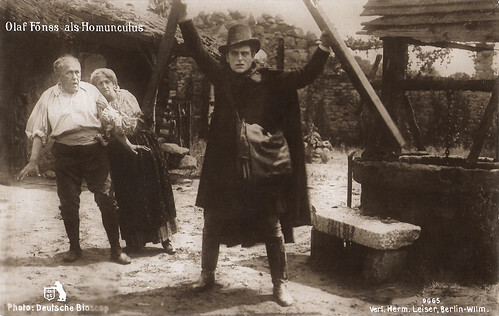
German postcard by Verlag Hermann Leiser, Berlin, no. 9665. Photo: Deutsche Bioscop. Olaf Fønss in Homunculus (Otto Rippert, 1916).
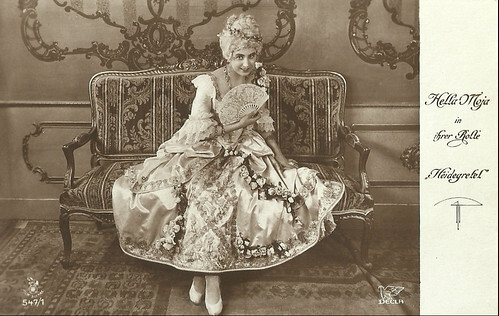
German postcard in the Film-Sterne series by Rotophot, no. 547/1. Hella Moja in the German silent film Heide-Gretel (Otto Rippert, 1918), produced by the Decla-Filmgellschaft (Eric Pommer). Cinematography was by Carl Hoffmann, and the script by Carl Schneider. Moja's male co-actors were Max Ruhbeck and Leopold von Ledebur. The film premiered at the Berlin Marmorhaus cinema in February 1918.
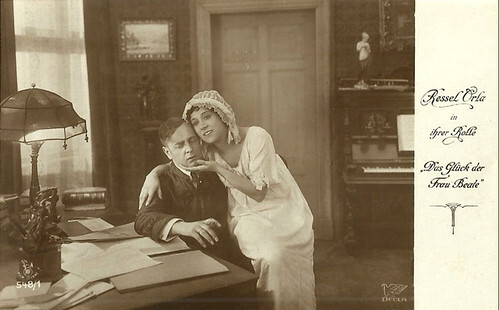
German postcard by Rotophot in the Film Sterne series, no. 548/1, 1919-1924. Photo: Decla. Ressel Orla and Emil Birron in Das Glück der Frau Beate / The luck of the Mrs. Beate (Alwin Neuß, Otto Rippert, 1918).
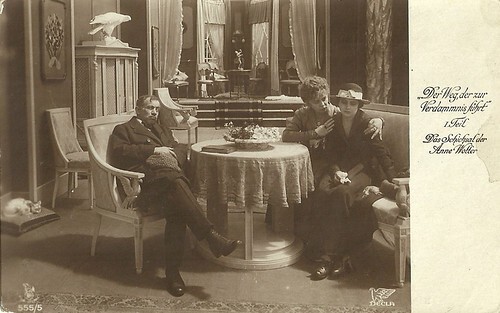
German postcard in the Film-Sterne series by Rotophot, no. 555/5. Photo: Decla. Charlotte Böcklin in Der Weg, der zur Verdammnis führt, I. Das Schicksal der Anne Wolter (Otto Rippert, 1918). The man may be the white slave trader Ignaz Czyslow (Guido Herzfeld).
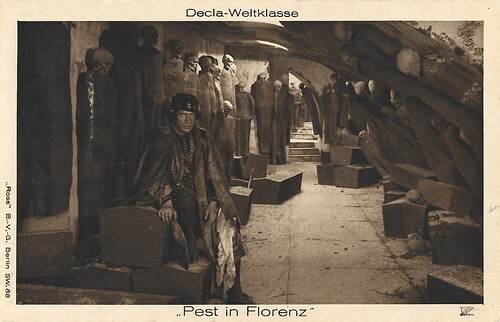
German postcard by Ross B.-V.-G., Berlin. Photo: Decla. Theodor Becker as Franziskus in the catacombs in Pest in Florenz/The Plague in Florence (Otto Rippert, 1919).
The second film made about the sinking of the Titanic
Otto Rippert was born in 1869 in Offenbach am Main, Germany. Rippert made his debut in Meißen in 1889. He worked at theatres in Eisleben (1892), Riga (1893) and Munich (1894), where he directed for the first time in 1898. In 1899, he worked in London, then in Nuremberg and in 1906 in Baden-Baden. From 1907 to 1910, he worked as an artistic theatre director, first in Forst in Lausitz (Lusatia) and then at the Bamberg State Theatre.
Rippert came into contact with film more by chance. In 1906, a film crew for the French Gaumont Film Company visiting Baden Baden was looking for a director at the local theatre. They were referred to Otto Rippert, who took on a leading role as well as directing. It was his first film, but it wasn't until the next decade, when the medium began to grow beyond the former fairground attraction, that Rippert turned to film full-time.
In 1911, Rippert went to Berlin. In 1912, he appeared, complete with a stick-on beard, as the millionaire Isidor Straus in the film In Nacht und Eis / In Night and Ice (Mime Misu, 1912), about the sinking of the Titanic. It is the second film made, and the first surviving one, about the disaster. With a running time of 35 minutes, In Nacht und Eis was three times longer than the average film of 1912. Shot in black and white, various scenes were tinted to heighten their impact, such as night scenes in dark blue and a shot of a stoker feeding a burner in red.
In Nacht und Eis / In Night and Ice was made by Continental-Kunstfilm of Berlin, where Rippert continued to work as a director. He had his breakthrough as a director with the short silent melodrama Gelbstern (Otto Rippert, 1912), with Thea Sandten in the leading role. Rippert made some ten films for Continental-Kunstfilm between 1912 and 1914, most of which are considered lost.
In the 1910s, Rippert became one of the most productive German directors. However, his reputation as one of the pioneers of German silent film rests on some of his later achievements, his masterpieces Homunculus, Pest in Florenz / The Plague of Florence and Der Totentanz /The Dance of Death.
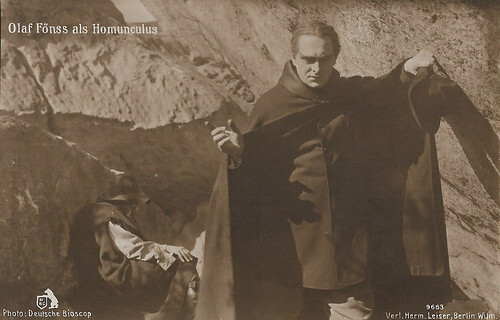
German postcard by Verlag Hermann Leiser, Berlin, no. 9663. Photo: Deutsche Bioscop. Olaf Fønss in the German film Homunculus (Otto Rippert, 1916).
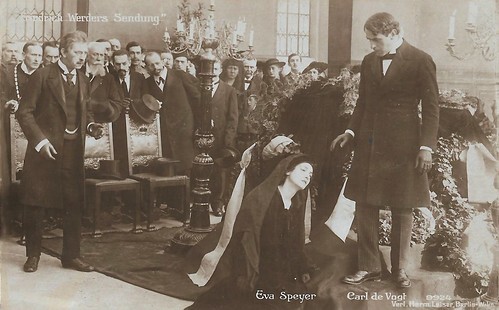
German postcard by Verlag Hermann Leiser, Berlin, no. 9924. Eva Speyer and Carl de Vogt in Friedrich Werders Sendung (Otto Rippert, 1916), scripted by Hugo Landsberger. This was one of the first films of De Vogt, who played the title role, while Speyer played his wife.
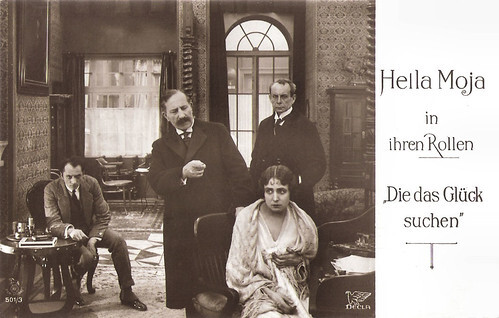
German postcard by Rotophot in the Film Sterne series, no. 501/3. Photo: Decla. Hella Moja and Theodor Loos (far left) in the German silent film Die das Glück suchen / Those Searching for Happyness (1917). Oddly, this title does not appear in the databases Filmportal.de and IMDb. Yet, an announcement in Der Kinematograph of 1918 and earlier remarks in Der Lichtbildbühne of 1917 suggest the film did exist, was directed by Otto Rippert and scripted by Paul Otto. By looking at the numbers of the Film-Sterne series, the film must date from 1917. It is not clear when the film was made or if the film was released. Other actors mentioned as playing in the film were Hermann Thimig (who might be the doctor-like figure on our other card of the film), Anderly Lebius, and Otto Lins-Morstadt. Cinematography was by Max Fassbender. Thanks to Jean Ritsema for this information.
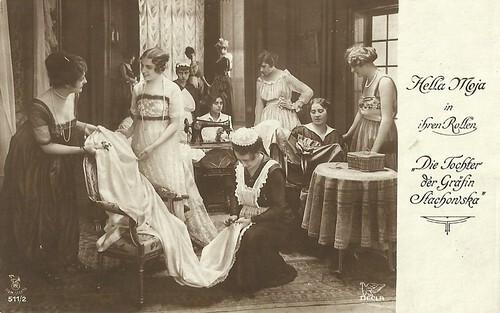
German postcard in the Film Sterne Series by Rotophot, no. 511/2. Photo: Decla. Hella Moja in Die Tochter der Gräfin Stachowska (Otto Rippert, 1917), produced by Erich Pommer.
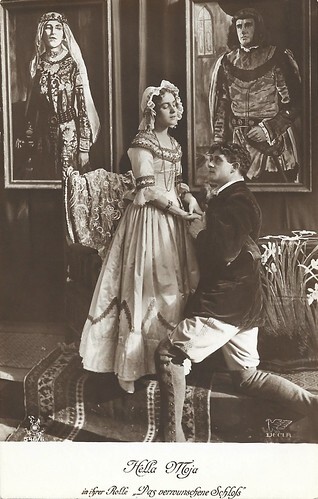
German postcard by Rotophot in the Film-Sterne series, no. 546/6. Photo: Decla. Hella Moja as Veronika and Carl Auen as Gontard in Das verwunschene Schloß / The Haunted Castle (Otto Rippert, 1918).
Mad scientists, superhuman androids and sinister technology
Otto Rippert's Homunculus (1916) is a six-part serial science fiction film involving mad scientists, superhuman androids and sinister technology. Danish star Olaf Fønss (aka Olaf Fönss ) stars as Homunculus. The script was written by Robert Reinert, and the film was originally produced by Deutsche Bioscop GmbH. Reinert's script is loosely based on the epic poem 'Homunculus' written by Robert Hamerling in 1888.
The subject of a monstrous man-made being turning against its creator is similar to Der Golem (Paul Wegener, 1915) and Alraune (Henrik Galeen, 1928). It also reminds me of Mary Shelley's 'Frankenstein', wherein a living creature, called a homunculus, is created artificially in a laboratory and strives to develop emotions like a human being. The serial also foreshadows various elements of Metropolis (Fritz Lang, 1927). It also served as a model for Frankenstein (James Whale, 1930) rather than the original silent adaptation of Shelley's novel, Frankenstein (1909), directed by Thomas Edison.
Fritz Lang wrote the script for Rippert's historical epic Pest in Florenz / The Plague of Florence (Otto Rippert, 1919) for Erich Pommer's Deutsche Eclair (Decla) production company. The screenplay was written by Fritz Lang. The film is a tragic romance set in Florence in 1348, just before the first outbreaks in Italy of the Black Death, which then spread out across the entire continent. It was the first film to feature the black plague. Pest in Florenz is an allegorical drama, which belongs to the best work of Rippert. It is a visual party with beautiful sets and costumes. Lang's screenplay was based on the Edgar Allan Poe story 'The Masque of the Red Death', but he heightened the story's sexual tension by making the plague the result of the actions of a young seductress. The cameraman was Emil Schünemann, who was behind the lens for In Nacht und Eis.
That same year, Rippert also directed a silent Horror film for Erich Pommer, Der Totentanz /The Dance of Death (Otto Rippert, 1919), written by Fritz Lang and starring Werner Krauss and Sascha Gura . His other films included Die Frau mit den Orchideen / The Woman with Orchids (Otto Rippert, 1919) starring Carl de Vogt, Werner Krauss and Gilda Langer , the historical film Gräfin Walewska / Countess Walewska (Otto Rippert, 1920) starring Hella Moja , and Die Beute der Erinnyen / The Prey of the Furies (Otto Rippert, 1922) starring Werner Krauss and Dary Holm . After 1924, Otto Rippert stopped directing films. He went to Breslau to work as a theatre director, then to Munich. From the end of the 1920s until 1939, he worked as a sound editor. In 1937, he had a stroke, and Rippert died of the after-effects in Berlin in 1940. He was 70.
After Deutsche Bioscop merged in spring 1920 with Decla-Film to form Decla-Bioscop, Homunculus was heavily edited down to three parts and re-released with colored tints and intertitles in September 1920. Only the original chapter 4 and a fragment of chapter 5 from the series were still extant. Nearly a century after Homunculus premiered, the head of the Munich Film Museum, Stefan Drößler, retrieved 27 reels of the six original chapters released in 1916/1917 from a Moscow film archive. They had been heavily cut up and jumbled, with the intertitles excised, but a restored version lasting 196 minutes was shown in August 2014 at the Rheinisches Landesmuseum Bonn as part of the Bonn Silent Film Festival.
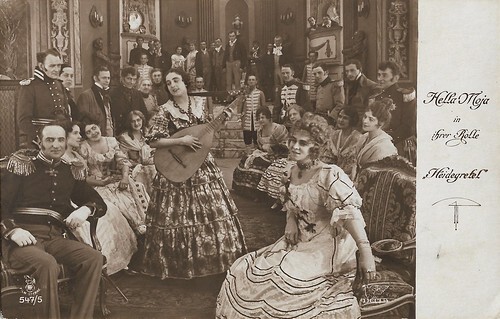
German postcard in the Film-Sterne series by Rotophot, no. 547/5. Photo: Decla. Hella Moja in Heide-Gretel (Otto Rippert, 1918). The man at left could be Leopold von Ledebur, the Prince in the film.
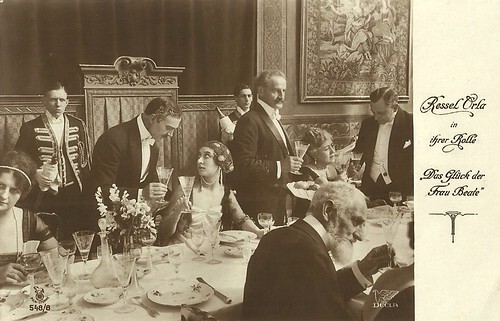
German postcard by Rotophot in the Film Sterne series, no. 548/8. Photo: Decla. Ressel Orla in Das Glück der Frau Beate/The Luck of the Mrs. Beate (Alwin Neuß, Otto Rippert, 1918).
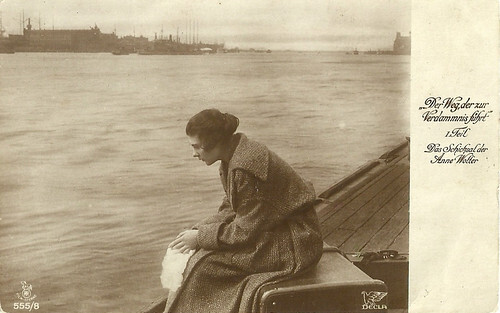
German postcard by Rotophot in the Film-Sterne series, no. 555/8. Photo: Decla. Charlotte Böcklin in Der Weg, der zur Verdammnis führt, I. Das Schicksal der Änne Wolter (Otto Rippert, 1918). Der Weg, der zur Verdammnis führt (The Road to Damnation, 1918) was a two-part film directed by Otto Rippert, of which the first part was called Das Schicksal der Änne Wolter / The Fate of Änne Wolter and the second part Hyänen der Lust / Hyenas of Lust. In the first part, Anne Wolter (Charlotte Böcklin) falls into the hands of scheming white slave traders. In the second part, two other girls fall into the hands of the white slave traders, the two naive girlfriends, Ilse von Giersdorf ( Käthe Haack ) and Lilly Gross ( Grete Weixler ).
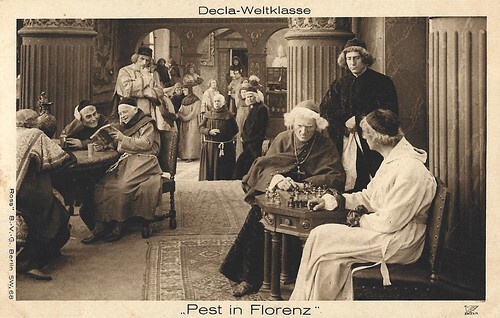
German postcard by Ross B.-V.-G., Berlin. Photo: Decla. Publicity still for the historical drama Pest in Florenz/The Plague in Florence (Otto Rippert, 1919). On the right is the Cardinal, played by Franz Knaak.
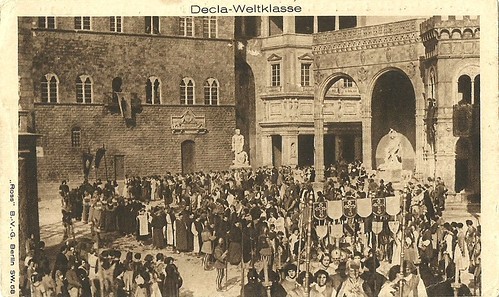
German postcard by Ross B.-V.-G., Berlin. Photo: Decla. Publicity still for the German historical drama Die Pest in Florenz/The Plague in Florence (Otto Rippert, 1919). The back of the card has a Spanish imprint. The arrival of the beautiful courtesan Julia (Marga von Kierska) in late medieval Florence causes a stir at the political establishment. Mayor Cesare (Otto Mannstaedt) cannot resist the lady, nor can his son, Lorenzo (Anders Wikman). When the woman is about to be tortured, the son kills his father and transforms the churches into dens of iniquity. Corruption and evil rule. Soon after, the city gets to deal with the Plague (Julia Brandt).
Sources: Filmportal (German), Wikipedia (German and English) and .

German postcard by Verlag Hermann Leiser, Berlin, no. 9665. Photo: Deutsche Bioscop. Olaf Fønss in Homunculus (Otto Rippert, 1916).

German postcard in the Film-Sterne series by Rotophot, no. 547/1. Hella Moja in the German silent film Heide-Gretel (Otto Rippert, 1918), produced by the Decla-Filmgellschaft (Eric Pommer). Cinematography was by Carl Hoffmann, and the script by Carl Schneider. Moja's male co-actors were Max Ruhbeck and Leopold von Ledebur. The film premiered at the Berlin Marmorhaus cinema in February 1918.

German postcard by Rotophot in the Film Sterne series, no. 548/1, 1919-1924. Photo: Decla. Ressel Orla and Emil Birron in Das Glück der Frau Beate / The luck of the Mrs. Beate (Alwin Neuß, Otto Rippert, 1918).

German postcard in the Film-Sterne series by Rotophot, no. 555/5. Photo: Decla. Charlotte Böcklin in Der Weg, der zur Verdammnis führt, I. Das Schicksal der Anne Wolter (Otto Rippert, 1918). The man may be the white slave trader Ignaz Czyslow (Guido Herzfeld).

German postcard by Ross B.-V.-G., Berlin. Photo: Decla. Theodor Becker as Franziskus in the catacombs in Pest in Florenz/The Plague in Florence (Otto Rippert, 1919).
The second film made about the sinking of the Titanic
Otto Rippert was born in 1869 in Offenbach am Main, Germany. Rippert made his debut in Meißen in 1889. He worked at theatres in Eisleben (1892), Riga (1893) and Munich (1894), where he directed for the first time in 1898. In 1899, he worked in London, then in Nuremberg and in 1906 in Baden-Baden. From 1907 to 1910, he worked as an artistic theatre director, first in Forst in Lausitz (Lusatia) and then at the Bamberg State Theatre.
Rippert came into contact with film more by chance. In 1906, a film crew for the French Gaumont Film Company visiting Baden Baden was looking for a director at the local theatre. They were referred to Otto Rippert, who took on a leading role as well as directing. It was his first film, but it wasn't until the next decade, when the medium began to grow beyond the former fairground attraction, that Rippert turned to film full-time.
In 1911, Rippert went to Berlin. In 1912, he appeared, complete with a stick-on beard, as the millionaire Isidor Straus in the film In Nacht und Eis / In Night and Ice (Mime Misu, 1912), about the sinking of the Titanic. It is the second film made, and the first surviving one, about the disaster. With a running time of 35 minutes, In Nacht und Eis was three times longer than the average film of 1912. Shot in black and white, various scenes were tinted to heighten their impact, such as night scenes in dark blue and a shot of a stoker feeding a burner in red.
In Nacht und Eis / In Night and Ice was made by Continental-Kunstfilm of Berlin, where Rippert continued to work as a director. He had his breakthrough as a director with the short silent melodrama Gelbstern (Otto Rippert, 1912), with Thea Sandten in the leading role. Rippert made some ten films for Continental-Kunstfilm between 1912 and 1914, most of which are considered lost.
In the 1910s, Rippert became one of the most productive German directors. However, his reputation as one of the pioneers of German silent film rests on some of his later achievements, his masterpieces Homunculus, Pest in Florenz / The Plague of Florence and Der Totentanz /The Dance of Death.

German postcard by Verlag Hermann Leiser, Berlin, no. 9663. Photo: Deutsche Bioscop. Olaf Fønss in the German film Homunculus (Otto Rippert, 1916).

German postcard by Verlag Hermann Leiser, Berlin, no. 9924. Eva Speyer and Carl de Vogt in Friedrich Werders Sendung (Otto Rippert, 1916), scripted by Hugo Landsberger. This was one of the first films of De Vogt, who played the title role, while Speyer played his wife.

German postcard by Rotophot in the Film Sterne series, no. 501/3. Photo: Decla. Hella Moja and Theodor Loos (far left) in the German silent film Die das Glück suchen / Those Searching for Happyness (1917). Oddly, this title does not appear in the databases Filmportal.de and IMDb. Yet, an announcement in Der Kinematograph of 1918 and earlier remarks in Der Lichtbildbühne of 1917 suggest the film did exist, was directed by Otto Rippert and scripted by Paul Otto. By looking at the numbers of the Film-Sterne series, the film must date from 1917. It is not clear when the film was made or if the film was released. Other actors mentioned as playing in the film were Hermann Thimig (who might be the doctor-like figure on our other card of the film), Anderly Lebius, and Otto Lins-Morstadt. Cinematography was by Max Fassbender. Thanks to Jean Ritsema for this information.

German postcard in the Film Sterne Series by Rotophot, no. 511/2. Photo: Decla. Hella Moja in Die Tochter der Gräfin Stachowska (Otto Rippert, 1917), produced by Erich Pommer.

German postcard by Rotophot in the Film-Sterne series, no. 546/6. Photo: Decla. Hella Moja as Veronika and Carl Auen as Gontard in Das verwunschene Schloß / The Haunted Castle (Otto Rippert, 1918).
Mad scientists, superhuman androids and sinister technology
Otto Rippert's Homunculus (1916) is a six-part serial science fiction film involving mad scientists, superhuman androids and sinister technology. Danish star Olaf Fønss (aka Olaf Fönss ) stars as Homunculus. The script was written by Robert Reinert, and the film was originally produced by Deutsche Bioscop GmbH. Reinert's script is loosely based on the epic poem 'Homunculus' written by Robert Hamerling in 1888.
The subject of a monstrous man-made being turning against its creator is similar to Der Golem (Paul Wegener, 1915) and Alraune (Henrik Galeen, 1928). It also reminds me of Mary Shelley's 'Frankenstein', wherein a living creature, called a homunculus, is created artificially in a laboratory and strives to develop emotions like a human being. The serial also foreshadows various elements of Metropolis (Fritz Lang, 1927). It also served as a model for Frankenstein (James Whale, 1930) rather than the original silent adaptation of Shelley's novel, Frankenstein (1909), directed by Thomas Edison.
Fritz Lang wrote the script for Rippert's historical epic Pest in Florenz / The Plague of Florence (Otto Rippert, 1919) for Erich Pommer's Deutsche Eclair (Decla) production company. The screenplay was written by Fritz Lang. The film is a tragic romance set in Florence in 1348, just before the first outbreaks in Italy of the Black Death, which then spread out across the entire continent. It was the first film to feature the black plague. Pest in Florenz is an allegorical drama, which belongs to the best work of Rippert. It is a visual party with beautiful sets and costumes. Lang's screenplay was based on the Edgar Allan Poe story 'The Masque of the Red Death', but he heightened the story's sexual tension by making the plague the result of the actions of a young seductress. The cameraman was Emil Schünemann, who was behind the lens for In Nacht und Eis.
That same year, Rippert also directed a silent Horror film for Erich Pommer, Der Totentanz /The Dance of Death (Otto Rippert, 1919), written by Fritz Lang and starring Werner Krauss and Sascha Gura . His other films included Die Frau mit den Orchideen / The Woman with Orchids (Otto Rippert, 1919) starring Carl de Vogt, Werner Krauss and Gilda Langer , the historical film Gräfin Walewska / Countess Walewska (Otto Rippert, 1920) starring Hella Moja , and Die Beute der Erinnyen / The Prey of the Furies (Otto Rippert, 1922) starring Werner Krauss and Dary Holm . After 1924, Otto Rippert stopped directing films. He went to Breslau to work as a theatre director, then to Munich. From the end of the 1920s until 1939, he worked as a sound editor. In 1937, he had a stroke, and Rippert died of the after-effects in Berlin in 1940. He was 70.
After Deutsche Bioscop merged in spring 1920 with Decla-Film to form Decla-Bioscop, Homunculus was heavily edited down to three parts and re-released with colored tints and intertitles in September 1920. Only the original chapter 4 and a fragment of chapter 5 from the series were still extant. Nearly a century after Homunculus premiered, the head of the Munich Film Museum, Stefan Drößler, retrieved 27 reels of the six original chapters released in 1916/1917 from a Moscow film archive. They had been heavily cut up and jumbled, with the intertitles excised, but a restored version lasting 196 minutes was shown in August 2014 at the Rheinisches Landesmuseum Bonn as part of the Bonn Silent Film Festival.

German postcard in the Film-Sterne series by Rotophot, no. 547/5. Photo: Decla. Hella Moja in Heide-Gretel (Otto Rippert, 1918). The man at left could be Leopold von Ledebur, the Prince in the film.

German postcard by Rotophot in the Film Sterne series, no. 548/8. Photo: Decla. Ressel Orla in Das Glück der Frau Beate/The Luck of the Mrs. Beate (Alwin Neuß, Otto Rippert, 1918).

German postcard by Rotophot in the Film-Sterne series, no. 555/8. Photo: Decla. Charlotte Böcklin in Der Weg, der zur Verdammnis führt, I. Das Schicksal der Änne Wolter (Otto Rippert, 1918). Der Weg, der zur Verdammnis führt (The Road to Damnation, 1918) was a two-part film directed by Otto Rippert, of which the first part was called Das Schicksal der Änne Wolter / The Fate of Änne Wolter and the second part Hyänen der Lust / Hyenas of Lust. In the first part, Anne Wolter (Charlotte Böcklin) falls into the hands of scheming white slave traders. In the second part, two other girls fall into the hands of the white slave traders, the two naive girlfriends, Ilse von Giersdorf ( Käthe Haack ) and Lilly Gross ( Grete Weixler ).

German postcard by Ross B.-V.-G., Berlin. Photo: Decla. Publicity still for the historical drama Pest in Florenz/The Plague in Florence (Otto Rippert, 1919). On the right is the Cardinal, played by Franz Knaak.

German postcard by Ross B.-V.-G., Berlin. Photo: Decla. Publicity still for the German historical drama Die Pest in Florenz/The Plague in Florence (Otto Rippert, 1919). The back of the card has a Spanish imprint. The arrival of the beautiful courtesan Julia (Marga von Kierska) in late medieval Florence causes a stir at the political establishment. Mayor Cesare (Otto Mannstaedt) cannot resist the lady, nor can his son, Lorenzo (Anders Wikman). When the woman is about to be tortured, the son kills his father and transforms the churches into dens of iniquity. Corruption and evil rule. Soon after, the city gets to deal with the Plague (Julia Brandt).
Sources: Filmportal (German), Wikipedia (German and English) and .
Published on May 27, 2025 22:00
May 26, 2025
Ivo's new aquisitions
Lately, Ivo Bloim acquired a few hundred postcards from the early 20th Century. He made a selection for this post and explained why he bought the cards.
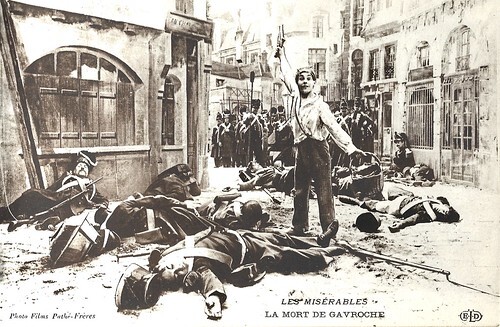
French postcard by Ed. Le Deley, Paris. Photo: Pathé Frères. Gaudin in Les Misérables (Albert Capellani, 1913), adapted from the famous novel by Victor Hugo. Caption: La mort de Gavroche (The Death of Gavroche).
During the June Revolution of 1832, young Gavroche (Gaudin), the son of the Thenardier couple, is killed while collecting bullets from deceased soldiers. On this card, he is shown as a revolutionary hero. This card is part of a booklet made by Le Deley with multiple portraits of the main actors and various scenes of the film. Ivo: " Very special was the book of cards from Les Misérables, the 1913 version. I already had one card from the series (Henri Krauss as Jean Valjean), but now we have an almost complete set of portraits and scenes. I watched a rather blurred version of the film on YouTube. In it, you can see quite well how good Krauss was as an actor, his restrained, strong acting. I also scanned a card with Etievant as Javert, but it was half out of focus, so I dropped it. So I selected the card of Gavroche at the barricades. We'll scan the whole series later and make a separate post for EFSP.
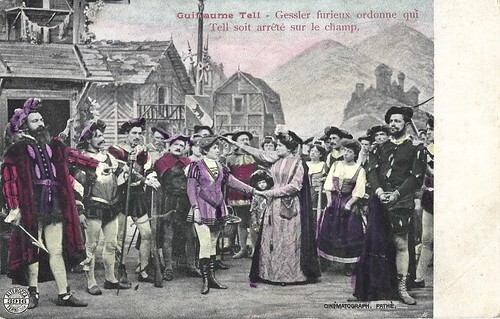
French postcard by Alterocca, no. 3916. Photo: Cinématograph Pathé. Scene from the early French film Guillaume Tell (Lucien Nonguet, 1903). Caption: Gessler furieux ordonne qui [que] Tell soit arrêté sur le champ (Infuriated, Gessler commands to arrest Tell on the spot).
Ivo: "This is the oldest card in my selection. I bought two additional cards from Guillaume Tell (1903) by Alterocca. We already had a few cards by Croissant and by Alterocca from the film. I am very happy with this addition. I selected one card for this post; the second will follow later.
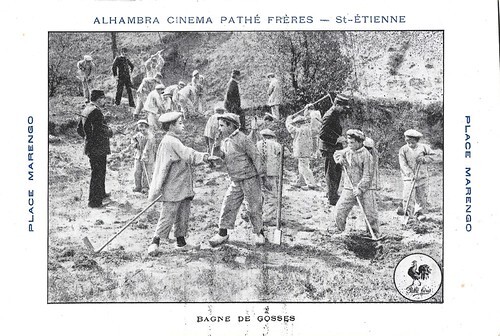
French postcard for the Alhambra Cinéma Pathé Frères, St.-Etienne. Photo: Pathé Frères. Scene from the early French film Le bagne des gosses / Children's Reformatory (Charles Decroix, 1907).
Ivo: "I'm also happy with this card of Le bagne des gosses / Children's Reformatory (1907), a film I once catalogued in Overveen when I worked at Eye Filmmuseum's film archive. The film is reminiscent of Les Misérables: imprisonment for stealing a loaf of bread, but the escape from juvenile prison is also reminiscent of Truffaut's Les 400 coups, one of my favourite films. The postcard is from a series we already have many of, but this one is for a different cinema, the Alhambra in St Etienne. You can watch the full film, a tinted version with Dutch intertitles and English subtitles on YouTube."
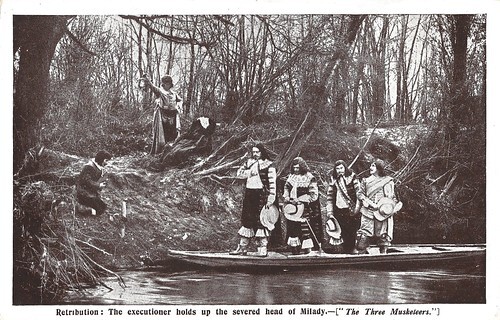
British postcard by J.F. Grimm & Co.. Photo: le Film d'Art. Sscene from the French silent film Les trois mousquetaires / The Three Musketeers (André Calmettes, Henri Pouctal, 1913). Caption: Retribution. The executioner holds up the severed head of Milady. We see the three musketeers ( Marcel Vibert , Adolphe Candé, Stellio) and D'Artagnan ( Émile Dehelly ) in the boat. Jean Duval played the executioner, and Nelly Cormon played Milady De Winter.
Ivo: "We already had French cards from Les trois mousquetaires (1913), but now a British card by J.F. Grimm & Co. has been added. Although several sources, including Wikipedia, write that the film was released in 1912, this is untrue. The film was first shown to Paris cinema owners and buyers in October 1913, before the film's general release. See also our French card for this scene at Flickr."
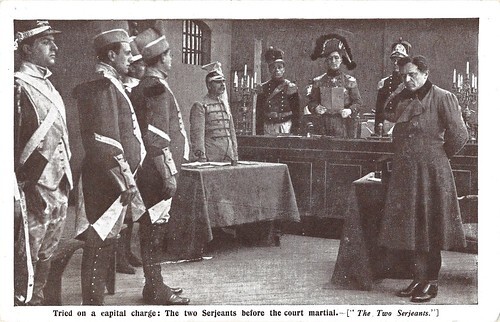
British postcard by J.F. Grimm & Co., London. Photo: Pasquali. Alberto Capozzi , Umberto Paradisi and Enrico Vidali in I due sergenti / The Two Sergeants (Eugenio Perego, 1913). Caption: Tried on a capital charge: The two Serjeants [Sergeants] before the court martial.
Ivo: "We already had a British card by J.F. Grimm & co. of the Italian silent film I due sergenti (Eugenio Perego, 1913), but now a second postcard has been added." The plot is about a Captain Derville (Capozzi) who is unjustly accused of theft and has to leave his wife and children and disguise himself as a peasant named William. Because of his bravery during the Napoleonic wars, he was appointed sergeant. He bonds with Sergeant Robert (Paradisi), but the jealous aide-de-camp Valmore (Giovanni Enrico Vidali), in love with Robert's fiancée Laura, plots to have both sergeants killed. When the two men transgress a quarantine in a time of plague, they are court-martialled, and William has to die. William begs to say goodbye once more to his wife and children. Robert sacrifices himself to die instead of he doesn't return; Valmore doesn't mind this proposal. The evil Valmore even plots to delay William's return, but in the nick of time, William returns, Robert is saved, and the evil plotter is unmasked and condemned himself.

French postcard for the French silent film Gigolette (Henri Pouctal, 1921), with Séphora Mossé, Andrée Lionel, Camille Bert and Charles de Rochefort.
Ivo: "The card is too blurred to identify the actors. The man could be Charles de Rochefort or Camille Bert. I can't place the scene either, the film was based on the eponymous novel by Pierre Decourcelle, which depicts prostitution in the city."
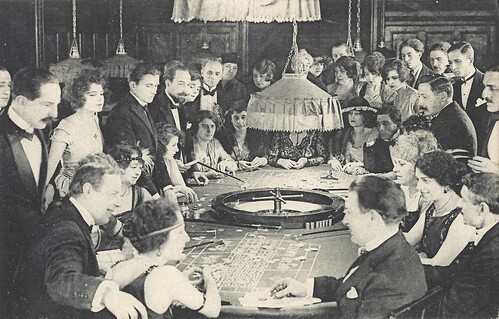
French postcard by M. Le Deley, Paris. Photo: Pathé Consortium Cinema. Scene from L'Empereur des pauvres / The Emperor of the Poor (René Leprince, 1922), an adaptation of the novel by Felicien Champsaur, starring Léon Mathot , Gina Relly and Henry Krauss . The man down right on this card could be Mathot.
Ivo: "The card depicts a scene from the French silent film serial L'empereur des pauvres (1921). I also found three cards with portraits that we didn't have yet. We will use these for a re-issue post on the film later."
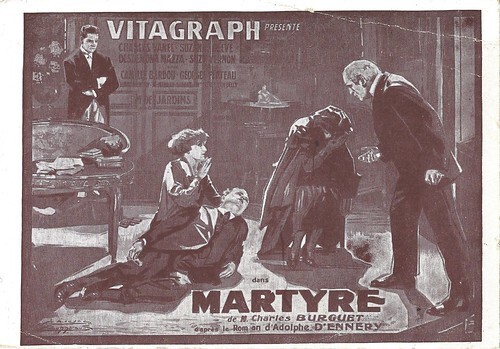
French postcard. Image: Vitagraph. Poster for the French silent film Martyre (Charles Burguet, 1927), with Charles Vanel , Suzanne Delvé, Desdemona Mazza , Suzy Vernon , Camille Bardou, Georges Flateau and Maxime Desjardins.
Ivo: "I found this poster card of Le Martyre (1927), strangely enough, with the word Vitagraph on it. Presumably, Vitagraph was the distributor of this French film. Director Charles Burguet made the last films with Suzanne Grandais. He was also in the car in which Grandais crashed."
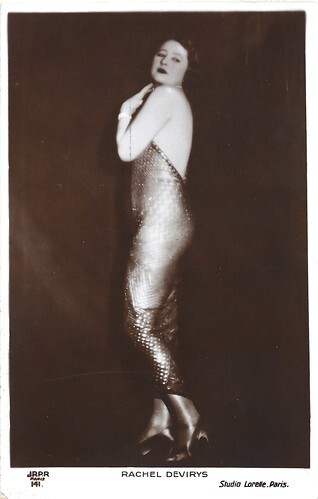
French postcard by J.R.P.R., Paris, no. 141. Photo: Studio Lorelle.
Ivo: "At least three of the next four cards are from JRPR: a sexy card of Rachel Devirys, François Rozet in Madame Recamier (a film with Marie Bell in the title role), Edith Jehanne in Tarakova (we also have a portrait with her in that film), and a portrait of Cecyl Tryan (the card's publisher is unknown, but the style is reminiscent of JRPR)." Rachel Devirys (1890-1983), born Rachel Itzkovitz in the Russian Empire, was a Franco-Russian actress. She started in French cinema from 1917 and is known for such films as Visages d'enfants (Jacques Feyder, 1923) with Jean Forest, Monte Carlo (Louis Mercanton, 1925) with Betty Balfour, Le berceau de dieu (Fred Leroy-Granville, 1926), and Croquette (Mercanton, 1928) again with Balfour. Devirys continued well into the sound era, with films such as Maternité (Jean Benoît-Lévy, 1930). One of her last parts was in Les enfants terribles (Jean-Pierre Melville, 1950).
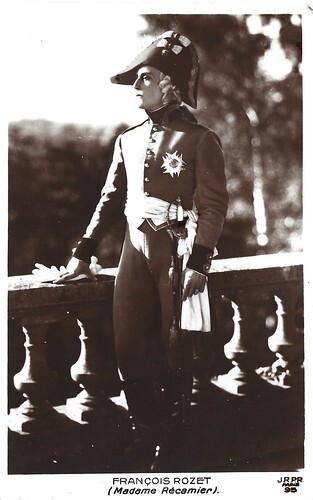
French postcard by J.R.P.R., Paris, no. 95. François Rozet as the Prince of Prussia in Madame Récamier (Tony Lekain, Gaston Ravel, 1928), starring Marie Bell and Emile Drain.
François Rozet (1899-1994) was a French stage and screen actor. He refused a contract with Paramount when he was in the US touring with a troupe of the Odeon. However, Rozet had an important career in French cinema, starting as Marius in Les Misérables (Henri Fescourt, 1925). His other major parts were in La Cousine Bette (Max de Rieux, 1927), La Glu (Henri Fescourt, 1927), Madame Récamier (Tony Lekain, Gaston Ravel, 1928), Minuit, place Pigalle (René Hervil, 1928), and Monte Cristo (Henri Fescourt, 1929). Rozet also played in the first French talking film, Les Trois Masques (André Hugon, 1929), about a rich man (Jean Toulout) whose son (Rozet) has made a poor woman (Renée Heribel) pregnant.
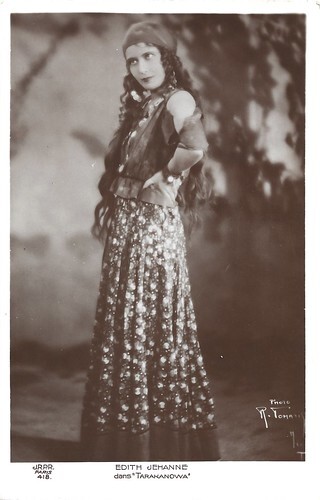
French postcard by J.R.P.R., Paris, no. 418. Édith Jéhanne in Tarakanova (Raymond Bernard, 1930). Photo: R. Tomarig, Nice.
Ivo: " Edith Jéhanne starred in the late silent film Tarakanova (1930) with Olaf Fjord. She played a female impostor who claims to be heir to the Russian throne. When the czarina (Paule Andral) sends her best aide (Fjord) to capture the girl, he falls in love with her. It was Raymond Bernard's last silent film, shot in 1929, but held back to be sonorised in 1930. Bernard considered it his best film, but no copy of the film ever showed up, so we can not judge for ourselves."
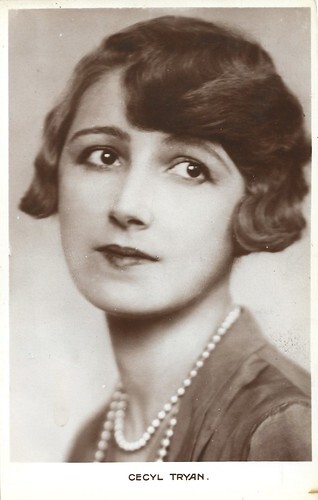
French postcard.
Ivo: "Franco-Italian actress Cecyl Tryan (1897-?) had a prolific career in the Italian silent cinema, from 1913 until the late 1920s. She first starred at Cines, later also at companies like Gladiator Film and Fert."
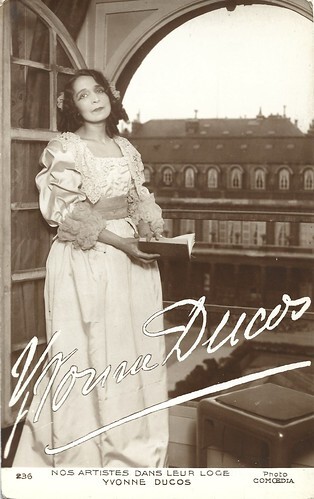
French postcard in the Series Nos artistes dans leur loge by Comoedia, no. 236. Yvonne Ducos (1887-1946) was a French stage actress who also acted in four films. The open window may be at the Comédie Française.
Ivo: "These four cards from Comoedia include three in the series Nos artistes dans leur loge and one from the series Nos artistes dans leurs expressions. According to Jean Ritsema, these are all continuous series, with increasing numbers. Yvette Ducos in front of, I think, an open window overlooking the square of the Comédie française, Lucienne Debrenne (her name is written wrong on the card; beautiful wallpaper on the wall) and the famous comedian Polin (admittedly elderly here). Number four is the comedian Urban, presumably in the operetta 'Phi-Phi', about the Greek sculptor Phidias."
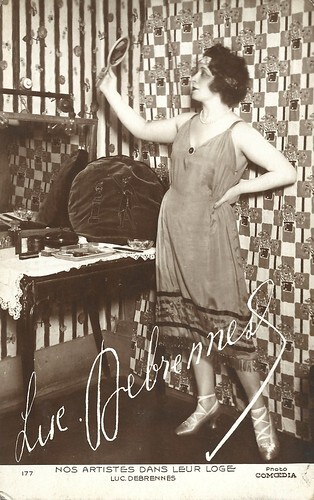
French postcard in the Series Nos artistes dans leur loge by Comoedia, no. 177. Lucienne Debrenne (without -s) was a French stage actress who acted, e.g. in the comedy 'La Fleur d’oranger', performed in 1924 at the Comédie-Caumartin (Paris). The leading actors were Gabriel Signoret, Mady Berry, Germaine Risse and Pierre Etchepare.
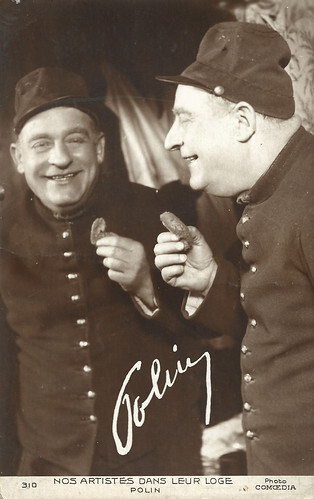
French postcard in the Series Nos artistes dans leur loge by Comoedia, no. 310. French comedian Polin (1863-1927) was one of the greatest stars of the café-concerts of Paris. His interpretations were sober and had nuance and finesse, which were rare in the café-concerts. From 1910 on, he also appeared in film and theatre, including Sacha Guitry's play 'Le Grand Duc' (The Grand Duke, 1921) with Lucien and Sacha Guitry, and Yvonne Printemps.
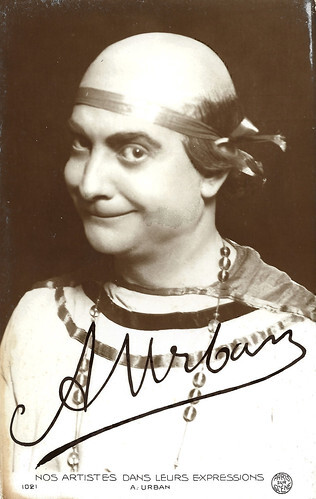
French postcard in the Series Nos Artistes Dans Leurs Expressions by Comoedia, no. 1021. Urban is dressed in his outfit from the operetta 'Phi-Phi' (1918).
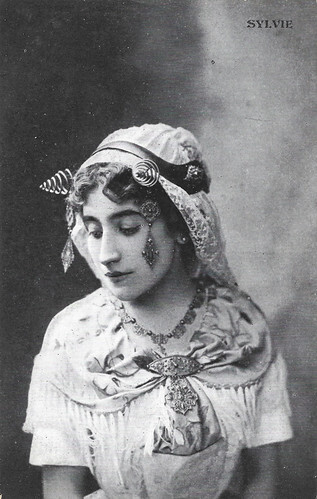
French postcard. We are not 100% sure this really is the French actress Sylvie , although she wore slightly similar attire when she acted in the stage play 'Vieil Heidelberg' around 1900.
Ivo: "The final cards are a bit of everything: a card of Sylvie (who doesn't look very much like the real Sylvie); Madeleine Roch in the play 'Les Burgraves' (1910); Alexander Moissi in 'Jedermann' (we already had a similar card); Boucot in the early sound film Arthur (1931; we already posted another card for the same film); and the card of Paul Swann, dancer, painter, “the most beautiful man in the world”, and a little bit actor too (we already postyed a scan of a card from the collection of Didier Hanson but now I have it myself)."

French postcard. Madeleine Roch (Comédie Française) as Guanhhumara in the stage play 'Les Burgraves' by Victor Hugo, performed on 3 July 1910, in Nissan.
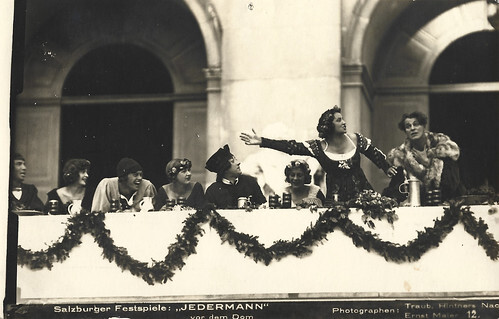
Austrian postcard by Traub, Salzburg. Photo: Ernst Maier (Atelier K. Hintner). Alexander Moissi as Jedermann in the stage production 'Jedermann' (Everyman) at the Salzburger Festspiele, performed before the Salzburg Dom (cathedral). Max Reinhardt directed Moissi in this production in 1919 and 1920, and from 1926 till 1931. Caption: Everyman in front of the cathedral.
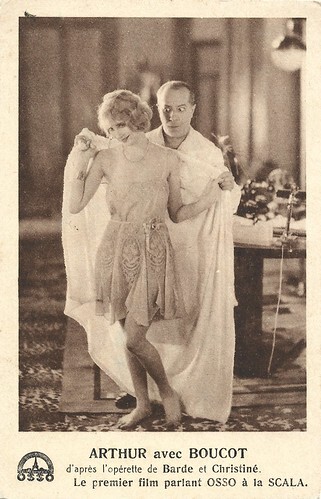
Belgian postcard by Ern. Thill, Bruxelles (Nels). Photo: R. Tomarif (?), Nice / Les Films Osso. Boucot in Arthur (Léonce Perret, made in 1930, released in 1931), shown at la Scala, and based on the operetta by Barde & Christiné. Louis-Jacques Boucot, aka Boucot (1882-1949), was a French stage and screen actor, famous for his comic characters of Pénard and Babylas.
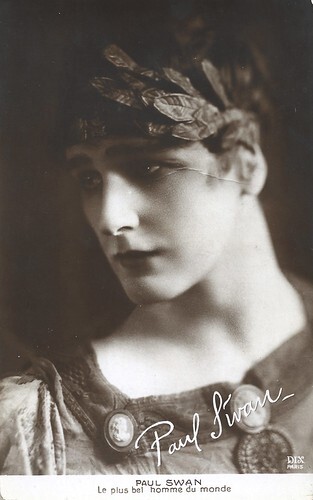
French postcard by Dix, Paris. Paul Swan (1883-1972) was an American dancer, painter, sculptor, poet and actor. A journalist once described him as "the most beautiful man in the world".

French postcard by Ed. Le Deley, Paris. Photo: Pathé Frères. Gaudin in Les Misérables (Albert Capellani, 1913), adapted from the famous novel by Victor Hugo. Caption: La mort de Gavroche (The Death of Gavroche).
During the June Revolution of 1832, young Gavroche (Gaudin), the son of the Thenardier couple, is killed while collecting bullets from deceased soldiers. On this card, he is shown as a revolutionary hero. This card is part of a booklet made by Le Deley with multiple portraits of the main actors and various scenes of the film. Ivo: " Very special was the book of cards from Les Misérables, the 1913 version. I already had one card from the series (Henri Krauss as Jean Valjean), but now we have an almost complete set of portraits and scenes. I watched a rather blurred version of the film on YouTube. In it, you can see quite well how good Krauss was as an actor, his restrained, strong acting. I also scanned a card with Etievant as Javert, but it was half out of focus, so I dropped it. So I selected the card of Gavroche at the barricades. We'll scan the whole series later and make a separate post for EFSP.

French postcard by Alterocca, no. 3916. Photo: Cinématograph Pathé. Scene from the early French film Guillaume Tell (Lucien Nonguet, 1903). Caption: Gessler furieux ordonne qui [que] Tell soit arrêté sur le champ (Infuriated, Gessler commands to arrest Tell on the spot).
Ivo: "This is the oldest card in my selection. I bought two additional cards from Guillaume Tell (1903) by Alterocca. We already had a few cards by Croissant and by Alterocca from the film. I am very happy with this addition. I selected one card for this post; the second will follow later.

French postcard for the Alhambra Cinéma Pathé Frères, St.-Etienne. Photo: Pathé Frères. Scene from the early French film Le bagne des gosses / Children's Reformatory (Charles Decroix, 1907).
Ivo: "I'm also happy with this card of Le bagne des gosses / Children's Reformatory (1907), a film I once catalogued in Overveen when I worked at Eye Filmmuseum's film archive. The film is reminiscent of Les Misérables: imprisonment for stealing a loaf of bread, but the escape from juvenile prison is also reminiscent of Truffaut's Les 400 coups, one of my favourite films. The postcard is from a series we already have many of, but this one is for a different cinema, the Alhambra in St Etienne. You can watch the full film, a tinted version with Dutch intertitles and English subtitles on YouTube."

British postcard by J.F. Grimm & Co.. Photo: le Film d'Art. Sscene from the French silent film Les trois mousquetaires / The Three Musketeers (André Calmettes, Henri Pouctal, 1913). Caption: Retribution. The executioner holds up the severed head of Milady. We see the three musketeers ( Marcel Vibert , Adolphe Candé, Stellio) and D'Artagnan ( Émile Dehelly ) in the boat. Jean Duval played the executioner, and Nelly Cormon played Milady De Winter.
Ivo: "We already had French cards from Les trois mousquetaires (1913), but now a British card by J.F. Grimm & Co. has been added. Although several sources, including Wikipedia, write that the film was released in 1912, this is untrue. The film was first shown to Paris cinema owners and buyers in October 1913, before the film's general release. See also our French card for this scene at Flickr."

British postcard by J.F. Grimm & Co., London. Photo: Pasquali. Alberto Capozzi , Umberto Paradisi and Enrico Vidali in I due sergenti / The Two Sergeants (Eugenio Perego, 1913). Caption: Tried on a capital charge: The two Serjeants [Sergeants] before the court martial.
Ivo: "We already had a British card by J.F. Grimm & co. of the Italian silent film I due sergenti (Eugenio Perego, 1913), but now a second postcard has been added." The plot is about a Captain Derville (Capozzi) who is unjustly accused of theft and has to leave his wife and children and disguise himself as a peasant named William. Because of his bravery during the Napoleonic wars, he was appointed sergeant. He bonds with Sergeant Robert (Paradisi), but the jealous aide-de-camp Valmore (Giovanni Enrico Vidali), in love with Robert's fiancée Laura, plots to have both sergeants killed. When the two men transgress a quarantine in a time of plague, they are court-martialled, and William has to die. William begs to say goodbye once more to his wife and children. Robert sacrifices himself to die instead of he doesn't return; Valmore doesn't mind this proposal. The evil Valmore even plots to delay William's return, but in the nick of time, William returns, Robert is saved, and the evil plotter is unmasked and condemned himself.

French postcard for the French silent film Gigolette (Henri Pouctal, 1921), with Séphora Mossé, Andrée Lionel, Camille Bert and Charles de Rochefort.
Ivo: "The card is too blurred to identify the actors. The man could be Charles de Rochefort or Camille Bert. I can't place the scene either, the film was based on the eponymous novel by Pierre Decourcelle, which depicts prostitution in the city."

French postcard by M. Le Deley, Paris. Photo: Pathé Consortium Cinema. Scene from L'Empereur des pauvres / The Emperor of the Poor (René Leprince, 1922), an adaptation of the novel by Felicien Champsaur, starring Léon Mathot , Gina Relly and Henry Krauss . The man down right on this card could be Mathot.
Ivo: "The card depicts a scene from the French silent film serial L'empereur des pauvres (1921). I also found three cards with portraits that we didn't have yet. We will use these for a re-issue post on the film later."

French postcard. Image: Vitagraph. Poster for the French silent film Martyre (Charles Burguet, 1927), with Charles Vanel , Suzanne Delvé, Desdemona Mazza , Suzy Vernon , Camille Bardou, Georges Flateau and Maxime Desjardins.
Ivo: "I found this poster card of Le Martyre (1927), strangely enough, with the word Vitagraph on it. Presumably, Vitagraph was the distributor of this French film. Director Charles Burguet made the last films with Suzanne Grandais. He was also in the car in which Grandais crashed."

French postcard by J.R.P.R., Paris, no. 141. Photo: Studio Lorelle.
Ivo: "At least three of the next four cards are from JRPR: a sexy card of Rachel Devirys, François Rozet in Madame Recamier (a film with Marie Bell in the title role), Edith Jehanne in Tarakova (we also have a portrait with her in that film), and a portrait of Cecyl Tryan (the card's publisher is unknown, but the style is reminiscent of JRPR)." Rachel Devirys (1890-1983), born Rachel Itzkovitz in the Russian Empire, was a Franco-Russian actress. She started in French cinema from 1917 and is known for such films as Visages d'enfants (Jacques Feyder, 1923) with Jean Forest, Monte Carlo (Louis Mercanton, 1925) with Betty Balfour, Le berceau de dieu (Fred Leroy-Granville, 1926), and Croquette (Mercanton, 1928) again with Balfour. Devirys continued well into the sound era, with films such as Maternité (Jean Benoît-Lévy, 1930). One of her last parts was in Les enfants terribles (Jean-Pierre Melville, 1950).

French postcard by J.R.P.R., Paris, no. 95. François Rozet as the Prince of Prussia in Madame Récamier (Tony Lekain, Gaston Ravel, 1928), starring Marie Bell and Emile Drain.
François Rozet (1899-1994) was a French stage and screen actor. He refused a contract with Paramount when he was in the US touring with a troupe of the Odeon. However, Rozet had an important career in French cinema, starting as Marius in Les Misérables (Henri Fescourt, 1925). His other major parts were in La Cousine Bette (Max de Rieux, 1927), La Glu (Henri Fescourt, 1927), Madame Récamier (Tony Lekain, Gaston Ravel, 1928), Minuit, place Pigalle (René Hervil, 1928), and Monte Cristo (Henri Fescourt, 1929). Rozet also played in the first French talking film, Les Trois Masques (André Hugon, 1929), about a rich man (Jean Toulout) whose son (Rozet) has made a poor woman (Renée Heribel) pregnant.

French postcard by J.R.P.R., Paris, no. 418. Édith Jéhanne in Tarakanova (Raymond Bernard, 1930). Photo: R. Tomarig, Nice.
Ivo: " Edith Jéhanne starred in the late silent film Tarakanova (1930) with Olaf Fjord. She played a female impostor who claims to be heir to the Russian throne. When the czarina (Paule Andral) sends her best aide (Fjord) to capture the girl, he falls in love with her. It was Raymond Bernard's last silent film, shot in 1929, but held back to be sonorised in 1930. Bernard considered it his best film, but no copy of the film ever showed up, so we can not judge for ourselves."

French postcard.
Ivo: "Franco-Italian actress Cecyl Tryan (1897-?) had a prolific career in the Italian silent cinema, from 1913 until the late 1920s. She first starred at Cines, later also at companies like Gladiator Film and Fert."

French postcard in the Series Nos artistes dans leur loge by Comoedia, no. 236. Yvonne Ducos (1887-1946) was a French stage actress who also acted in four films. The open window may be at the Comédie Française.
Ivo: "These four cards from Comoedia include three in the series Nos artistes dans leur loge and one from the series Nos artistes dans leurs expressions. According to Jean Ritsema, these are all continuous series, with increasing numbers. Yvette Ducos in front of, I think, an open window overlooking the square of the Comédie française, Lucienne Debrenne (her name is written wrong on the card; beautiful wallpaper on the wall) and the famous comedian Polin (admittedly elderly here). Number four is the comedian Urban, presumably in the operetta 'Phi-Phi', about the Greek sculptor Phidias."

French postcard in the Series Nos artistes dans leur loge by Comoedia, no. 177. Lucienne Debrenne (without -s) was a French stage actress who acted, e.g. in the comedy 'La Fleur d’oranger', performed in 1924 at the Comédie-Caumartin (Paris). The leading actors were Gabriel Signoret, Mady Berry, Germaine Risse and Pierre Etchepare.

French postcard in the Series Nos artistes dans leur loge by Comoedia, no. 310. French comedian Polin (1863-1927) was one of the greatest stars of the café-concerts of Paris. His interpretations were sober and had nuance and finesse, which were rare in the café-concerts. From 1910 on, he also appeared in film and theatre, including Sacha Guitry's play 'Le Grand Duc' (The Grand Duke, 1921) with Lucien and Sacha Guitry, and Yvonne Printemps.

French postcard in the Series Nos Artistes Dans Leurs Expressions by Comoedia, no. 1021. Urban is dressed in his outfit from the operetta 'Phi-Phi' (1918).

French postcard. We are not 100% sure this really is the French actress Sylvie , although she wore slightly similar attire when she acted in the stage play 'Vieil Heidelberg' around 1900.
Ivo: "The final cards are a bit of everything: a card of Sylvie (who doesn't look very much like the real Sylvie); Madeleine Roch in the play 'Les Burgraves' (1910); Alexander Moissi in 'Jedermann' (we already had a similar card); Boucot in the early sound film Arthur (1931; we already posted another card for the same film); and the card of Paul Swann, dancer, painter, “the most beautiful man in the world”, and a little bit actor too (we already postyed a scan of a card from the collection of Didier Hanson but now I have it myself)."

French postcard. Madeleine Roch (Comédie Française) as Guanhhumara in the stage play 'Les Burgraves' by Victor Hugo, performed on 3 July 1910, in Nissan.

Austrian postcard by Traub, Salzburg. Photo: Ernst Maier (Atelier K. Hintner). Alexander Moissi as Jedermann in the stage production 'Jedermann' (Everyman) at the Salzburger Festspiele, performed before the Salzburg Dom (cathedral). Max Reinhardt directed Moissi in this production in 1919 and 1920, and from 1926 till 1931. Caption: Everyman in front of the cathedral.

Belgian postcard by Ern. Thill, Bruxelles (Nels). Photo: R. Tomarif (?), Nice / Les Films Osso. Boucot in Arthur (Léonce Perret, made in 1930, released in 1931), shown at la Scala, and based on the operetta by Barde & Christiné. Louis-Jacques Boucot, aka Boucot (1882-1949), was a French stage and screen actor, famous for his comic characters of Pénard and Babylas.

French postcard by Dix, Paris. Paul Swan (1883-1972) was an American dancer, painter, sculptor, poet and actor. A journalist once described him as "the most beautiful man in the world".
Published on May 26, 2025 22:00
May 25, 2025
Sonja Sutter
German film actress Sonja Sutter (1931–2017) was one of the few actors who was allowed to appear in productions in both East and West Germany. She is remembered for DEFA films like Lissy (1957), her role as Fraulein Rottenmeier in the German TV series Heidi (1978) and for several roles in the TV series Derrick (1983-1998).
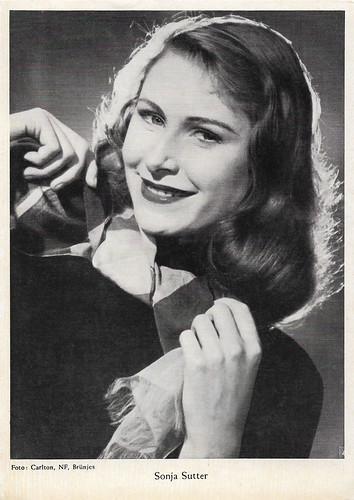
German collectors card by Helmstedter Margarinewerk GMBH, Helmstedt. Photo: Carlton / NF / Brünjes. Sonja Sutter in Meines Vaters Pferde, 1. Teil - Lena und Nicoline/My Father's Horses (Gerhard Lamprecht, 1954). Gift by Didier Hanson.
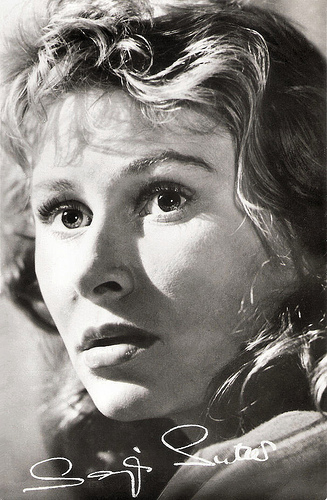
German postcard by VEB Progress Film-Vertrieb, no. 95/411, 1958. Photo: DEFA / Meister. Sonja Sutter in Lissy (Konrad Wolf, 1957).
Destinies of women
Sonja Ingrid Emilie Hanna Sutter was born in Freiburg, Germany, in 1931. She attended the Rudolf Steiner School in Freiburg but because of the war, she ended it with only a limited education. However, she later studied Greek and Latin.
At that time, she decided to become an actress. Her stage debut was in 1950 at the Municipal Theatre in Freiburg. Later she worked in Stuttgart, at the Schauspielhaus in Hamburg and at the State Theatre in Munich.
DEFA director Slatan Dudow discovered her when he saw her in test shots for a film by and with Luis Trenker . Dudow engaged Sutter in the role of Renate Ludwig in the film Frauenschicksale/Destinies of Women (Slatan Dudow, 1952). Four women are looking for happiness and a good man in the divided city. Their destinies are loosely connected through one person: the West Berlin dandy and womaniser, Conny.
Released at the peak of East German cultural and political dogmatism, the film was heavily critiqued, especially by female party leaders who objected that its portrayal of the four women did not represent the qualities that characterised women in the new society. Now considered a richly contradictory work, Frauenschicksale/Destinies of Women represents an encore production by the creative team of Slatan Dudow, Hanns Eisler and Bertolt Brecht which also made Kuhle Wampe/To Whom Does the World Belong? (Slatan Dudow, 1932).
After her debut, many film offers came from West Germany and Sutter was thus one of the few artists of her time, who worked on the two German territories. During the 1950s Sutter starred in films like Die Barrings/The Barrings (Rolf Thiele, 1955) with Dieter Borsche , Star mit fremden Federn/Star With Strange Feathers (Harald Mannl, 1955), and the Heimat films Das Schweigen im Walde/Silence of the Forest (Helmut Weiss, 1955), Drei Birken auf der Heide/Three Birches on the Heath (Ulrich Erfurth, 1956) opposite Margit Saad , and Johannisnacht/St. John's Eve (Harald Reinl, 1956).
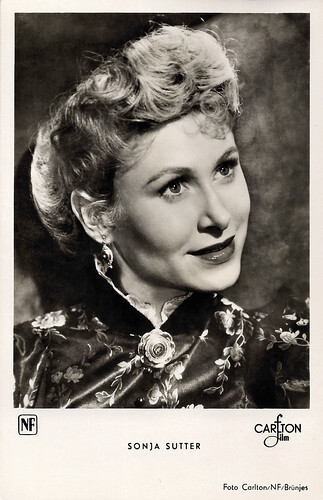
West German postcard by Kunst und Bild, Berlin, no. A 998. Photo: Carlton / NF / Brünjes. Sonja Sutter in Meines Vaters Pferde/My Father's Horses (Gerhard Lamprecht, 1954).
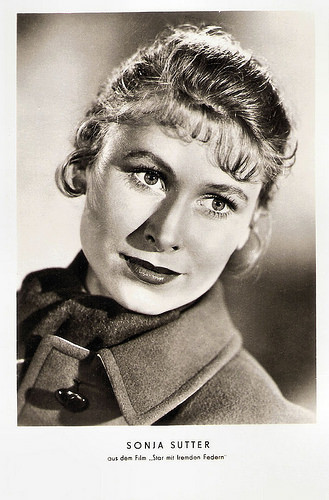
German postcard by VEB Volkskunstverlag Reichenbach i.V., no. G 574, 1956. Photo: Kroiss.
Big breakthrough at the DEFA
Sonja Sutter’s big breakthrough came in 1957 with the East-German production Lissy (Konrad Wolf, 1957), an award-winning film, which gave Sutter a certain fame in East Germany. Lissy is a story about the rise of Nazism based on a novel by German-Jewish author F.C. Weiskopf who managed to survive by fleeing to the USA.
Soon followed more DEFA productions including Tatort Berlin/Crime Scene Berlin (Joachim Kunert, 1958) with Annegret Golding, Sie kannten sich alle/They All Knew Each Other (Richard Groschopp, 1958), and Der Lotterieschwede (Joachim Kunert, 1958) with Erwin Geschonneck.
In 1959 Sutter was engaged by the Burgtheater in Vienna. With the construction of the Berlin Wall in 1961, she lost the opportunity to participate in further DEFA films. From 1961, she also appeared regularly at the Salzburger Festspiele in plays like Jedermann (Everyman) by the Austrian playwright Hugo von Hofmannsthal. She has played in 16 TV films and she had many appearances in popular German TV series like Der Kommissar, Tatort and Derrick. In Derrick, she played in 6 episodes from 1983 to 1998.
Among her later feature films was the Austrian drama Ich will leben/I Want to Live (Jörg A. Eggers, 1976) with Heinz Bennent, and the Henrik Ibsen adaptation Die Wildente/The Wild Duck (Hans W. Geissendörfer, 1976) with Bruno Ganz . She is best remembered for her role as Fraulein Rottenmeier in the German TV series Heidi (1978). This series aired in many countries in Europe during the 1980s and 1990s and was dubbed into several languages.
But Sutter’s main focus was on her stage work for the Burgtheater. She played more than 70 roles there until her retirement in 1997. Sonja Sutter died in 2017 in a residence for older artists in Baden. She was 86. Sutter was married to a doctor and had a daughter, the actress Carolin Fink.
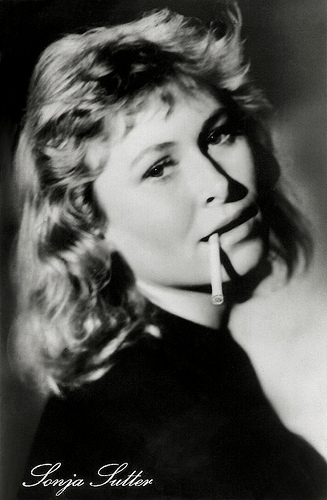
German postcard by VEB Progress Film-Vertrieb, no. 661, 1958. Photo: DEFA / Dührkoop. Publicity still for Lissy (Konrad Wolf, 1957).
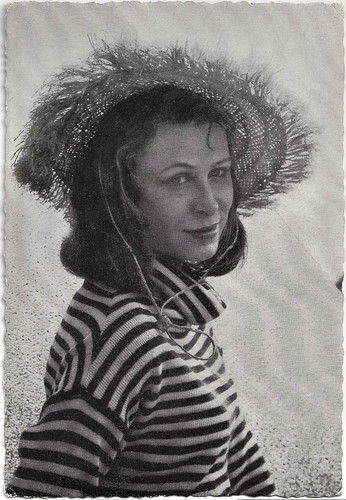
West German postcard by WS-Druck, Wanne-Eickel, no. 169. Photo: Theo Huster.
Trailer Frauenschicksale/Destinies of Women (Slatan Dudow, 1952). Source: DEFA-Stiftung (YouTube).
Sources: Wien.orf.at, Wikipedia (German and English), and .

German collectors card by Helmstedter Margarinewerk GMBH, Helmstedt. Photo: Carlton / NF / Brünjes. Sonja Sutter in Meines Vaters Pferde, 1. Teil - Lena und Nicoline/My Father's Horses (Gerhard Lamprecht, 1954). Gift by Didier Hanson.

German postcard by VEB Progress Film-Vertrieb, no. 95/411, 1958. Photo: DEFA / Meister. Sonja Sutter in Lissy (Konrad Wolf, 1957).
Destinies of women
Sonja Ingrid Emilie Hanna Sutter was born in Freiburg, Germany, in 1931. She attended the Rudolf Steiner School in Freiburg but because of the war, she ended it with only a limited education. However, she later studied Greek and Latin.
At that time, she decided to become an actress. Her stage debut was in 1950 at the Municipal Theatre in Freiburg. Later she worked in Stuttgart, at the Schauspielhaus in Hamburg and at the State Theatre in Munich.
DEFA director Slatan Dudow discovered her when he saw her in test shots for a film by and with Luis Trenker . Dudow engaged Sutter in the role of Renate Ludwig in the film Frauenschicksale/Destinies of Women (Slatan Dudow, 1952). Four women are looking for happiness and a good man in the divided city. Their destinies are loosely connected through one person: the West Berlin dandy and womaniser, Conny.
Released at the peak of East German cultural and political dogmatism, the film was heavily critiqued, especially by female party leaders who objected that its portrayal of the four women did not represent the qualities that characterised women in the new society. Now considered a richly contradictory work, Frauenschicksale/Destinies of Women represents an encore production by the creative team of Slatan Dudow, Hanns Eisler and Bertolt Brecht which also made Kuhle Wampe/To Whom Does the World Belong? (Slatan Dudow, 1932).
After her debut, many film offers came from West Germany and Sutter was thus one of the few artists of her time, who worked on the two German territories. During the 1950s Sutter starred in films like Die Barrings/The Barrings (Rolf Thiele, 1955) with Dieter Borsche , Star mit fremden Federn/Star With Strange Feathers (Harald Mannl, 1955), and the Heimat films Das Schweigen im Walde/Silence of the Forest (Helmut Weiss, 1955), Drei Birken auf der Heide/Three Birches on the Heath (Ulrich Erfurth, 1956) opposite Margit Saad , and Johannisnacht/St. John's Eve (Harald Reinl, 1956).

West German postcard by Kunst und Bild, Berlin, no. A 998. Photo: Carlton / NF / Brünjes. Sonja Sutter in Meines Vaters Pferde/My Father's Horses (Gerhard Lamprecht, 1954).

German postcard by VEB Volkskunstverlag Reichenbach i.V., no. G 574, 1956. Photo: Kroiss.
Big breakthrough at the DEFA
Sonja Sutter’s big breakthrough came in 1957 with the East-German production Lissy (Konrad Wolf, 1957), an award-winning film, which gave Sutter a certain fame in East Germany. Lissy is a story about the rise of Nazism based on a novel by German-Jewish author F.C. Weiskopf who managed to survive by fleeing to the USA.
Soon followed more DEFA productions including Tatort Berlin/Crime Scene Berlin (Joachim Kunert, 1958) with Annegret Golding, Sie kannten sich alle/They All Knew Each Other (Richard Groschopp, 1958), and Der Lotterieschwede (Joachim Kunert, 1958) with Erwin Geschonneck.
In 1959 Sutter was engaged by the Burgtheater in Vienna. With the construction of the Berlin Wall in 1961, she lost the opportunity to participate in further DEFA films. From 1961, she also appeared regularly at the Salzburger Festspiele in plays like Jedermann (Everyman) by the Austrian playwright Hugo von Hofmannsthal. She has played in 16 TV films and she had many appearances in popular German TV series like Der Kommissar, Tatort and Derrick. In Derrick, she played in 6 episodes from 1983 to 1998.
Among her later feature films was the Austrian drama Ich will leben/I Want to Live (Jörg A. Eggers, 1976) with Heinz Bennent, and the Henrik Ibsen adaptation Die Wildente/The Wild Duck (Hans W. Geissendörfer, 1976) with Bruno Ganz . She is best remembered for her role as Fraulein Rottenmeier in the German TV series Heidi (1978). This series aired in many countries in Europe during the 1980s and 1990s and was dubbed into several languages.
But Sutter’s main focus was on her stage work for the Burgtheater. She played more than 70 roles there until her retirement in 1997. Sonja Sutter died in 2017 in a residence for older artists in Baden. She was 86. Sutter was married to a doctor and had a daughter, the actress Carolin Fink.

German postcard by VEB Progress Film-Vertrieb, no. 661, 1958. Photo: DEFA / Dührkoop. Publicity still for Lissy (Konrad Wolf, 1957).

West German postcard by WS-Druck, Wanne-Eickel, no. 169. Photo: Theo Huster.
Trailer Frauenschicksale/Destinies of Women (Slatan Dudow, 1952). Source: DEFA-Stiftung (YouTube).
Sources: Wien.orf.at, Wikipedia (German and English), and .
Published on May 25, 2025 22:00
May 24, 2025
Photo by Herb Ritts
Herb Ritts (1952-2002) was an American photographer and director known for his photographs of actors, models, and other celebrities throughout the 1980s and 1990s. His work concentrated on black and white photography and portraits, often in the style of classical Greek sculpture, which emphasized the human shape.
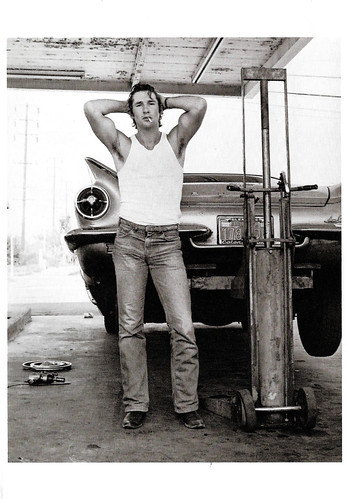
American postcard by Fotofolio, N.Y., N.Y. Photo: Herb Ritts. Caption: Richard Gere , San Bernardino, 1979. Courtesy Fahey / Klein Gallery Los Angeles. Proceeds of the sale of this card benefit The American Foundation For Aids Research.
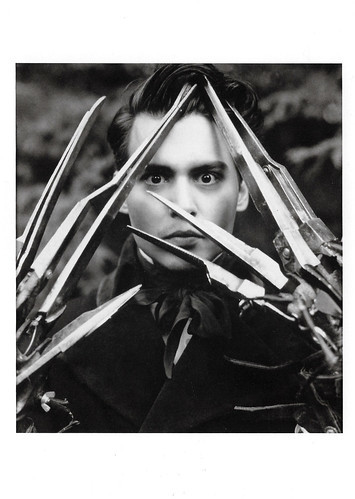
American postcard by Fotofolio, no. F829. Photo: Herb Ritts. Johnny Depp in Edward Scissorhands (Tim Burton, 1990).
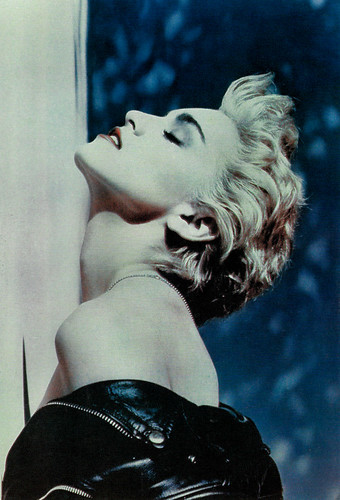
American postcard Classico, San Francisco /Winterland Productions / Rock Express, no. 460-053. Photo: Herb Ritts / Boy Toy Inc., 1991. Madonna , True Blue, 1986.
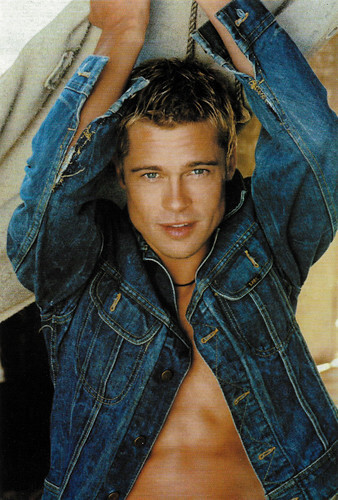
British postcard by Music Factory, no. 069. Photo: Herb Ritts. Brad Pitt .
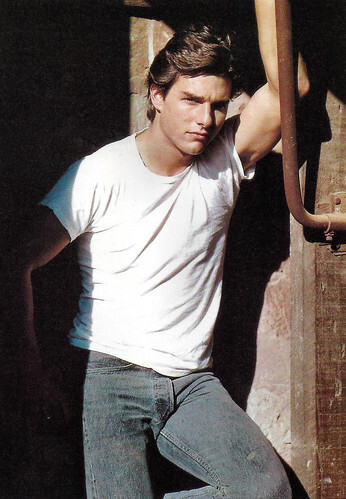
French postcard by Editions SPK, Réf. 264. Photo: Herb Ritts. Tom Cruise .
Turning the gods and goddesses of the moment into the icons next door
Herbert Ritts Jr. was born in 1952 in Brentwood, Los Angeles. His father, Herb Ritts Sr. (née Rittigstein), was a furniture designer, and his mother, Shirley Ritts (née Roos), was an interior designer. Together, their furniture business helped to popularise rattan furniture in the 1950s and 1960s.
Raised in an affluent Jewish family, Herb and his three younger siblings lived next door to actor Steve McQueen , whom he considered to be "like a second father". At his bar mitzvah, his father gifted him with a Kodak Brownie camera. He attended Palisades High School and moved to upstate New York in 1972 to study at Bard College, where he received a degree in economics with a minor in art history. Upon graduation in 1974 or 1975 (sources differ), he moved back to California to work as a sales representative in the family business, Ritts Co.
Herb bought his second camera for a vacation in 1976, a 35mm Miranda DX-3. In 1978, while living in Los Angeles, he became interested in photography when he and buddy Richard Gere went for a ride in the California desert. A tire blew somewhere near San Bernardino. To kill time while in a local garage getting the car fixed, Ritts started shooting Gere with his camera. In his white tank top, with long hair and cigarette dangling, Gere could have been a mechanic. A few months later, with three film roles quickly making him famous, Gere’s publicist asked for the pictures. The garage photos appeared in several magazines throughout Europe and the U.S., including Mademoiselle, Vogue and Esquire, which ran them under the headline 'The Beefcake Boys'.
Ritts, then 27, was suddenly a published portrait photographer. His first assignment was for Italian Harper's Bazaar. Ritts enlisted his roommate, a successful model named Matt Collins, for the shoot. The pair spent two days in the diffuse natural light beneath the Santa Monica Pier photographing the clothes, and the pictures were published. Collins also introduced Ritts to photographer Bruce Weber. Weber helped Ritts with contacts at fashion magazines and became Ritts’ mentor.
In 1981, he photographed Brooke Shields for a cover of Elle, and he photographed Olivia Newton-John for her 'Physical' album. Five years later, he replicated that cover pose with Madonna for her release, 'True Blue' (1986). That year, he photographed Tina Turner for the album 'Break Every Rule'. Bill Sharpsteen in Los Angeles Times: "His mostly black-and-white portraits of the glorified among us are shot with a facile eye for simplicity and style. They often are deceptively casual, sometimes ironic, stripped bare of backgrounds and occasionally clothes. They look like lucky shots of our friends on a good day, without the outlandish staging of David LaChapelle or the edginess of Annie Leibovitz. Ritts instead turns the gods and goddesses of the moment into the icons next door".
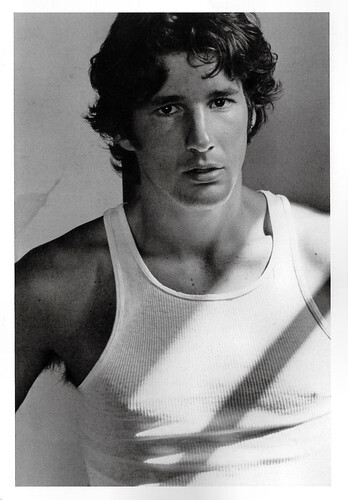
American postcard by Fotofolio, no. F838. Photo: Herb Ritts. Caption: Richard Gere , San Bernardino, 1977.
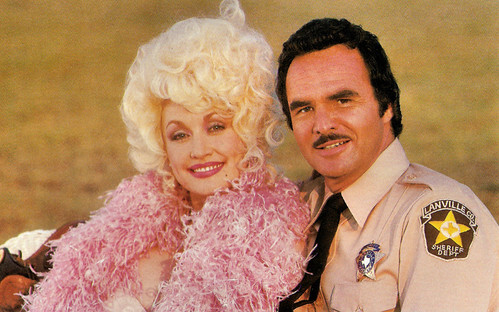
American postcard by Coral-Lee, Rancho Cordova, CA, in the Personality series, no. 115. Photo: Herb Ritts / Contact. Dolly Parton and Burt Reynolds in The Best Little Whorehouse in Texas (1982).
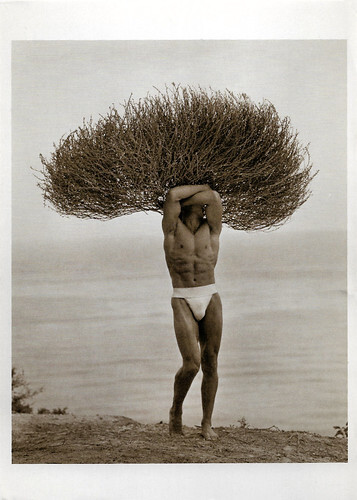
American postcard by Fotofolio, NY, NY, no. HR3. Photo: Herb Ritts. Caption: Male with Tumbleweed, Paradise Cove, California, 1985.
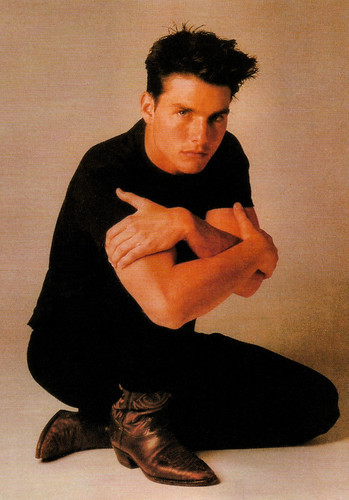
British postcard by Box Office, no. BOPC 3038. Photo: Herb Ritts, 1986. Tom Cruise .
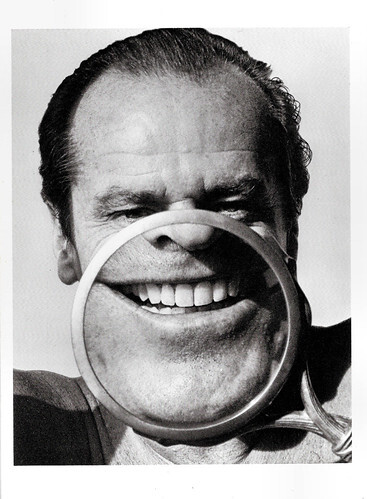
American postcard by Fotofolio, NY, NY, no. HR8. Photo: Herb Ritts. Caption: Jack Nicholson , Los Angeles, 1986.

American postcard by Fotofolio, N.Y., N.Y., no HR 2. Photo: Herb Ritts. Caption: Pee-wee Herman on Mulholland Drive, Los Angeles, 1987.
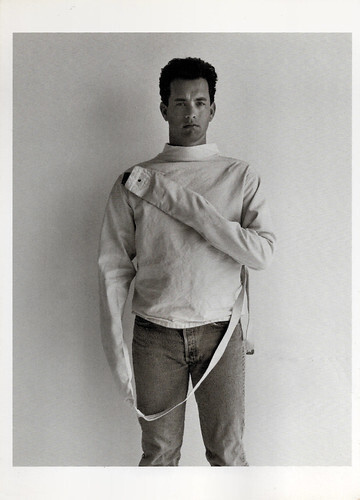
American postcard by Fotofolio, NY, NY, no HR69. Photo: Herb Ritts. Caption: Tom Hanks , Hollywood, 1988. From the book 'Notorious'.
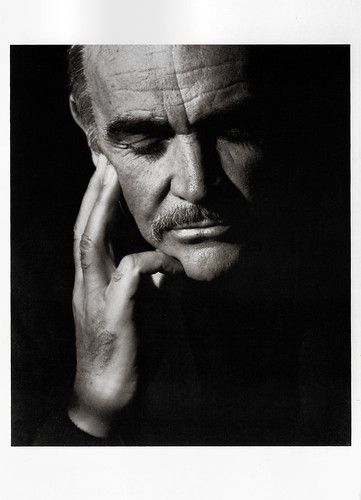
American postcard by Fotofolio, New York, N.Y., no. HR 62. Photo: Herb Ritts. Caption: Sean Connery , Hollywood, 1989.
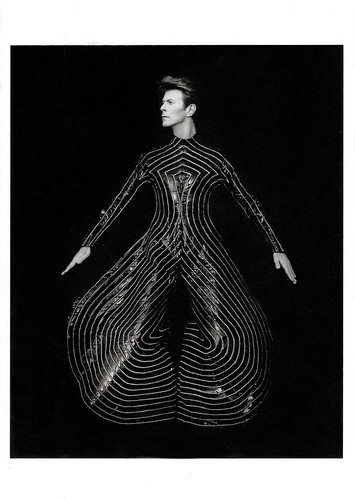
American postcard by Fotofolio, N.Y., N.Y., no HR81. Photo: Herb Ritts. Caption: David Bowie , Hollywood, 1989. From the book, 'Notorious'. Proceeds from the sale of this card benefit the American Foundation for Aids Research.
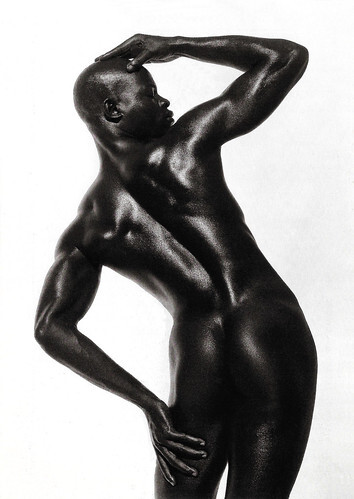
American postcard by Fotofolio, no. F 419. Photo: Herb Ritts. Caprion: Djimon (Hounsou), Three-quarter nude, Profile, Hollywood, 1989.
Lasting, memorable images derided as mere celebrity posters with no deeper artistic value
During the 1980s and 1990s, Herb Ritts photographed celebrities in various locales throughout California. He also took fashion and nude photographs of models Naomi Campbell, Stephanie Seymour, Tatjana Patitz, Christy Turlington, and Cindy Crawford. Ritts' work with them ushered in the 1990s era of the supermodel.
For Per Lui magazine, he made a spread called 'The Boys of the Body Shop' (1985). Ritts was assigned to photograph men’s raincoats but instead took his models to a gas station at Highland and Willoughby. He dressed them in vintage jeans, overalls and a few chains rented from Western Costumes. The best-known result of this slightly homoerotic tableau was 'Fred With Tires', featuring model Fred Harding holding two Winston tires in his muscular arms. Ritts also worked for Interview, Esquire, Mademoiselle, Glamour, GQ, Newsweek, Harper's Bazaar, Rolling Stone, Time, Vogue, Allure, Vanity Fair, Details, and Elle.
Ritts had an exclusive contract with publisher Conde Nast said to be worth about $1 million a year. As a fashion photographer, he worked for Calvin Klein, Ralph Lauren, Chanel, Revlon and Giorgio Armani, earning some $40,000 a day plus another $40,000 or so for usage rights. Film studios such as Paramount and Warner Bros. hired him for movie advertising. Ritts took publicity portraits for the films Batman (Tim Burton, 1989), Batman Forever (Joel Schumacher, 1995), and Batman & Robin (Joel Schumacher, 1997), which appeared on magazine covers and merchandise. He published books on photography for various fashion designers.
He made several classic photographs: Julia Roberts in her boyfriend’s skivvies, Madonna clutching her crotch, a cross-dressing Cindy Crawford, a paralysed Christopher Reeve and a post-brain surgery Elizabeth Taylor . He persuaded Madonna to pose with Minnie Mouse ears, and he immortalised Jim Carrey with a mermaid's tail. Ben Sharpsteen: "Ritts also has created remarkable portraits of Ronald Reagan , Tom Cruise , Stephen Hawking, the Dalai Lama and Monica Lewinsky at the height of her fame. They’re lasting, memorable images, and yet some have derided them as mere celebrity posters with no deeper artistic value."
From 1996 to 1997, Ritts' work was displayed at the Boston Museum of Fine Arts in Boston, attracting more than 250,000 people to the exhibit. In 2003, a solo exhibition was held at the Daimaru Museum in Kyoto, Japan. Herb Ritts was openly gay. He was in a relationship with entertainment lawyer Erik Hyman from 1996 until he died in 2002. His parents were accepting and supportive of his sexuality. Ritts was HIV-positive. He was first diagnosed in 1989 and used alternative herbal treatments to fight his condition. He never publicly disclosed his diagnosis. In 2002, Herb Ritts died in Los Angeles from pneumonia at the age of 50.
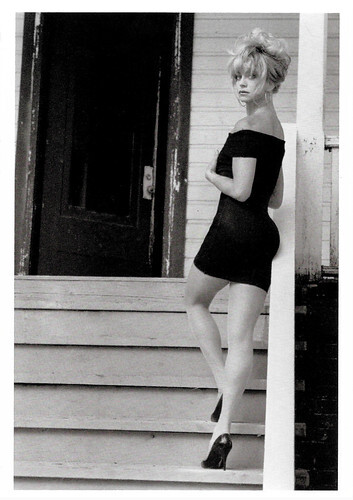
American postcard by Fotofolio, NY, NY, no. HR67. Photo: Herb Ritts. Caption: Goldie Hawn, Vancouver, 1989.
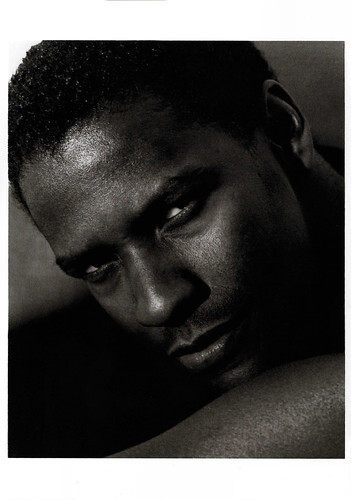
American postcard by Fotofolio, NY, NY, no. HR70. Photo: Herb Ritts. Caption: Denzel Washington, Hollywood, 1990.
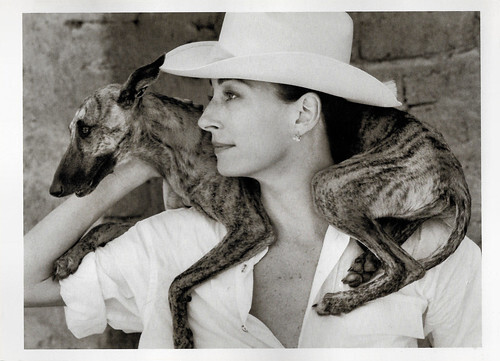
American postcard by Fotofolio, NY, NY, no. HR72. Photo: Herb Ritts. Caption: Anjelica Huston, Visalia, 1990.
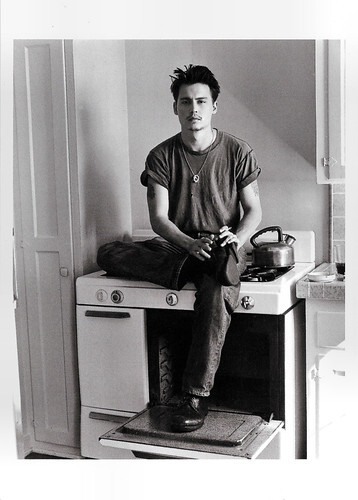
American postcard by Fotofolio, no. F430. Photo: Herb Ritts. Caption: Johnny Depp , Los Angeles, 1990.
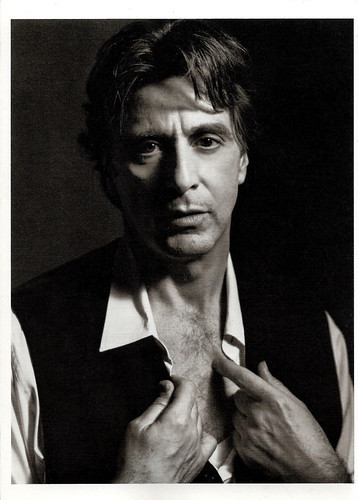
American postcard by Fotofolio, NY, NY, no. HR 73. Photo: Herb Ritts. Caption: Al Pacino , New York City, 1992.
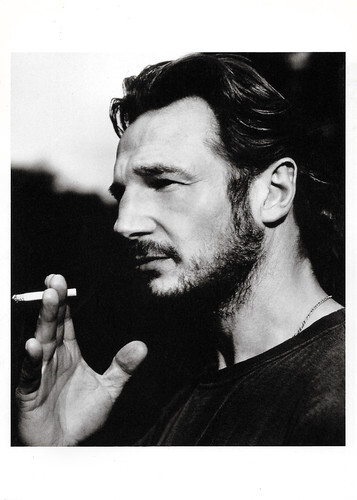
American postcard by Fotofolio, no. F831. Photo: Herb Ritts. Caption: Liam Neeson , Scotland, 1994.
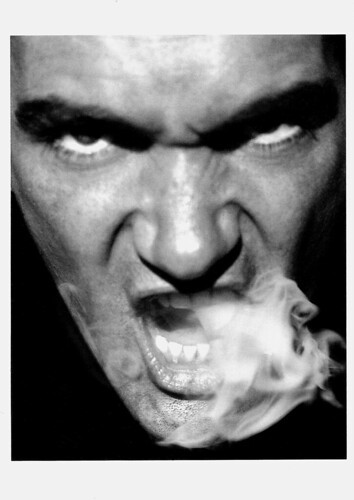
American postcard by Fotofolio. Photo: Herb Ritts, 1994. Antonio Banderas .
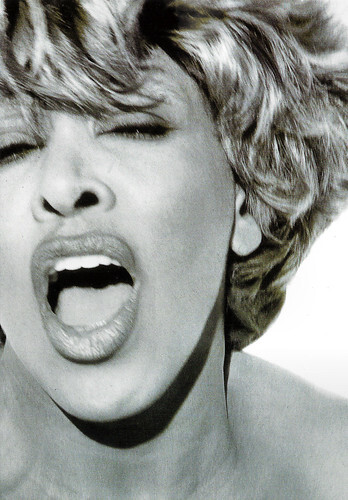
Italian freecard by Promocards Kultural for Roma Palazzo della Espozioni, no. PC 2100. Photo: Herb Ritts. Tina Turner.
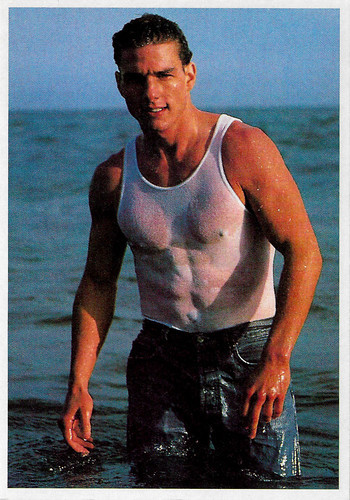
French postcard, Réf. 525. Photo: Herb Ritts. Tom Cruise .
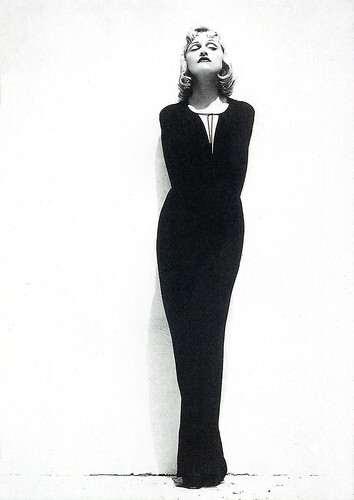
Dutch postcard by Verkerke Postcard, no. 30248. Photo: Herb Ritts / Boy Toy Inc. Madonna.
Source: Bill Sharpsteen (Los Angeles Times), Wikipedia (English and Dutch) and .

American postcard by Fotofolio, N.Y., N.Y. Photo: Herb Ritts. Caption: Richard Gere , San Bernardino, 1979. Courtesy Fahey / Klein Gallery Los Angeles. Proceeds of the sale of this card benefit The American Foundation For Aids Research.

American postcard by Fotofolio, no. F829. Photo: Herb Ritts. Johnny Depp in Edward Scissorhands (Tim Burton, 1990).

American postcard Classico, San Francisco /Winterland Productions / Rock Express, no. 460-053. Photo: Herb Ritts / Boy Toy Inc., 1991. Madonna , True Blue, 1986.

British postcard by Music Factory, no. 069. Photo: Herb Ritts. Brad Pitt .

French postcard by Editions SPK, Réf. 264. Photo: Herb Ritts. Tom Cruise .
Turning the gods and goddesses of the moment into the icons next door
Herbert Ritts Jr. was born in 1952 in Brentwood, Los Angeles. His father, Herb Ritts Sr. (née Rittigstein), was a furniture designer, and his mother, Shirley Ritts (née Roos), was an interior designer. Together, their furniture business helped to popularise rattan furniture in the 1950s and 1960s.
Raised in an affluent Jewish family, Herb and his three younger siblings lived next door to actor Steve McQueen , whom he considered to be "like a second father". At his bar mitzvah, his father gifted him with a Kodak Brownie camera. He attended Palisades High School and moved to upstate New York in 1972 to study at Bard College, where he received a degree in economics with a minor in art history. Upon graduation in 1974 or 1975 (sources differ), he moved back to California to work as a sales representative in the family business, Ritts Co.
Herb bought his second camera for a vacation in 1976, a 35mm Miranda DX-3. In 1978, while living in Los Angeles, he became interested in photography when he and buddy Richard Gere went for a ride in the California desert. A tire blew somewhere near San Bernardino. To kill time while in a local garage getting the car fixed, Ritts started shooting Gere with his camera. In his white tank top, with long hair and cigarette dangling, Gere could have been a mechanic. A few months later, with three film roles quickly making him famous, Gere’s publicist asked for the pictures. The garage photos appeared in several magazines throughout Europe and the U.S., including Mademoiselle, Vogue and Esquire, which ran them under the headline 'The Beefcake Boys'.
Ritts, then 27, was suddenly a published portrait photographer. His first assignment was for Italian Harper's Bazaar. Ritts enlisted his roommate, a successful model named Matt Collins, for the shoot. The pair spent two days in the diffuse natural light beneath the Santa Monica Pier photographing the clothes, and the pictures were published. Collins also introduced Ritts to photographer Bruce Weber. Weber helped Ritts with contacts at fashion magazines and became Ritts’ mentor.
In 1981, he photographed Brooke Shields for a cover of Elle, and he photographed Olivia Newton-John for her 'Physical' album. Five years later, he replicated that cover pose with Madonna for her release, 'True Blue' (1986). That year, he photographed Tina Turner for the album 'Break Every Rule'. Bill Sharpsteen in Los Angeles Times: "His mostly black-and-white portraits of the glorified among us are shot with a facile eye for simplicity and style. They often are deceptively casual, sometimes ironic, stripped bare of backgrounds and occasionally clothes. They look like lucky shots of our friends on a good day, without the outlandish staging of David LaChapelle or the edginess of Annie Leibovitz. Ritts instead turns the gods and goddesses of the moment into the icons next door".

American postcard by Fotofolio, no. F838. Photo: Herb Ritts. Caption: Richard Gere , San Bernardino, 1977.

American postcard by Coral-Lee, Rancho Cordova, CA, in the Personality series, no. 115. Photo: Herb Ritts / Contact. Dolly Parton and Burt Reynolds in The Best Little Whorehouse in Texas (1982).

American postcard by Fotofolio, NY, NY, no. HR3. Photo: Herb Ritts. Caption: Male with Tumbleweed, Paradise Cove, California, 1985.

British postcard by Box Office, no. BOPC 3038. Photo: Herb Ritts, 1986. Tom Cruise .

American postcard by Fotofolio, NY, NY, no. HR8. Photo: Herb Ritts. Caption: Jack Nicholson , Los Angeles, 1986.

American postcard by Fotofolio, N.Y., N.Y., no HR 2. Photo: Herb Ritts. Caption: Pee-wee Herman on Mulholland Drive, Los Angeles, 1987.

American postcard by Fotofolio, NY, NY, no HR69. Photo: Herb Ritts. Caption: Tom Hanks , Hollywood, 1988. From the book 'Notorious'.

American postcard by Fotofolio, New York, N.Y., no. HR 62. Photo: Herb Ritts. Caption: Sean Connery , Hollywood, 1989.

American postcard by Fotofolio, N.Y., N.Y., no HR81. Photo: Herb Ritts. Caption: David Bowie , Hollywood, 1989. From the book, 'Notorious'. Proceeds from the sale of this card benefit the American Foundation for Aids Research.

American postcard by Fotofolio, no. F 419. Photo: Herb Ritts. Caprion: Djimon (Hounsou), Three-quarter nude, Profile, Hollywood, 1989.
Lasting, memorable images derided as mere celebrity posters with no deeper artistic value
During the 1980s and 1990s, Herb Ritts photographed celebrities in various locales throughout California. He also took fashion and nude photographs of models Naomi Campbell, Stephanie Seymour, Tatjana Patitz, Christy Turlington, and Cindy Crawford. Ritts' work with them ushered in the 1990s era of the supermodel.
For Per Lui magazine, he made a spread called 'The Boys of the Body Shop' (1985). Ritts was assigned to photograph men’s raincoats but instead took his models to a gas station at Highland and Willoughby. He dressed them in vintage jeans, overalls and a few chains rented from Western Costumes. The best-known result of this slightly homoerotic tableau was 'Fred With Tires', featuring model Fred Harding holding two Winston tires in his muscular arms. Ritts also worked for Interview, Esquire, Mademoiselle, Glamour, GQ, Newsweek, Harper's Bazaar, Rolling Stone, Time, Vogue, Allure, Vanity Fair, Details, and Elle.
Ritts had an exclusive contract with publisher Conde Nast said to be worth about $1 million a year. As a fashion photographer, he worked for Calvin Klein, Ralph Lauren, Chanel, Revlon and Giorgio Armani, earning some $40,000 a day plus another $40,000 or so for usage rights. Film studios such as Paramount and Warner Bros. hired him for movie advertising. Ritts took publicity portraits for the films Batman (Tim Burton, 1989), Batman Forever (Joel Schumacher, 1995), and Batman & Robin (Joel Schumacher, 1997), which appeared on magazine covers and merchandise. He published books on photography for various fashion designers.
He made several classic photographs: Julia Roberts in her boyfriend’s skivvies, Madonna clutching her crotch, a cross-dressing Cindy Crawford, a paralysed Christopher Reeve and a post-brain surgery Elizabeth Taylor . He persuaded Madonna to pose with Minnie Mouse ears, and he immortalised Jim Carrey with a mermaid's tail. Ben Sharpsteen: "Ritts also has created remarkable portraits of Ronald Reagan , Tom Cruise , Stephen Hawking, the Dalai Lama and Monica Lewinsky at the height of her fame. They’re lasting, memorable images, and yet some have derided them as mere celebrity posters with no deeper artistic value."
From 1996 to 1997, Ritts' work was displayed at the Boston Museum of Fine Arts in Boston, attracting more than 250,000 people to the exhibit. In 2003, a solo exhibition was held at the Daimaru Museum in Kyoto, Japan. Herb Ritts was openly gay. He was in a relationship with entertainment lawyer Erik Hyman from 1996 until he died in 2002. His parents were accepting and supportive of his sexuality. Ritts was HIV-positive. He was first diagnosed in 1989 and used alternative herbal treatments to fight his condition. He never publicly disclosed his diagnosis. In 2002, Herb Ritts died in Los Angeles from pneumonia at the age of 50.

American postcard by Fotofolio, NY, NY, no. HR67. Photo: Herb Ritts. Caption: Goldie Hawn, Vancouver, 1989.

American postcard by Fotofolio, NY, NY, no. HR70. Photo: Herb Ritts. Caption: Denzel Washington, Hollywood, 1990.

American postcard by Fotofolio, NY, NY, no. HR72. Photo: Herb Ritts. Caption: Anjelica Huston, Visalia, 1990.

American postcard by Fotofolio, no. F430. Photo: Herb Ritts. Caption: Johnny Depp , Los Angeles, 1990.

American postcard by Fotofolio, NY, NY, no. HR 73. Photo: Herb Ritts. Caption: Al Pacino , New York City, 1992.

American postcard by Fotofolio, no. F831. Photo: Herb Ritts. Caption: Liam Neeson , Scotland, 1994.

American postcard by Fotofolio. Photo: Herb Ritts, 1994. Antonio Banderas .

Italian freecard by Promocards Kultural for Roma Palazzo della Espozioni, no. PC 2100. Photo: Herb Ritts. Tina Turner.

French postcard, Réf. 525. Photo: Herb Ritts. Tom Cruise .

Dutch postcard by Verkerke Postcard, no. 30248. Photo: Herb Ritts / Boy Toy Inc. Madonna.
Source: Bill Sharpsteen (Los Angeles Times), Wikipedia (English and Dutch) and .
Published on May 24, 2025 22:00
May 23, 2025
Penelope Cruz
Spanish film star Penelope Cruz (1974) was the second Spanish performer to win an Oscar for her role in Vicky Cristina Barcelona (2008). However, she is best known for her many acclaimed films with director Pedro Almodovar, like Volver (2006), Dolor y gloria / Pain and Glory (2019) and Madres paralelas / Parallel Mothers (2021).
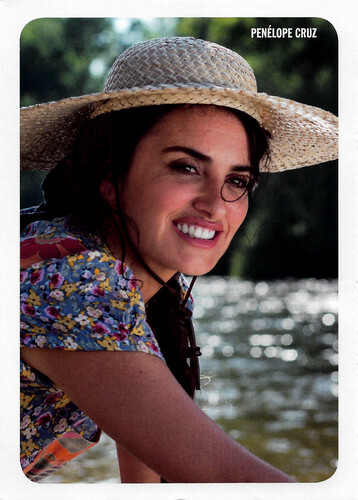
Dutch postcard by Cineart. Penelope Cruz in Dolor y gloria / Pain and Glory (Pedro Almodovar, 2019).
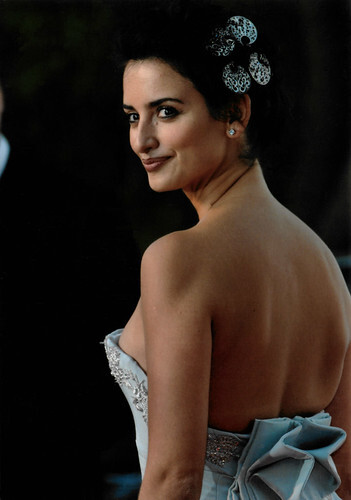
Vintage photo.
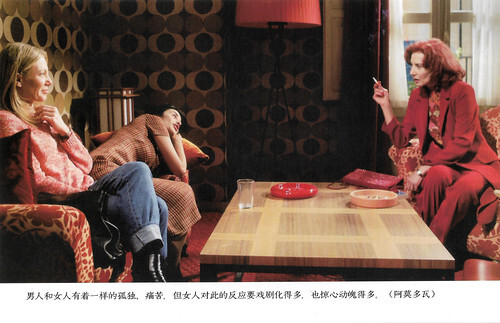
Chinese postcard. Cecilia Roth, Marisa Paredes and Penelope Cruz in Todo sobre mi madre / All About My Mother (Pedro Almodóvar, 1999).
Becoming an actress to fulfil her dream of one day working with Almodovar
Penélope Cruz Sánchez was born in 1974 in Alcobendas, 20 km north of central Madrid, to Eduardo Cruz, a retailer and car mechanic, and Encarna Sánchez, a hairdresser. Her name derives from one of her parents' favourite songs, 'Penélope', composed and performed by Joan Manuel Serrat. She has two younger siblings: Mónica Cruz (1977), also an actress, and singer Eduardo Cruz (1985). As a child, she was already a compulsive performer, re-enacting TV commercials to amuse her family. She decided to focus on dance.
After studying classical ballet for nine years at Spain's National Conservatory, she continued her training under a series of prominent dancers, including Christina Rota. When she saw the film ¡Átame! / Tie Me Up! Tie Me Down! (Pedro Almodóvar, 1989), starring Victoria Abril, Penelope decided to become an actress to fulfil her dream of one day working with the renowned Spanish director Almodovár. In 1989, at the age of fifteen, she was selected out of more than 300 other girls at a talent agency audition. The resulting contract landed her several roles in Spanish TV shows and music videos, which paved the way for a film career.
Her first film was El laberinto griego / The Greek Labyrinth (Rafael Alcázar, 1992). Director Bigas Luna chose her from among a multitude of actresses for Jamón, jamón (Bigas Luna, 1992). She shared the leading role with the then also newcomers Javier Bardem and Jordi Mollá. In the film, she portrayed Silvia, a young woman who is expecting her first child with a man whose mother does not approve of the relationship and attempts to sabotage it by paying Javier Bardem's character to seduce her. The erotic film was her breakthrough, and she emerged as an attractive and sensual sex-symbol. Cruz was nominated for the Goya Award, the Spanish equivalent of the Academy Award, and the Fotogramas de Plata for Best Film Actress.
She then appeared briefly in the Timothy Dalton thriller Framed (Geoffrey Sax, 1992). She showed that she was versatile in her third film, Belle Epoque (Fernando Trueba, 1992). She played the naive Luz, one of four sisters vying for the love of a handsome army deserter (Jorge Sanz) during the Second Republic in the 1930s. The film won an Oscar for Best Foreign Film and also garnered several Goyas. Her resume grew by three or four films each year, and Cruz was soon a leading lady of Spanish cinema. A small part in Carne trémula / Live Flesh (1997), starring Javier Bardem, offered her the chance to work with Pedro Almodóvar, who would later be her ticket to international fame. The same year, she was the lead actress in Abre los ojos / Open Your Eyes (Alejandro Amenábar, 1997), alongside Eduardo Noriega and Fele Martínez. The thriller was a huge hit in Spain and earned eight Goyas, though again, none for Cruz.
Her luck finally changed when the comedy La niña de tus ojos / The Girl of Your Dreams (Fernando Trueba, 1998) won her a Best Actress Goya. In 1998, Cruz appeared in her first American film as Billy Crudup's consolation-prize Mexican girlfriend in Stephen Frears' Western The Hi-Lo Country. Cruz made a few more forays into English-language film, but her first big international hit was Almodóvar's Todo sobre mi madre / All About My Mother (Pedro Almodovar, 1999), in which she played an unchaste but well-meaning, pregnant nun with AIDS. The film was a commercial and critical success internationally, winning the Academy Award for Best Foreign Language Film in addition to the Golden Globe for Best Foreign Language Film and the BAFTA Awards for Best Film Not in the English Language and Best Direction (Almodóvar). The film also won six Goya Awards.
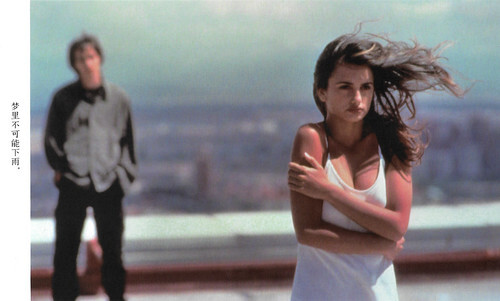
Chinese postcard. Penélope Cruz and Eduardo Noriega in Abre los ojos / Open Your Eyes (Alejandro Amenábar, 1997).
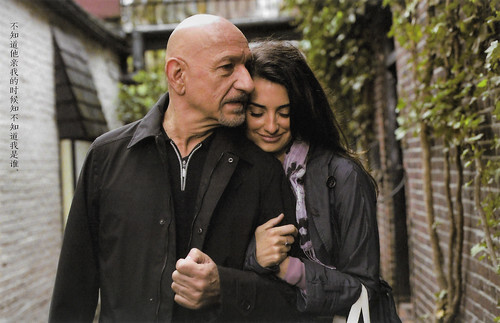
Chinese postcard. Ben Kingsley and Penélope Cruz in Elegy (Isabel Coixet, 2008).
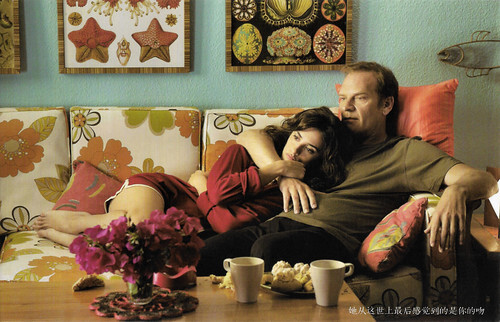
Chinese postcard. Penelope Cruz and Lluis Homar in Los abrazos rotos / Broken Embraces (Pedro Almodovar, 2009).
In demand on both sides of the Atlantic
Penelope Cruz suddenly found herself in demand on both sides of the Atlantic. Her next big project was Woman on Top (Fina Torres, 2000), an American comedy about a chef with bewitching culinary skills and a severe case of motion sickness. While in the US, she also signed up to star opposite Johnny Depp in the drug-trafficking drama Blow (Ted Demme, 2001) and opposite Matt Damon in All the Pretty Horses (Billy Bob Thornton, 2000). Cruz said she was wary of being typecast as a beautiful young damsel.
She had more success with Vanilla Sky (Cameron Crowe, 2001), which made $200 million worldwide. In this remake of Abre los ojos (1997), she played the same role as in the original. She fell in love with her co-star, Tom Cruise, and they had a relationship till 2004. Cruz had a supporting role as Chloe Sava, a patient at a mental hospital, in the Horror film Gothika (Mathieu Kassovitz, 2003) with Halle Berry and Robert Downey Jr. She co-starred with Matthew McConaughey in the adventure film Sahara (Breck Eisner, 2005), which, although it grossed a lot of money, did not cover its high cost.
Her next collaboration with Pedro Almodóvar was in Volver (2006), in which she starred as Raimunda, a working-class woman forced to go to great lengths to protect her 14-year-old daughter, Paula. The six actresses in the film shared the award for Best Female Performance at the 2006 Cannes Film Festival. Thanks to Volver, Penelope Cruz became the first Spanish actress to be nominated for a Hollywood Oscar for Best Leading Actress, although Helen Mirren won the award for The Queen. Two years later, Cruz became the first Spanish actress to win an Oscar for Best Supporting Actress for her part as María Elena, a mentally unstable woman in the romantic drama Vicky Cristina Barcelona (Woody Allen, 2008). Since the filming started in July 2007, a romantic relationship developed between her and her co-star Javier Bardem. Since 2010, they have been married, and they now have two children, Luna Encinas Cruz and Leo Encinas Cruz.
In 2008, Penélope Cruz played one of the central characters in Pedro Almodóvar's seventeenth film, Los abrazos rotos / Broken Embraces, a story inspired by the Film Noir of the 1950s, also starring Ángela Molina. For this role, Cruz received her sixth Goya nomination. Penélope Cruz joined the cast of the film adaptation of the musical Nine (Rob Marshall, 2009), starring Daniel Day-Lewis . For her portrayal of Carla Albanese, the protagonist's mistress, the actress was nominated for a Golden Globe, a Screen Actors Guild Award and, for the third time in four years, an Oscar for Best Female Supporting Actor. She co-starred alongside Johnny Depp in Pirates of the Caribbean: On Stranger Tides (Rob Marshall, 2011), the fourth instalment of the Pirates of the Caribbean saga that grossed over a billion dollars worldwide. In 2011, she also received a star on the Hollywood Walk of Fame. Around the same time, she filmed again with Woody Allen, this time in a supporting role in his magical romantic comedy To Rome with Love (2012). Along with Antonio Banderas , she made a cameo appearance in Pedro Almodóvar's farcical comedy Los amantes pasajeros / I'm So Excited (2013), which marked a return to the director's light, campy comedies of the 1980s and 1990s.
In 2015, Cruz co-produced and starred in the Spanish drama film Ma Ma, directed by Julio Medem. In it, she plays Magda, a gutsy mother and unemployed teacher, who is diagnosed with breast cancer. She landed a supporting role in Murder on the Orient Express (Kenneth Branagh, 2017), the fourth adaptation of Agatha Christie's 1934 novel of the same name, with Johnny Depp , Michelle Pfeiffer , Willem Dafoe and Judi Dench . Also successful were her new films with Pedro Almodovar, Dolor y gloria / Pain and Glory (2019) and Madres paralelas / Parallel Mothers (2021). For the latter, she received her fourth Oscar nomination. She played Janis, a professional photographer entangled in a relationship with a married man, leading to an affair and resulting in her pregnancy. Penelope Cruz is the only actress who has won acting awards from the five main European Film Academies: three Goyas (the Spanish Oscar), one David di Donatello (the Italian Oscar), one Bafta (the British Oscar) one Cesar (the French Oscar) and two Felix (the European Oscar) as well as from the USA Motion Picture Academy (one Oscar).
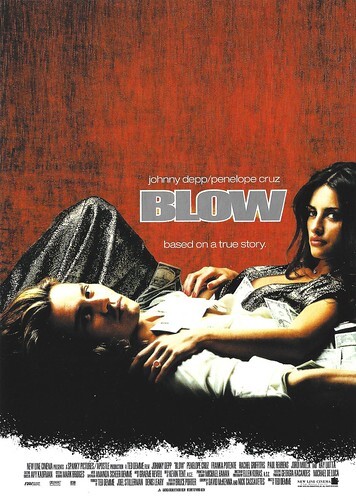
Dutch poster postcard by Boomerang, Amsterdam. Penelope Cruz and Johnny Depp in the crime drama Blow (Ted Demme, 2001).
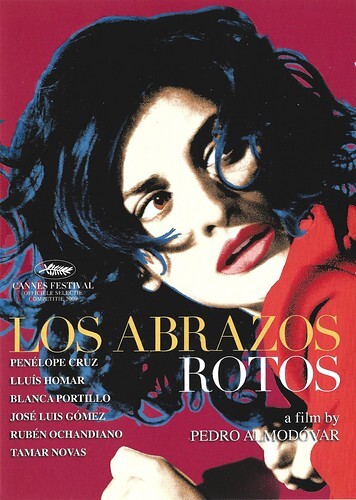
Dutch poster postcard by Boomerang, Amsterdam. Penelope Cruz in Los abrazos rotos / Broken Embraces (Pedro Almodovar, 2009).
Sources: Wikipedia (Dutch, Spanish and English) and

Dutch postcard by Cineart. Penelope Cruz in Dolor y gloria / Pain and Glory (Pedro Almodovar, 2019).

Vintage photo.

Chinese postcard. Cecilia Roth, Marisa Paredes and Penelope Cruz in Todo sobre mi madre / All About My Mother (Pedro Almodóvar, 1999).
Becoming an actress to fulfil her dream of one day working with Almodovar
Penélope Cruz Sánchez was born in 1974 in Alcobendas, 20 km north of central Madrid, to Eduardo Cruz, a retailer and car mechanic, and Encarna Sánchez, a hairdresser. Her name derives from one of her parents' favourite songs, 'Penélope', composed and performed by Joan Manuel Serrat. She has two younger siblings: Mónica Cruz (1977), also an actress, and singer Eduardo Cruz (1985). As a child, she was already a compulsive performer, re-enacting TV commercials to amuse her family. She decided to focus on dance.
After studying classical ballet for nine years at Spain's National Conservatory, she continued her training under a series of prominent dancers, including Christina Rota. When she saw the film ¡Átame! / Tie Me Up! Tie Me Down! (Pedro Almodóvar, 1989), starring Victoria Abril, Penelope decided to become an actress to fulfil her dream of one day working with the renowned Spanish director Almodovár. In 1989, at the age of fifteen, she was selected out of more than 300 other girls at a talent agency audition. The resulting contract landed her several roles in Spanish TV shows and music videos, which paved the way for a film career.
Her first film was El laberinto griego / The Greek Labyrinth (Rafael Alcázar, 1992). Director Bigas Luna chose her from among a multitude of actresses for Jamón, jamón (Bigas Luna, 1992). She shared the leading role with the then also newcomers Javier Bardem and Jordi Mollá. In the film, she portrayed Silvia, a young woman who is expecting her first child with a man whose mother does not approve of the relationship and attempts to sabotage it by paying Javier Bardem's character to seduce her. The erotic film was her breakthrough, and she emerged as an attractive and sensual sex-symbol. Cruz was nominated for the Goya Award, the Spanish equivalent of the Academy Award, and the Fotogramas de Plata for Best Film Actress.
She then appeared briefly in the Timothy Dalton thriller Framed (Geoffrey Sax, 1992). She showed that she was versatile in her third film, Belle Epoque (Fernando Trueba, 1992). She played the naive Luz, one of four sisters vying for the love of a handsome army deserter (Jorge Sanz) during the Second Republic in the 1930s. The film won an Oscar for Best Foreign Film and also garnered several Goyas. Her resume grew by three or four films each year, and Cruz was soon a leading lady of Spanish cinema. A small part in Carne trémula / Live Flesh (1997), starring Javier Bardem, offered her the chance to work with Pedro Almodóvar, who would later be her ticket to international fame. The same year, she was the lead actress in Abre los ojos / Open Your Eyes (Alejandro Amenábar, 1997), alongside Eduardo Noriega and Fele Martínez. The thriller was a huge hit in Spain and earned eight Goyas, though again, none for Cruz.
Her luck finally changed when the comedy La niña de tus ojos / The Girl of Your Dreams (Fernando Trueba, 1998) won her a Best Actress Goya. In 1998, Cruz appeared in her first American film as Billy Crudup's consolation-prize Mexican girlfriend in Stephen Frears' Western The Hi-Lo Country. Cruz made a few more forays into English-language film, but her first big international hit was Almodóvar's Todo sobre mi madre / All About My Mother (Pedro Almodovar, 1999), in which she played an unchaste but well-meaning, pregnant nun with AIDS. The film was a commercial and critical success internationally, winning the Academy Award for Best Foreign Language Film in addition to the Golden Globe for Best Foreign Language Film and the BAFTA Awards for Best Film Not in the English Language and Best Direction (Almodóvar). The film also won six Goya Awards.

Chinese postcard. Penélope Cruz and Eduardo Noriega in Abre los ojos / Open Your Eyes (Alejandro Amenábar, 1997).

Chinese postcard. Ben Kingsley and Penélope Cruz in Elegy (Isabel Coixet, 2008).

Chinese postcard. Penelope Cruz and Lluis Homar in Los abrazos rotos / Broken Embraces (Pedro Almodovar, 2009).
In demand on both sides of the Atlantic
Penelope Cruz suddenly found herself in demand on both sides of the Atlantic. Her next big project was Woman on Top (Fina Torres, 2000), an American comedy about a chef with bewitching culinary skills and a severe case of motion sickness. While in the US, she also signed up to star opposite Johnny Depp in the drug-trafficking drama Blow (Ted Demme, 2001) and opposite Matt Damon in All the Pretty Horses (Billy Bob Thornton, 2000). Cruz said she was wary of being typecast as a beautiful young damsel.
She had more success with Vanilla Sky (Cameron Crowe, 2001), which made $200 million worldwide. In this remake of Abre los ojos (1997), she played the same role as in the original. She fell in love with her co-star, Tom Cruise, and they had a relationship till 2004. Cruz had a supporting role as Chloe Sava, a patient at a mental hospital, in the Horror film Gothika (Mathieu Kassovitz, 2003) with Halle Berry and Robert Downey Jr. She co-starred with Matthew McConaughey in the adventure film Sahara (Breck Eisner, 2005), which, although it grossed a lot of money, did not cover its high cost.
Her next collaboration with Pedro Almodóvar was in Volver (2006), in which she starred as Raimunda, a working-class woman forced to go to great lengths to protect her 14-year-old daughter, Paula. The six actresses in the film shared the award for Best Female Performance at the 2006 Cannes Film Festival. Thanks to Volver, Penelope Cruz became the first Spanish actress to be nominated for a Hollywood Oscar for Best Leading Actress, although Helen Mirren won the award for The Queen. Two years later, Cruz became the first Spanish actress to win an Oscar for Best Supporting Actress for her part as María Elena, a mentally unstable woman in the romantic drama Vicky Cristina Barcelona (Woody Allen, 2008). Since the filming started in July 2007, a romantic relationship developed between her and her co-star Javier Bardem. Since 2010, they have been married, and they now have two children, Luna Encinas Cruz and Leo Encinas Cruz.
In 2008, Penélope Cruz played one of the central characters in Pedro Almodóvar's seventeenth film, Los abrazos rotos / Broken Embraces, a story inspired by the Film Noir of the 1950s, also starring Ángela Molina. For this role, Cruz received her sixth Goya nomination. Penélope Cruz joined the cast of the film adaptation of the musical Nine (Rob Marshall, 2009), starring Daniel Day-Lewis . For her portrayal of Carla Albanese, the protagonist's mistress, the actress was nominated for a Golden Globe, a Screen Actors Guild Award and, for the third time in four years, an Oscar for Best Female Supporting Actor. She co-starred alongside Johnny Depp in Pirates of the Caribbean: On Stranger Tides (Rob Marshall, 2011), the fourth instalment of the Pirates of the Caribbean saga that grossed over a billion dollars worldwide. In 2011, she also received a star on the Hollywood Walk of Fame. Around the same time, she filmed again with Woody Allen, this time in a supporting role in his magical romantic comedy To Rome with Love (2012). Along with Antonio Banderas , she made a cameo appearance in Pedro Almodóvar's farcical comedy Los amantes pasajeros / I'm So Excited (2013), which marked a return to the director's light, campy comedies of the 1980s and 1990s.
In 2015, Cruz co-produced and starred in the Spanish drama film Ma Ma, directed by Julio Medem. In it, she plays Magda, a gutsy mother and unemployed teacher, who is diagnosed with breast cancer. She landed a supporting role in Murder on the Orient Express (Kenneth Branagh, 2017), the fourth adaptation of Agatha Christie's 1934 novel of the same name, with Johnny Depp , Michelle Pfeiffer , Willem Dafoe and Judi Dench . Also successful were her new films with Pedro Almodovar, Dolor y gloria / Pain and Glory (2019) and Madres paralelas / Parallel Mothers (2021). For the latter, she received her fourth Oscar nomination. She played Janis, a professional photographer entangled in a relationship with a married man, leading to an affair and resulting in her pregnancy. Penelope Cruz is the only actress who has won acting awards from the five main European Film Academies: three Goyas (the Spanish Oscar), one David di Donatello (the Italian Oscar), one Bafta (the British Oscar) one Cesar (the French Oscar) and two Felix (the European Oscar) as well as from the USA Motion Picture Academy (one Oscar).

Dutch poster postcard by Boomerang, Amsterdam. Penelope Cruz and Johnny Depp in the crime drama Blow (Ted Demme, 2001).

Dutch poster postcard by Boomerang, Amsterdam. Penelope Cruz in Los abrazos rotos / Broken Embraces (Pedro Almodovar, 2009).
Sources: Wikipedia (Dutch, Spanish and English) and
Published on May 23, 2025 22:00
May 22, 2025
Jean Galland
Jean Galland (1897-1967) was a French actor who was known for such early sound films as Fantômas (1932) and Le jugement de minuit (1933). After the war, he played supporting parts in classics by Jean Becker and Max Ophüls.
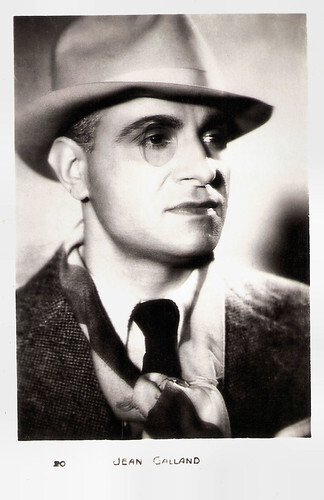
French postcard, no. 20.
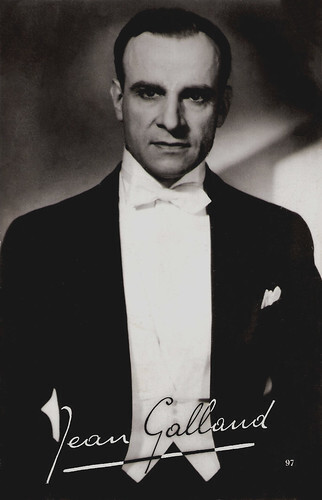
French postcard by Editions et Publications cinématographiques (EPC), no. 97.
"Indecent," "immoral", and tending to "corrupt morals"
Jean Charles Pierre Galland was born in 1897 in Laval, in the Mayenne department in France, into a family of magistrates. He studied law and prepared for the École Libre des Sciences Politiques. But soon, the First World War called him up. In 1916, he was seriously injured in Verdun and returned to civilian life with the rank of lieutenant.
After the war, his life had a turning point. By chance, he found himself in the middle of a group of actors, and this triggered him in an unexpected direction despite the opposition of his family. He made his stage debut in the music hall and then, under the pseudonym Jean Gallot, he joined the prestigious Vieux Colombier theatre company directed by Jacques Copeau. He stayed there for three years and then moved to the Boulevard Theatre.
With the advent of talking pictures, he began a career in cinema. Galland made his film debut in Paris la nuit / Paris By Night (Henri Diamant-Berger, 1930), starring Marguerite Moreno and Armand Bernard . Galland played another supporting part in the war drama Les croix de bois / The Wooden Crosses (Raymond Bernard, 1932) with Pierre Blanchar . He played Captain Cruchet, who experienced the horrors of the trenches during the First World War with his comrades.
He had his breakthrough as the mysterious star of the crime thriller Fantômas (Pál Fejös, 1932) opposite Tania Fedor and Thomy Bourdelle as Inspector Juve. That same year, he had a leading part in Gance's dreadful melodrama Mater dolorosa (Abel Gance, 1932) with Line Noro. He appeared as the husband of Jeanne Boitel in the romantic drama Remous / Whirlpool (Edmond T. Gréville, 1935). Galland played a newly-married man who is paralysed and impotent after a car accident. His sexually frustrated wife, who loves him, has a short affair with an athletic, handsome man. When the husband learns of the affair, he commits suicide. U.S. censors twice denied American distributors a license for the film as being "indecent," "immoral", and tending to "corrupt morals."
In Germany, Galland co-starred in the romantic drama Die Unbekannte / The Unknown (Frank Wisbar, 1936) opposite Sybille Schmitz . It was inspired by the famous death of an unknown woman who was discovered drowned in the River Seine in Paris. He also appeared in Gréville's Menaces.. / Threats (Edmond T. Gréville, 1940) with Mireille Balin , John Loder and Erich von Stroheim . The film was completed in September 1938 under the title Cinq jours d'angoisse, but before it could be released, the film was partially destroyed by fire. This required many of the scenes to be refilmed.
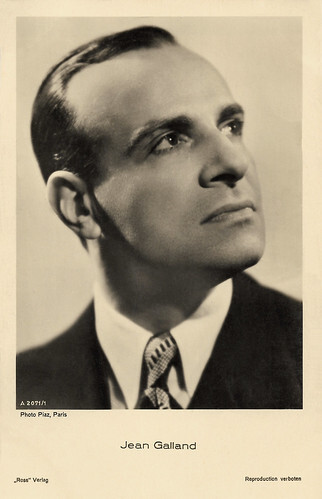
German postcard by Ross Verlag, no. A 2071/1, 1939-1940. Photo: Piaz, Paris.

French collector card. Photo: Teddy Piaz.
The most perfect film ever made
After an interval during and after the war, Jean Galland returned to the screen as the snobbish uncle of Caroline in the warm and optimistic romantic comedy-drama Edouard et Caroline (Jacques Becker, 1951), featuring Daniel Gélin and Anne Vernon . DB DuMonteil at IMDb : "My god, I love this film! Among Jacques Becker's small filmography (13 movies in all), this is perhaps the most overlooked one. The plot is very thin, and the whole story takes place in two apartments, Edouard and Caroline's modest home, and her uncle's luxurious dwelling."
Next, Galland appeared in another classic, the Guy de Maupassant adaptation Le Plaisir / Pleasure (Max Ophüls, 1951) with Claude Dauphin and Gaby Morlay . He also played a supporting part in Ophüls's romantic drama Madame de... / The Earrings of Madame de... (Max Ophüls, 1953), starring Danielle Darrieux . The film is considered a masterpiece of 1950s French cinema, with film critic Andrew Sarris calling it "the most perfect film ever made".
In the following decades, Galland continued acting in films, theatre and later, television. His later films included Marianne de ma jeunesse / Marianne of My Youth (Julien Duvivier, 1955) with Marianne Hold and Pierre Vaneck, Lola Montès (Max Ophüls, 1955) starring Martine Carol , and La tête contre les murs (Georges Franju, 1959) with Pierre Brasseur and Jean-Pierre Mocky.
Later he appeared in Mocky's comedies Snobs! (Jean-Pierre Mocky, 1962), Les vierges / The Virgins (1962) and Un drôle de paroissien / Thank Heaven for Small Favors (Jean-Pierre Mocky, 1963) starring Bourvil . He also played a bank director in Une Manche et la Bell / What Price Murder? (1957) by Henri Verneuil and Arthur's uncle in Les godelureaux / Wise Guys (1960) by Claude Chabrol.
From 1931, Jean Galland ran with Charles Saint Pouloff the cinema Théâtre Le Ranelagh in the 16th arrondissement of Paris. A renowned mountaineer, he made a documentary film, which he presented in Cherbourg in 1959. In 1967, he retired definitively from artistic life to take charge of a pharmaceutical laboratory. In 1967, he died of a heart attack at the age of 70 while on tour in Evian-les-Bains, Haute-Savoie, and is buried in the family grave in the Condé-sur-Noireau cemetery in Calvados. Jean Galland was married for 30 years, from 1926 to 1957, to the actress Germaine Dermoz , with whom he had a daughter, Anne-Marie. He then married Annie Maillard.
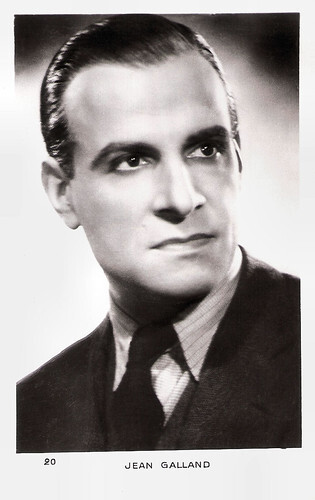
French postcard, no. 20.
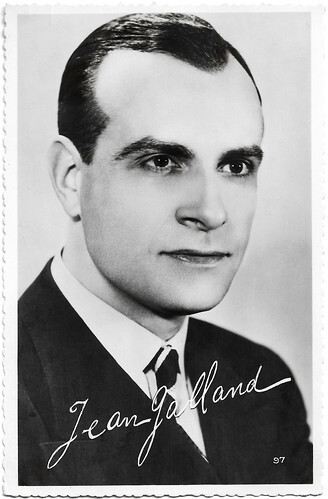
French postcard by Editions et Publications Cinématographiques, no. 97.
Sources: Gary Richardson (Notre Cinéma), DB DuMonteil (IMDb), Wikipedia (French and English) and .

French postcard, no. 20.

French postcard by Editions et Publications cinématographiques (EPC), no. 97.
"Indecent," "immoral", and tending to "corrupt morals"
Jean Charles Pierre Galland was born in 1897 in Laval, in the Mayenne department in France, into a family of magistrates. He studied law and prepared for the École Libre des Sciences Politiques. But soon, the First World War called him up. In 1916, he was seriously injured in Verdun and returned to civilian life with the rank of lieutenant.
After the war, his life had a turning point. By chance, he found himself in the middle of a group of actors, and this triggered him in an unexpected direction despite the opposition of his family. He made his stage debut in the music hall and then, under the pseudonym Jean Gallot, he joined the prestigious Vieux Colombier theatre company directed by Jacques Copeau. He stayed there for three years and then moved to the Boulevard Theatre.
With the advent of talking pictures, he began a career in cinema. Galland made his film debut in Paris la nuit / Paris By Night (Henri Diamant-Berger, 1930), starring Marguerite Moreno and Armand Bernard . Galland played another supporting part in the war drama Les croix de bois / The Wooden Crosses (Raymond Bernard, 1932) with Pierre Blanchar . He played Captain Cruchet, who experienced the horrors of the trenches during the First World War with his comrades.
He had his breakthrough as the mysterious star of the crime thriller Fantômas (Pál Fejös, 1932) opposite Tania Fedor and Thomy Bourdelle as Inspector Juve. That same year, he had a leading part in Gance's dreadful melodrama Mater dolorosa (Abel Gance, 1932) with Line Noro. He appeared as the husband of Jeanne Boitel in the romantic drama Remous / Whirlpool (Edmond T. Gréville, 1935). Galland played a newly-married man who is paralysed and impotent after a car accident. His sexually frustrated wife, who loves him, has a short affair with an athletic, handsome man. When the husband learns of the affair, he commits suicide. U.S. censors twice denied American distributors a license for the film as being "indecent," "immoral", and tending to "corrupt morals."
In Germany, Galland co-starred in the romantic drama Die Unbekannte / The Unknown (Frank Wisbar, 1936) opposite Sybille Schmitz . It was inspired by the famous death of an unknown woman who was discovered drowned in the River Seine in Paris. He also appeared in Gréville's Menaces.. / Threats (Edmond T. Gréville, 1940) with Mireille Balin , John Loder and Erich von Stroheim . The film was completed in September 1938 under the title Cinq jours d'angoisse, but before it could be released, the film was partially destroyed by fire. This required many of the scenes to be refilmed.

German postcard by Ross Verlag, no. A 2071/1, 1939-1940. Photo: Piaz, Paris.

French collector card. Photo: Teddy Piaz.
The most perfect film ever made
After an interval during and after the war, Jean Galland returned to the screen as the snobbish uncle of Caroline in the warm and optimistic romantic comedy-drama Edouard et Caroline (Jacques Becker, 1951), featuring Daniel Gélin and Anne Vernon . DB DuMonteil at IMDb : "My god, I love this film! Among Jacques Becker's small filmography (13 movies in all), this is perhaps the most overlooked one. The plot is very thin, and the whole story takes place in two apartments, Edouard and Caroline's modest home, and her uncle's luxurious dwelling."
Next, Galland appeared in another classic, the Guy de Maupassant adaptation Le Plaisir / Pleasure (Max Ophüls, 1951) with Claude Dauphin and Gaby Morlay . He also played a supporting part in Ophüls's romantic drama Madame de... / The Earrings of Madame de... (Max Ophüls, 1953), starring Danielle Darrieux . The film is considered a masterpiece of 1950s French cinema, with film critic Andrew Sarris calling it "the most perfect film ever made".
In the following decades, Galland continued acting in films, theatre and later, television. His later films included Marianne de ma jeunesse / Marianne of My Youth (Julien Duvivier, 1955) with Marianne Hold and Pierre Vaneck, Lola Montès (Max Ophüls, 1955) starring Martine Carol , and La tête contre les murs (Georges Franju, 1959) with Pierre Brasseur and Jean-Pierre Mocky.
Later he appeared in Mocky's comedies Snobs! (Jean-Pierre Mocky, 1962), Les vierges / The Virgins (1962) and Un drôle de paroissien / Thank Heaven for Small Favors (Jean-Pierre Mocky, 1963) starring Bourvil . He also played a bank director in Une Manche et la Bell / What Price Murder? (1957) by Henri Verneuil and Arthur's uncle in Les godelureaux / Wise Guys (1960) by Claude Chabrol.
From 1931, Jean Galland ran with Charles Saint Pouloff the cinema Théâtre Le Ranelagh in the 16th arrondissement of Paris. A renowned mountaineer, he made a documentary film, which he presented in Cherbourg in 1959. In 1967, he retired definitively from artistic life to take charge of a pharmaceutical laboratory. In 1967, he died of a heart attack at the age of 70 while on tour in Evian-les-Bains, Haute-Savoie, and is buried in the family grave in the Condé-sur-Noireau cemetery in Calvados. Jean Galland was married for 30 years, from 1926 to 1957, to the actress Germaine Dermoz , with whom he had a daughter, Anne-Marie. He then married Annie Maillard.

French postcard, no. 20.

French postcard by Editions et Publications Cinématographiques, no. 97.
Sources: Gary Richardson (Notre Cinéma), DB DuMonteil (IMDb), Wikipedia (French and English) and .
Published on May 22, 2025 22:00
May 20, 2025
Directed by Allan Dwan
American film director, producer and screenwriter Allan Dwan (1885-1981) directed more than 400 short and feature films over 50 years. Along with Cecil B. DeMille, Dwan was one of the few directors who made the transition from the days of the one-reelers in the 1910s through the glory days of the studio system in the 1930s and 1940s and into its decline in the 1950s.
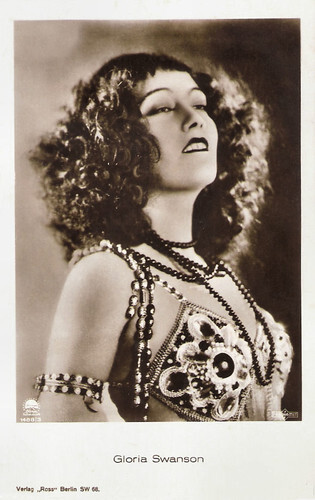
German postcard by Ross Verlag, no. 1488/3, 1927-1928. Photo: Donald Biddle Keyes / Paramount / Parafumet. Gloria Swanson in Stage Struck (Allan Dwan, 1925).
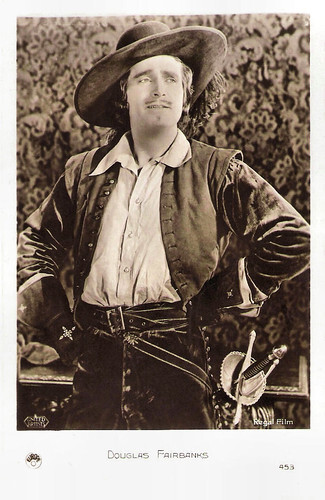
French postcard by Europe, no. 453. Photo: United Artists / Regal Film. Douglas Fairbanks in The Iron Mask (Allan Dwan, 1929).

German postcard by Ross Verlag, no. A 1483/5, 1937-1938. Photo: 20th Century Fox Film. Shirley Temple in Heidi (Allan Dwan, 1937).
Pressed into service as a director
Joseph Aloysius (Allan) Dwan was born in Toronto, Canada, in 1885. Dwan was the younger son of a commercial traveller of woollen clothing, Joseph Michael Dwan and his wife, Mary Jane Dwan (née Hunt). In 1892, Dwan moved with his family to America when he was seven years old and grew up in Chicago. He earned a degree in electrical engineering from the University of Notre Dame, South Bend, Indiana.
He started to work as an electrical engineer in Chicago for Cooper Hewitt Electric Company, installing Cooper-Hewitt lamps at the Chicago Post Office, opposite the Essanay film studio. Essanay exec George K. Spoor thought the lights could prove useful in film photography and contracted Dwan to design a bank of lights.
Dwan had a strong interest in the fledgling motion picture industry, and when Essanay Studios offered him the opportunity to become a scriptwriter, he took the job in 1909. He wrote several screenplays for Essanay, first in Chicago, then in New York and from 1911, part-time in Hollywood.
His first directing assignment arrived almost by accident: he was "pressed into service" by the American Film Co. when one of its directors went AWOL on an alcoholic binge. Dwan operated Flying A Studios in La Mesa, California, from August 1911 to July 1912. Flying A was one of the first motion picture studios in California history.
In 1911–1913, Dwan turned out as many as 250 one-reelers — Westerns, comedies, and even documentaries, which rarely lasted longer than 15 minutes. All were written, edited, and produced by him, but few still exist. In 1913, he signed with the Universal Film Manufacturing Company, but within a year, he moved to the Famous Players Company in New York, and a year after that, he was working with D.W. Griffith at the Triangle Film Corporation.
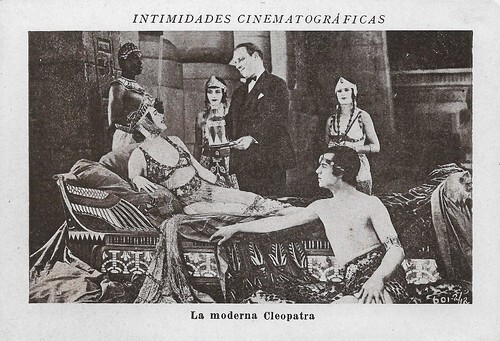
Spanish minicard in the Series Intimidades cinematograficas, series I, card 16 of 20. Nita Naldi in an intermezzo with the director in Lawful Larceny (Allan Dwan, 1923). Caption: The modern Cleopatra.

Italian postcard by Ed. Ballerini & Fratini, Firenze, no. 756. Photo: S.A.I. Films Paramount, Roma. Bebe Daniels , James Rennie and Ricardo Cortez in Argentine Love (Allan Dwan, 1924). Italian release title: Amore Argentino.
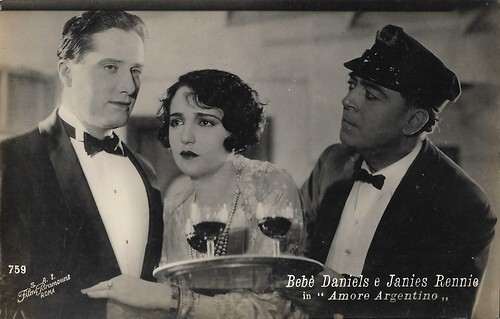
Italian postcard by Ed. Ballerini & Fratini, Firenze, no. 759. Photo: S.A.I. Films Paramount, Roma. Bebe Daniels and James Rennie in Argentine Love (Allan Dwan, 1924). Italian release title: Amore Argentino.
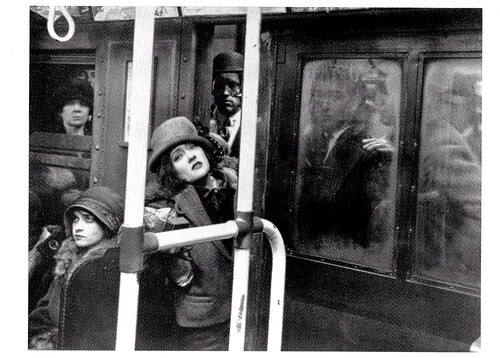
American postcard by Photo / Chronicles Ltd., New York, NY, no. S 317. Photo: Paramount / Astoria Motion Picture and Television Foundation. Gloria Swanson in Manhandled (Allan Dwan, 1924).
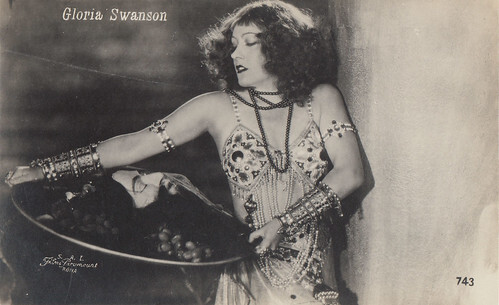
Italian postcard by Casa Editrice Ballerini & Fratini, no. 743. Photo: S.A.I. Films Paramount, Roma. Gloria Swanson in Stage Struck (Allan Dwan, 1925). Collection: Marlene Pilaete.
The go-to guy
During this time, Allan Dwan was the ‘go-to guy’ as a director, editor, screenwriter and occasional extra. This gave him a sound knowledge of technical aspects as well as dramaturgy and actor direction.
As a pioneer in this field, he was the inventor of the dolly shot in 1915, in which the camera is mounted on a moving automobile and follows the actor's movements. He first used the technique in the film David Harum (1915), in which he filmed a stroll by the actor William H. Crane.
In the same year, he was responsible for solving a technical problem that D.W. Griffith had during the shooting of Intolerance (1916). Dwan invented the equipment used for the crane shots.
After making a series of Westerns and comedies, Dwan was responsible for some of the early successes of Mary Pickford in such films as A Girl of Yesterday (1915) for Famous Players and of Lillian Gish and Dorothy Gish for Triangle. From 1916, he favoured shooting with his good friend Douglas Fairbanks Sr. , notably in A Modern Musketeer (1917), the acclaimed Swashbuckling epic Robin Hood (1922) and the part-talkie The Iron Mask (1929).
Dwan also directed Carole Lombard in her film debut, A Perfect Crime (1921), starring Monte Blue . He directed Gloria Swanson in eight feature films at Paramount, including Zaza (1923) with H.B. Warner, Manhandled (1924) and Stage Struck (1925) with Lawrence Gray. In 1925, he also directed Swanson in a short film made in the short-lived sound-on-film process Phonofilm. This short, also featuring Thomas Meighan and Henri de la Falaise, was produced as a joke, with the film showing Swanson crashing the all-male club The Lambs.
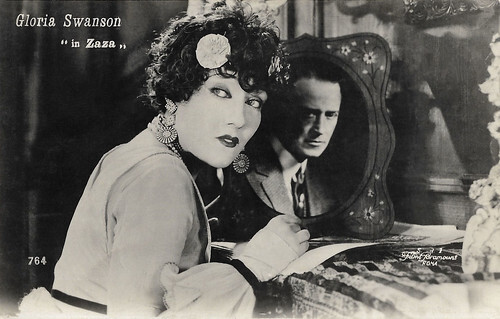
Italian postcard by Ed. Ballerini & Fratini, no. 764. Photo: Gloria Swanson in Zazà (Allan Dwan, 1923).

German postcard by Ross Verlag, no. 3658/3, 1928-1929. Photo: United Artists. The card depicts a moment in The Three Musketeers (Fred Niblo, 1921), but stems from when Douglas Fairbanks made the sequel to The Three Musketeers: The Iron Mask (Allan Dwan, 1929).
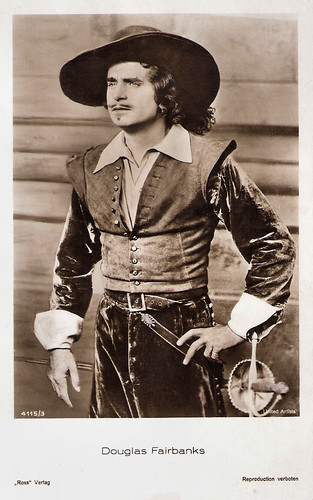
German postcard by Ross Verlag, no. 4115/3, 1929-1930. Photo: United Artists. Douglas Fairbanks in The Iron Mask (Allan Dwan, 1929).
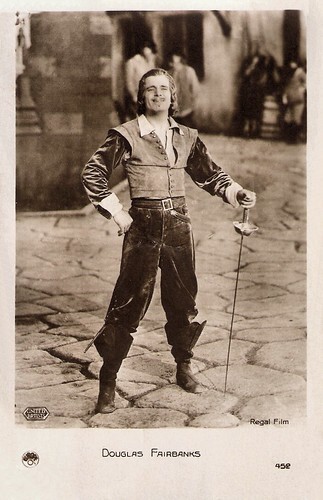
French postcard by Europe, no. 452. Photo: United Artists / Regal Film. Douglas Fairbanks in The Iron Mask (Allan Dwan, 1929).
An exclusive contract with Republic
With the advent of sound film, Allan Dwan's career declined rapidly and after his return from England in 1934 he found himself mainly in B-movies. It was only the commercial and artistic success of two films with Shirley Temple , Heidi (1937) and Rebecca of Sunnybrook Farm (1938), that helped to put him back on the list of directors in demand. In later years, Dwan repeatedly expressed his fascination with the professionalism and acting skills of Temple, who gave some of her best performances under his direction.
He was then allowed to direct the monumental film Suez (1938) with Tyrone Power and Loretta Young for 20th Century Fox, only to sink back to the level of second-rate productions shortly afterwards. It was not until the mid-1940s that his career recovered.
In 1946 Dwan signed an exclusive contract with Republic Studios. Highly acclaimed was his box office hit, the war film Sands of Iwo Jima (1949) starring John Wayne as a hard-boiled Marine. The film follows a group of United States Marines from training to the Battle of Iwo Jima during World War II. The film received four nominations at the 22nd Academy Awards but won no awards.
Moving to RKO Radio Pictures, Dwan made for producer Benedict Bogeaus’s Filmcrest Productions 10 films, among which are some of his most acclaimed. Silver Lode (1954) was a noirish Western that served as an allegory about McCarthyism: the town named in the title turns on beloved citizen Dan Ballard (John Payne) after he is framed for murder by Marshall Ned McCarty (Dan Duryea).
Cattle Queen of Montana (1954) starred Barbara Stanwyck, who, as Sierra Nevada Jones, out-toughs land-grabbers, Indians, and even helpful Ronald Reagan by a wide margin. Slightly Scarlet (1956) was an adaptation of James M. Cain’s novel ‘Love’s Lovely Counterfeit’, about sisters navigating the politics of a corrupt town. The River’s Edge (1957) gave Ray Milland one of his best late roles, as a bank robber trying to make it into Mexico with a suitcase of stolen cash.
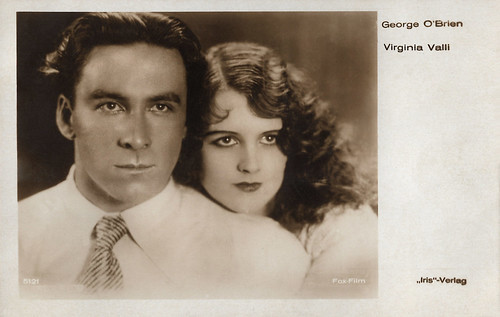
Austrian postcard by Iris-Verlag, no. 5121. Photo: Fox-Film. George O'Brien and June Collier in East Side, West Side (Allan Dwan, 1927).
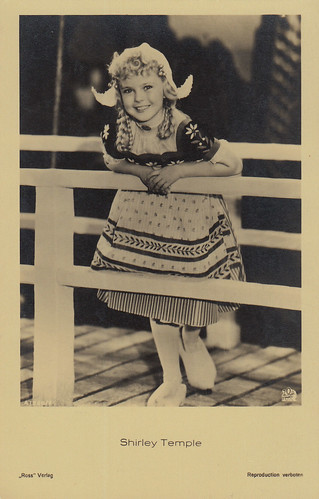
German postcard by Ross Verlag, no. A 1538/6, 1937-1938. Photo: 20th Century Fox. Shirley Temple in Heidi (Allan Dwan, 1937). She's wearing the costume in the fairytale music dance sequence Magic Wooden Shoes: "Once there was a Dutch girl ..."
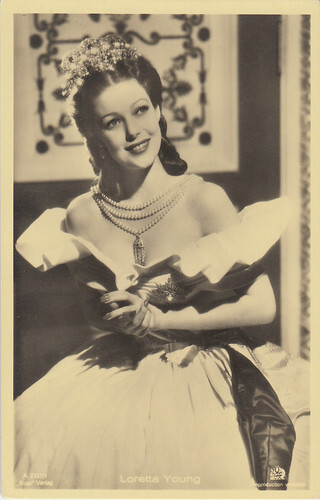
German postcard by Ross Verlag, no. A 2337/1, 1939-1940. Photo: 20th Century Fox. Loretta Young in Suez (Allan Dwan, 1938). Collection: Marlene Pilaete.
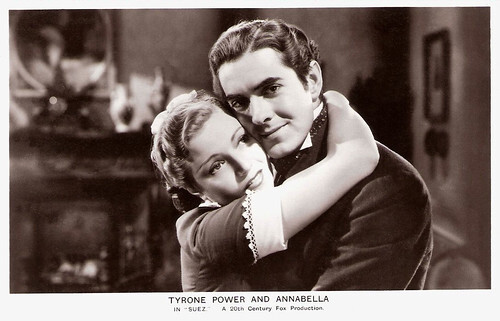
British postcard by Real Photograph, London, nr. FS 177. Photo: 20th Century Fox. Tyrone Power and Annabella in Suez (Allan Dwan, 1938), a highly fictionalised biographical account of the builder of the Suez Canal, Ferdinand de Lesseps.
One of the last surviving pioneers of the cinema
Allan Dwan’s last film was Most Dangerous Man Alive (1961) with Ron Randell and Debra Paget . The Science-Fiction thriller was made in 1958 but not released until 1961. Eventually, Dwan directed more than 400 films over 50 years, including 125 features.
In his retirement, Allan Dwan was rediscovered as one of the last surviving pioneers of the cinema. British film historian Kevin Brownlow devoted a chapter to Dwan’s reminiscences in his study of silent-era Hollywood, ‘The Parade’s Gone By’ (1968).
Peter Bogdanovich wrote the biopic ‘Allan Dwan, The Last Pioneer’ about him in 1971. Allan Dwan received a star on the Hollywood Walk of Fame and a Los Angeles Film Critics Association Award for lifetime achievement for his services to American cinema. In 1980, he was interviewed at length for the documentary series Hollywood.
A year later, he died of heart failure at the age of 96 in Woodland Hills, Los Angeles. Alan Dwan was married to the actresses Pauline Bush (1915-1919) and Marie Shelton (1927-1949).
Alan Dwan is buried at San Fernando Mission Cemetery in Mission Hills, CA, Section F, Tier 18, Grave 62. He had once used the mission grounds as a location for his silent feature Tide of Empire (1929). Just as he was fond of opening his films with a poem after the main credits, Dwan wrote the epitaph on his grave marker in verse: "Look Down, Oh Lord, and bless me with thy grace / And make me worthy of thy sacrifice / And after death to look upon thy face / And earn, perhaps, a place in paradise".
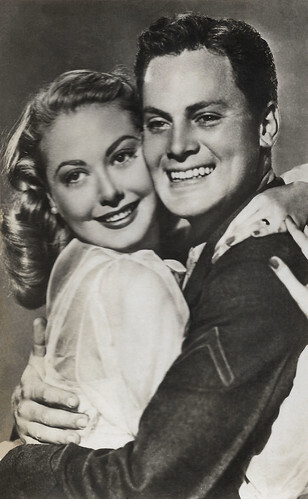
Spanish postcard by Ed. Sobe. John Agar and Adele Mara in Sands of Iwo Jima (Allan Dwan, 1949).
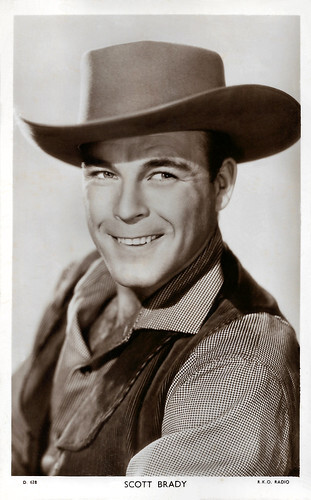
British postcard in the Picturegoer Series, London, no. D. 628. Photo: RKO Radio. Scott Brady in Montana Belle (Allan Dwan, 1952).
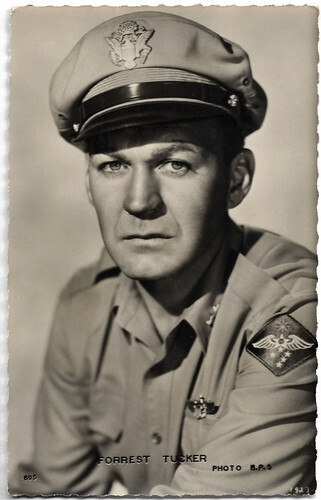
French postcard by Editions P.I., Paris, offered by Les carbones Korès "Carboplane", no. 695. Photo: B.P.S. / Republic. Forrest Tucker in Flight Nurse (Allan Dwan, 1953).
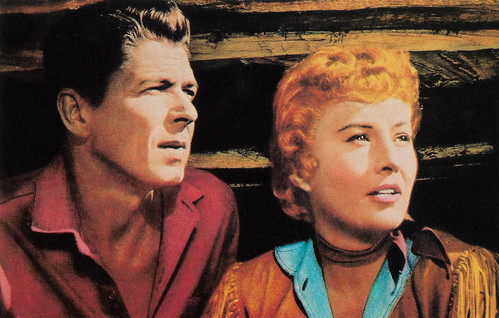
American postcard by Coral-Lee, Rancho Cordova, CA, no. SC17489. Photo: Tony Koroda / 1981 Sygma. Ronald Reagan and Barbara Stanwyck in Cattle Queen of Montana (Allan Dwan, 1954).
Sources: Michael Barson (Brittanica), Wikipedia (Dutch, German and English) and .

German postcard by Ross Verlag, no. 1488/3, 1927-1928. Photo: Donald Biddle Keyes / Paramount / Parafumet. Gloria Swanson in Stage Struck (Allan Dwan, 1925).

French postcard by Europe, no. 453. Photo: United Artists / Regal Film. Douglas Fairbanks in The Iron Mask (Allan Dwan, 1929).

German postcard by Ross Verlag, no. A 1483/5, 1937-1938. Photo: 20th Century Fox Film. Shirley Temple in Heidi (Allan Dwan, 1937).
Pressed into service as a director
Joseph Aloysius (Allan) Dwan was born in Toronto, Canada, in 1885. Dwan was the younger son of a commercial traveller of woollen clothing, Joseph Michael Dwan and his wife, Mary Jane Dwan (née Hunt). In 1892, Dwan moved with his family to America when he was seven years old and grew up in Chicago. He earned a degree in electrical engineering from the University of Notre Dame, South Bend, Indiana.
He started to work as an electrical engineer in Chicago for Cooper Hewitt Electric Company, installing Cooper-Hewitt lamps at the Chicago Post Office, opposite the Essanay film studio. Essanay exec George K. Spoor thought the lights could prove useful in film photography and contracted Dwan to design a bank of lights.
Dwan had a strong interest in the fledgling motion picture industry, and when Essanay Studios offered him the opportunity to become a scriptwriter, he took the job in 1909. He wrote several screenplays for Essanay, first in Chicago, then in New York and from 1911, part-time in Hollywood.
His first directing assignment arrived almost by accident: he was "pressed into service" by the American Film Co. when one of its directors went AWOL on an alcoholic binge. Dwan operated Flying A Studios in La Mesa, California, from August 1911 to July 1912. Flying A was one of the first motion picture studios in California history.
In 1911–1913, Dwan turned out as many as 250 one-reelers — Westerns, comedies, and even documentaries, which rarely lasted longer than 15 minutes. All were written, edited, and produced by him, but few still exist. In 1913, he signed with the Universal Film Manufacturing Company, but within a year, he moved to the Famous Players Company in New York, and a year after that, he was working with D.W. Griffith at the Triangle Film Corporation.

Spanish minicard in the Series Intimidades cinematograficas, series I, card 16 of 20. Nita Naldi in an intermezzo with the director in Lawful Larceny (Allan Dwan, 1923). Caption: The modern Cleopatra.

Italian postcard by Ed. Ballerini & Fratini, Firenze, no. 756. Photo: S.A.I. Films Paramount, Roma. Bebe Daniels , James Rennie and Ricardo Cortez in Argentine Love (Allan Dwan, 1924). Italian release title: Amore Argentino.

Italian postcard by Ed. Ballerini & Fratini, Firenze, no. 759. Photo: S.A.I. Films Paramount, Roma. Bebe Daniels and James Rennie in Argentine Love (Allan Dwan, 1924). Italian release title: Amore Argentino.

American postcard by Photo / Chronicles Ltd., New York, NY, no. S 317. Photo: Paramount / Astoria Motion Picture and Television Foundation. Gloria Swanson in Manhandled (Allan Dwan, 1924).

Italian postcard by Casa Editrice Ballerini & Fratini, no. 743. Photo: S.A.I. Films Paramount, Roma. Gloria Swanson in Stage Struck (Allan Dwan, 1925). Collection: Marlene Pilaete.
The go-to guy
During this time, Allan Dwan was the ‘go-to guy’ as a director, editor, screenwriter and occasional extra. This gave him a sound knowledge of technical aspects as well as dramaturgy and actor direction.
As a pioneer in this field, he was the inventor of the dolly shot in 1915, in which the camera is mounted on a moving automobile and follows the actor's movements. He first used the technique in the film David Harum (1915), in which he filmed a stroll by the actor William H. Crane.
In the same year, he was responsible for solving a technical problem that D.W. Griffith had during the shooting of Intolerance (1916). Dwan invented the equipment used for the crane shots.
After making a series of Westerns and comedies, Dwan was responsible for some of the early successes of Mary Pickford in such films as A Girl of Yesterday (1915) for Famous Players and of Lillian Gish and Dorothy Gish for Triangle. From 1916, he favoured shooting with his good friend Douglas Fairbanks Sr. , notably in A Modern Musketeer (1917), the acclaimed Swashbuckling epic Robin Hood (1922) and the part-talkie The Iron Mask (1929).
Dwan also directed Carole Lombard in her film debut, A Perfect Crime (1921), starring Monte Blue . He directed Gloria Swanson in eight feature films at Paramount, including Zaza (1923) with H.B. Warner, Manhandled (1924) and Stage Struck (1925) with Lawrence Gray. In 1925, he also directed Swanson in a short film made in the short-lived sound-on-film process Phonofilm. This short, also featuring Thomas Meighan and Henri de la Falaise, was produced as a joke, with the film showing Swanson crashing the all-male club The Lambs.

Italian postcard by Ed. Ballerini & Fratini, no. 764. Photo: Gloria Swanson in Zazà (Allan Dwan, 1923).

German postcard by Ross Verlag, no. 3658/3, 1928-1929. Photo: United Artists. The card depicts a moment in The Three Musketeers (Fred Niblo, 1921), but stems from when Douglas Fairbanks made the sequel to The Three Musketeers: The Iron Mask (Allan Dwan, 1929).

German postcard by Ross Verlag, no. 4115/3, 1929-1930. Photo: United Artists. Douglas Fairbanks in The Iron Mask (Allan Dwan, 1929).

French postcard by Europe, no. 452. Photo: United Artists / Regal Film. Douglas Fairbanks in The Iron Mask (Allan Dwan, 1929).
An exclusive contract with Republic
With the advent of sound film, Allan Dwan's career declined rapidly and after his return from England in 1934 he found himself mainly in B-movies. It was only the commercial and artistic success of two films with Shirley Temple , Heidi (1937) and Rebecca of Sunnybrook Farm (1938), that helped to put him back on the list of directors in demand. In later years, Dwan repeatedly expressed his fascination with the professionalism and acting skills of Temple, who gave some of her best performances under his direction.
He was then allowed to direct the monumental film Suez (1938) with Tyrone Power and Loretta Young for 20th Century Fox, only to sink back to the level of second-rate productions shortly afterwards. It was not until the mid-1940s that his career recovered.
In 1946 Dwan signed an exclusive contract with Republic Studios. Highly acclaimed was his box office hit, the war film Sands of Iwo Jima (1949) starring John Wayne as a hard-boiled Marine. The film follows a group of United States Marines from training to the Battle of Iwo Jima during World War II. The film received four nominations at the 22nd Academy Awards but won no awards.
Moving to RKO Radio Pictures, Dwan made for producer Benedict Bogeaus’s Filmcrest Productions 10 films, among which are some of his most acclaimed. Silver Lode (1954) was a noirish Western that served as an allegory about McCarthyism: the town named in the title turns on beloved citizen Dan Ballard (John Payne) after he is framed for murder by Marshall Ned McCarty (Dan Duryea).
Cattle Queen of Montana (1954) starred Barbara Stanwyck, who, as Sierra Nevada Jones, out-toughs land-grabbers, Indians, and even helpful Ronald Reagan by a wide margin. Slightly Scarlet (1956) was an adaptation of James M. Cain’s novel ‘Love’s Lovely Counterfeit’, about sisters navigating the politics of a corrupt town. The River’s Edge (1957) gave Ray Milland one of his best late roles, as a bank robber trying to make it into Mexico with a suitcase of stolen cash.

Austrian postcard by Iris-Verlag, no. 5121. Photo: Fox-Film. George O'Brien and June Collier in East Side, West Side (Allan Dwan, 1927).

German postcard by Ross Verlag, no. A 1538/6, 1937-1938. Photo: 20th Century Fox. Shirley Temple in Heidi (Allan Dwan, 1937). She's wearing the costume in the fairytale music dance sequence Magic Wooden Shoes: "Once there was a Dutch girl ..."

German postcard by Ross Verlag, no. A 2337/1, 1939-1940. Photo: 20th Century Fox. Loretta Young in Suez (Allan Dwan, 1938). Collection: Marlene Pilaete.

British postcard by Real Photograph, London, nr. FS 177. Photo: 20th Century Fox. Tyrone Power and Annabella in Suez (Allan Dwan, 1938), a highly fictionalised biographical account of the builder of the Suez Canal, Ferdinand de Lesseps.
One of the last surviving pioneers of the cinema
Allan Dwan’s last film was Most Dangerous Man Alive (1961) with Ron Randell and Debra Paget . The Science-Fiction thriller was made in 1958 but not released until 1961. Eventually, Dwan directed more than 400 films over 50 years, including 125 features.
In his retirement, Allan Dwan was rediscovered as one of the last surviving pioneers of the cinema. British film historian Kevin Brownlow devoted a chapter to Dwan’s reminiscences in his study of silent-era Hollywood, ‘The Parade’s Gone By’ (1968).
Peter Bogdanovich wrote the biopic ‘Allan Dwan, The Last Pioneer’ about him in 1971. Allan Dwan received a star on the Hollywood Walk of Fame and a Los Angeles Film Critics Association Award for lifetime achievement for his services to American cinema. In 1980, he was interviewed at length for the documentary series Hollywood.
A year later, he died of heart failure at the age of 96 in Woodland Hills, Los Angeles. Alan Dwan was married to the actresses Pauline Bush (1915-1919) and Marie Shelton (1927-1949).
Alan Dwan is buried at San Fernando Mission Cemetery in Mission Hills, CA, Section F, Tier 18, Grave 62. He had once used the mission grounds as a location for his silent feature Tide of Empire (1929). Just as he was fond of opening his films with a poem after the main credits, Dwan wrote the epitaph on his grave marker in verse: "Look Down, Oh Lord, and bless me with thy grace / And make me worthy of thy sacrifice / And after death to look upon thy face / And earn, perhaps, a place in paradise".

Spanish postcard by Ed. Sobe. John Agar and Adele Mara in Sands of Iwo Jima (Allan Dwan, 1949).

British postcard in the Picturegoer Series, London, no. D. 628. Photo: RKO Radio. Scott Brady in Montana Belle (Allan Dwan, 1952).

French postcard by Editions P.I., Paris, offered by Les carbones Korès "Carboplane", no. 695. Photo: B.P.S. / Republic. Forrest Tucker in Flight Nurse (Allan Dwan, 1953).

American postcard by Coral-Lee, Rancho Cordova, CA, no. SC17489. Photo: Tony Koroda / 1981 Sygma. Ronald Reagan and Barbara Stanwyck in Cattle Queen of Montana (Allan Dwan, 1954).
Sources: Michael Barson (Brittanica), Wikipedia (Dutch, German and English) and .
Published on May 20, 2025 22:00
May 19, 2025
Marcello Mastroianni
Marcello Mastroianni (1924-1996) was Italy's favourite leading man of the second half of the 20th century. In his long and prolific career, he almost singlehandedly defined the contemporary type of Latin lover, then proceeded to redefine it a dozen times and finally parodied it and played it against type.
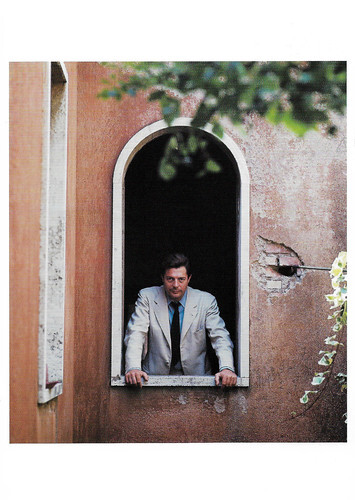
American postcard by Fotofolio, no. Z860. Photo: Milton H. Greene. Caption: Marcello Mastroianni, Rome, 1963.

Italian postcard by Turismofoto, no. 76.
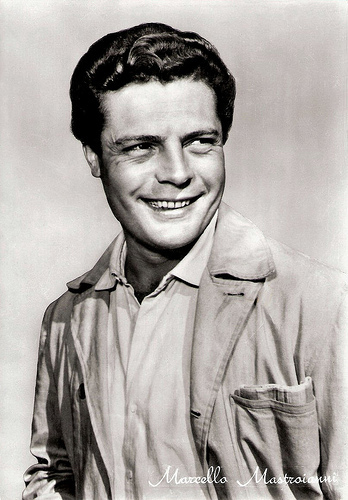
Italian postcard by Rotal Foto, Milano (Milan), no. 250.
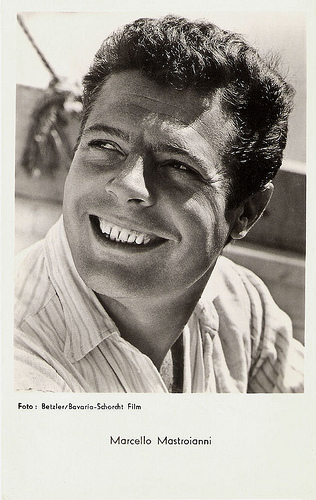
Franco-German postcard by Ufa AG, Berlin / Editions P.I., Paris. Photo: Betzler / Bavaria / Schorcht Film.
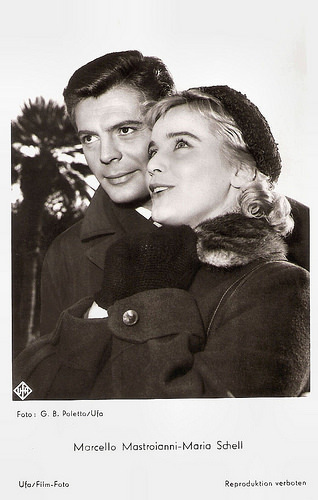
German postcard by Ufa, Berlin-Tempelhof, no. FK 3486. Photo: G.B. Poletto. Publicity still for Le notti bianche / White Nights (Luchino Visconti, 1957) with Maria Schell.
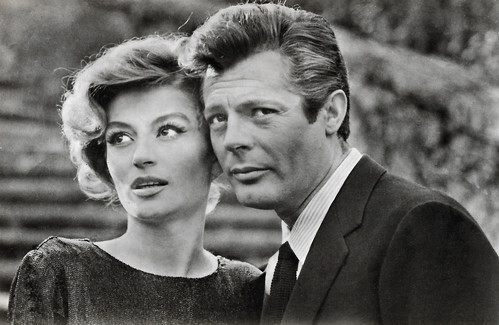
Romanian postcard by Casa Filmului Acin, no. 159. Anouk Aimée and Marcello Mastroianni in La dolce vita / The Sweet Life (Federico Fellini, 1960).
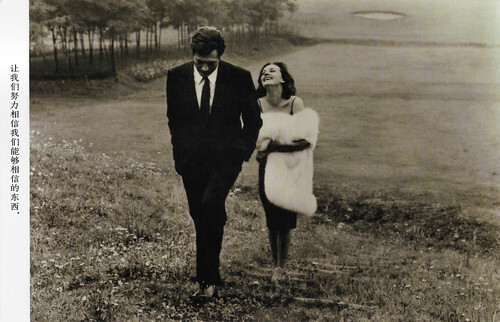
Chinese postcard. Marcello Mastroianni and Jeanne Moreau in La Notte / The Night (Michelangelo Antonioni, 1961).
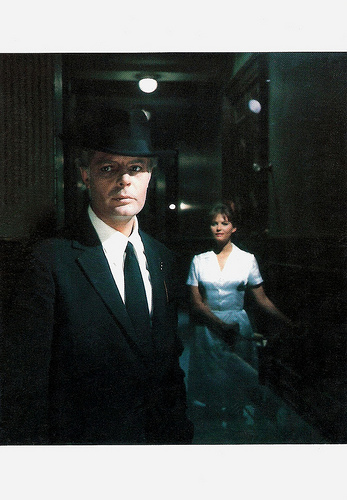
French postcard by Edition La Malibran, Paris, no. MC 38, 1990. Photo: Claude Schwartz. Publicity still for Otto e Mezzo / 8½ (Federico Fellini, 1963) with Claudia Cardinale.
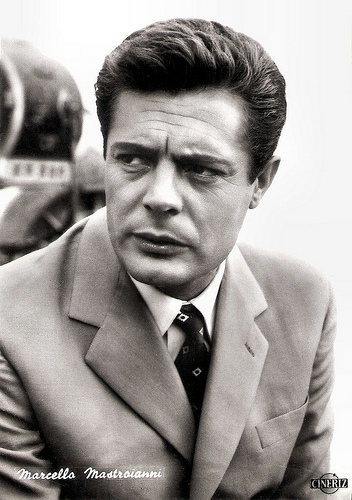
Italian postcard by Bromofoto, no. 1445. Photo: Cineriz.
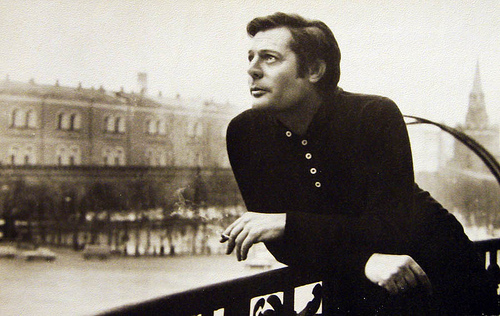
Russian postcard from 1987. Collection: Pierre sur le Ciel.
Forced-labour camp
Marcello Vincenzo Domenico Mastroianni was born in Fontana Liri, a small village in the Apennines, in 1924. He was the son of Ida (née Irolle) and Ottone Mastroianni, who ran a carpentry shop. Marcello grew up in Turin and Rome. He appeared as an uncredited extra in Marionette (Carmine Gallone, 1939) and later appeared as an extra in Una storia d'amore / Love Story (Mario Camerini, 1942) and I bambini ci guardano / The Children Are Watching Us ( Vittorio De Sica , 1944). He worked in his father's carpentry shop, but during World War II he was put to work by the Germans drawing maps. From 1943 to 1944 he was imprisoned in a forced labour camp, but he escaped and hid in Venice.
In 1944, Mastroianni started working as a cashier for the film company Eagle Lion (Rank) in Rome. He began taking acting lessons and acted with the University of Rome dramatic group. In the university's production of Angelica (1948), he appeared with Giulietta Masina . His first real film credit was in I Miserabili / Les misérables (Riccardo Freda, 1948) with Gino Cervi . That year Mastroianni joined Luchino Visconti's repertory company, which was bringing to Italy a new kind of theatre and novel ideas of staging. The young actor played Mitch in 'A Streetcar Named Desire', Happy in 'Death of a Salesman', Stanley Kowalski in Visconti's second staging of Streetcar, and roles in Anton Chekhov's 'Three Sisters' and 'Uncle Vanya'.
He also acted in radio plays and he had his first substantial film role in the comedy Una domenica d'agosto / Sunday in August (Luciano Emmer, 1949). In 1955 Mastroianni co-starred with Vittorio De Sica and Sophia Loren - an actress with whom he would frequently be paired in the years to come - in the Screwball comedy Peccato che Sia una Canaglia / Too Bad She's Bad (Alessandro Blasetti, 1955) and later worked with De Sica again on the comedy Padri e Figli / Like Father, Like Son (Mario Monicelli, 1957).
His roles gradually increased in importance, but for the most part, both the casts and crews of his projects were undistinguished, and he remained unknown outside of Italy. Mastroianni permanently sealed his stardom in Italy, playing a timid clerk whose love is not reciprocated by Maria Schell , in Le notti bianche/White Nights (Luchino Visconti, 1957). He soon became a major international star appearing in films like I soliti ignoti/Big Deal on Madonna Street (Mario Monicelli, 1958) with Vittorio Gassman . In this classic crime caper, he displayed a light touch of comedy, playing the exasperated member of an inept group of burglars.
In 1960 he played his most famous role as a disillusioned and world-weary tabloid columnist who spends his days and nights exploring Rome's high society in Federico Fellini's La dolce vita / The Sweet Life (1960) with Anita Ekberg . La dolce vita changed the look and direction of the Italian cinema. Hal Erickson at AllMovie : "Throughout his adventures, Marcello's dreams, fantasies, and nightmares are mirrored by the hedonism around him. With a shrug, he concludes that, while his lifestyle is shallow and ultimately pointless, there's nothing he can do to change it so he might as well enjoy it. Fellini's hallucinatory, circus-like depictions of modern life first earned the adjective 'Felliniesque' in this celebrated movie, which also traded on the idea of Rome as a hotbed of sex and decadence. A huge worldwide success, La Dolce Vita won several awards, including a New York Film Critics Circle award for Best Foreign Film and the Palme d'Or at the Cannes Film Festival."
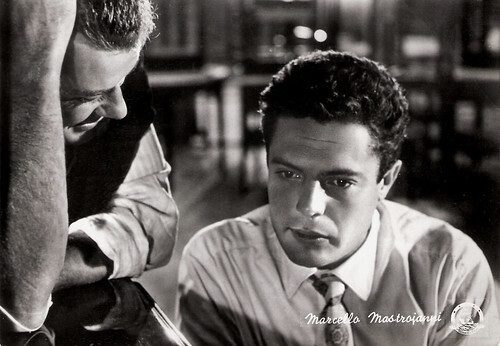
Italian postcard by Bromofoto, Milano, no. 460. Photo: Atlantis Film. Marcello Mastroianni in Febbre di vivere / Eager to Live (Claudio Gora, 1953).
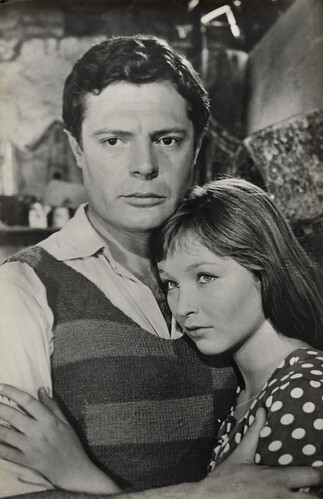
Spanish postcard by F.A.G. Marcello Mastroianni and Marina Vlady in Giorni d'amore / Days of Love (Giuseppe De Santis, 1954).
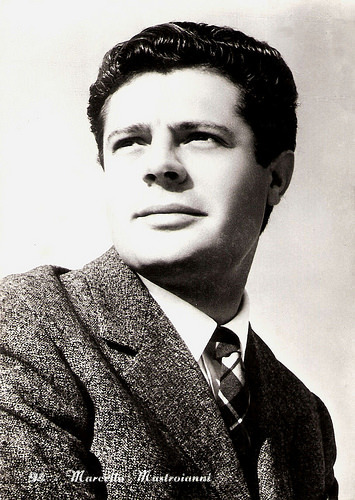
Italian postcard by Turismofoto, no. 94.
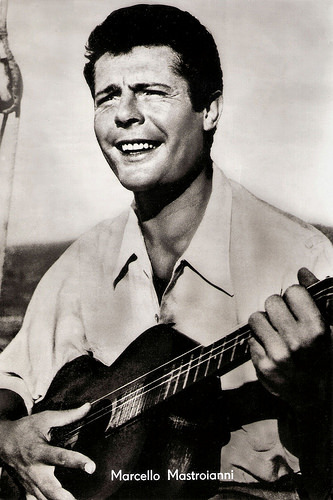
Big East-German card by VEB Progress Film-Vertrieb, Berlin, no. 68/72. Photo: Steffen.
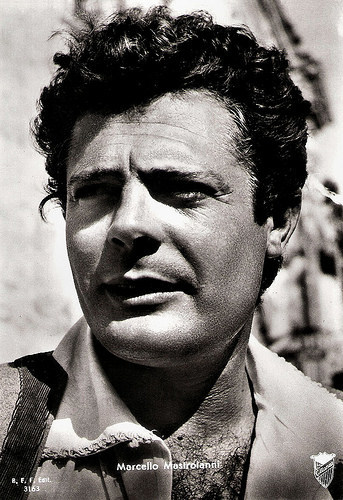
Italian postcard by B.F.F. Edit., no. 3163. Photo: Titanus. Publicity still for La Bella Mugnaia / The Miller's Beautiful Wife (Mario Camerini, 1955).
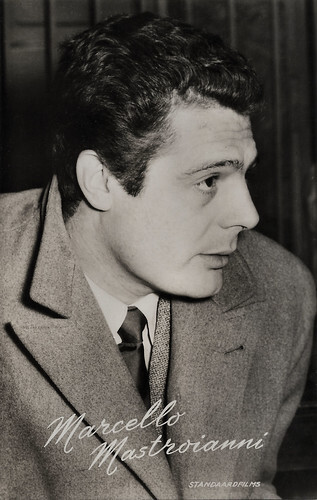
Dutch postcard by Uitg. Takken, no. AX 3203. Photo: Standaardfilms. Publicity still for Padri e figli... / Fathers and Sons (Mario Monicelli, 1957).
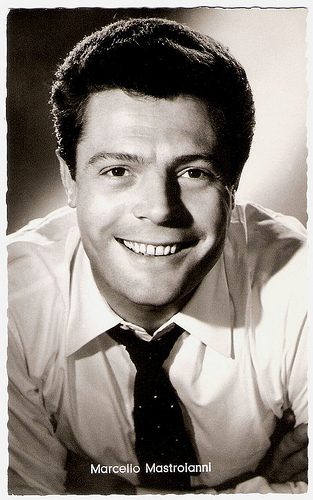
German postcard by Kolibri-Verlag, Minden / Westf., no. 2361. Photo: Bavaria / Schorcht / Vogelmann. Publicity still for Mädchen und Männer / La ragazza della salina / Sand, Love and Salt (1957).
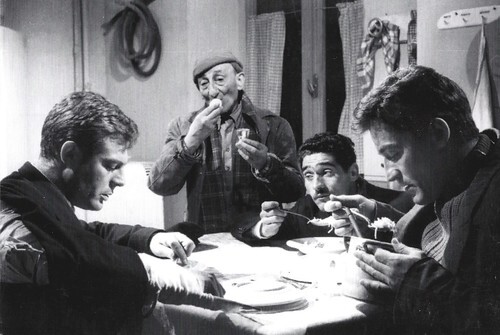
Italian postcard. Marcello Mastroianni in I soliti ignoti/ Big Deal on Madonna Street (Mario Monicelli, 1958). The old man in the back is Carlo Pisacane.
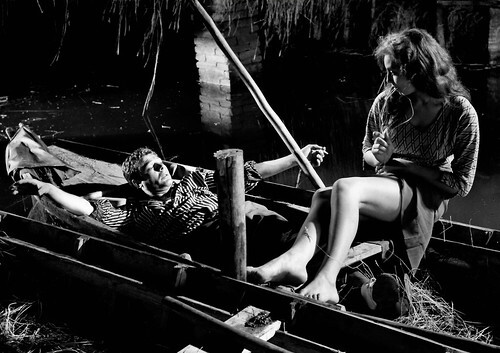
Vintage photo. Marcello Mastroianni and Rosanna Schiaffino in Un ettaro di cielo / Piece of the Sky (Aglauco Casadio, 1958).

Italian postcard by Nuova Arti Grafiche Ricordi S.R.L. / Cinisello Balsamo, no. 2996, 1998. Photo: publicity still for Il bell' Antonio/Bell' Antonio (Mauro Bolognini, 1960).
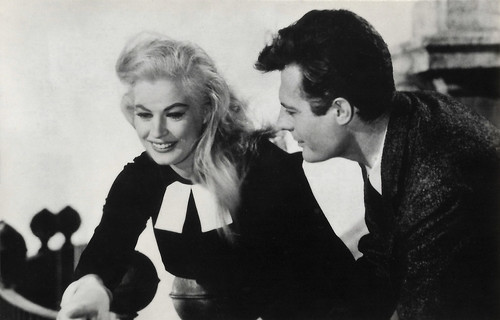
Small Czechoslovakian card by Pressfoto, Praha (Prague), no. S 83/7, 1965. Retail price: 0,50 Kcs. Anita Ekberg and Marcello Mastroianni in La dolce vita (Federico Fellini, 1960).
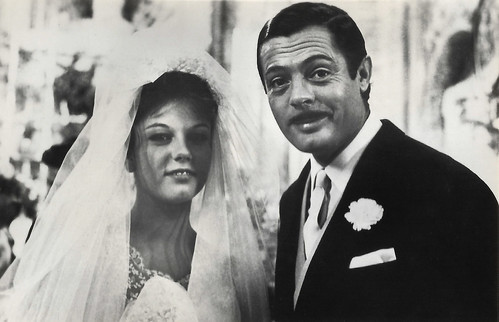
Small Czech collector card by Pressfoto, Praha (Prague), 1965, no. S 83/6. Stefania Sandrelli and Marcello Mastroianni in Divorzio all'italiana / Divorce, Italian Style (Pietro Germi, 1961).
Not one-dimensional pretty boys
During the 1960s Marcello Mastroianni played in many great films and regularly worked with top Italian and French filmmakers. He appeared as the title character in Il bell'Antonio / Bell' Antonio (Mauro Bolognini, 1960) and starred in Michelangelo Antonioni’s masterpiece La notte / The Night (1961), where again his distanced, expressionless demeanour fit perfectly into the film's air of alienation and remote emotionality. He appeared in interesting films like L'assassino / The Assassin (Elio Petri, 1961), La Vie Privée / A Very Private Affair (Louis Malle, 1962) with Brigitte Bardot , and Cronaca familiare / Family Diary (Valerio Zurlini, 1962) with Jacques Perrin .
Mastroianni followed La dolce vita with another signature role for Fellini, that of Fellini’s alter-ego, a film director who, amidst self-doubt and troubled love affairs, finds himself in a creative block while making a film in Otto e Mezzo / 8½ (Federico Fellini, 1962). The film won two Academy Awards. Mastroianni won the British BAFTA award twice for his roles in the black comedy Divorzio all'Italiana / Divorce, Italian Style (Pietro Germi, 1963) and the deliciously funny three-part sex farce Ieri, oggi, domani / Yesterday, Today, and Tomorrow (Vittorio De Sica, 1963) costarring with Sophia Loren . He and Loren starred together again in the equally amusing sex comedy Matrimonio all'italiana/Marriage Italian Style (Vittorio De Sica, 1964).
According to Elaine Mancini on Film Reference “Mastroianni's masculinity blends perfectly with Loren's exuberant earthy personality” in both these films. While he was to become known for playing Latin lover roles (which he spoofed in Casanova 70 (Mario Monicelli, 1965), his characters often were far more complexly drawn. They were not one-dimensional pretty boys; rather, beneath their handsome exteriors they were lazy, world-weary, and doubt-ridden. Other films were La decima vittima/The Tenth Victim (Elio Petri, 1965) with Ursula Andress and the Albert Camus adaptation Lo Straniero/The Stranger (Luchino Visconti, 1967) with Anna Karina .
Mastroianni won the Best Actor award at the Cannes Film Festival for Dramma della gelosia - tutti i particolari in cronaca/Drama of Jealousy (Ettore Scola, 1970). In 1987 he would win the award again for Oci ciornie/Dark Eyes (Nikita Mikhalkov, 1987). Mastroianni, Dean Stockwell and Jack Lemmon are the only actors to have won the award twice. During the 1970s Mastroianni continued to work in interesting films by prolific directors like Leo the Last (John Boorman, 1970), Permette? Rocco Papaleo/My Name Is Rocco Papaleo (Ettore Scola, 1971) with Lauren Hutton, Che?/What? (Roman Polanski, 1972) with Sydne Rome and La donna della domenica/The Sunday Woman (Luigi Comencini, 1975) with Jacqueline Bisset .
He often worked with controversial director Marco Ferreri at Liza (Marco Ferreri, 1972) with Catherine Deneuve , La Grande Bouffe/Blow Out (Marco Ferreri, 1973), Touche pas à la femme blanche/ Don't Touch the White Woman! (Marco Ferreri, 1974), and Ciao maschio/Bye Bye Monkey (Marco Ferreri, 1978) with Gérard Depardieu .Other interesting films are Così come sei/Stay as You Are (Alberto Lattuada, 1978) with Nastassja Kinski , L'ingorgo - Una storia impossibile/Traffic Jam (Luigi Comencini, 1979) with Annie Girardot , and La terrazza/The Terrace (Ettore Scola, 1980) with Vittorio Gassman . He played against his Latin lover image in Scola’s Una giornata particolare/A Special Day (Ettore Scola, 1977), in which Mastroianni's homosexual and Sophia Loren 's oppressed housewife come together on the day in 1938 when Adolph Hitler was cheered on the streets of Rome during his visit to Benito Mussolini. His seemingly detached air was perfectly suited to satire as well, as he demonstrated in films as diverse as the historical drama Allonsanfàn (Paolo and Vittorio Taviani, 1974), and La città delle donne / City of Women (Federico Fellini, 1980).

Small Czechoslovakian card by Presseojo, Praha (Prague), no. 83/9, 1965. Retail price: 0,50 Kcs. Marcello Mastroianni in 8½ (Federico Fellini, 1963).
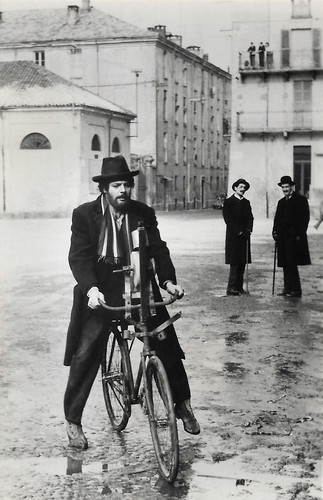
Small Czechoslovakian card by Pressfoto, Praha (Prague), no. S 83/8, 1965. Retail price: 0,50 Kcs. Marcello Mastroianni in I compagni/The Organiser (Mario Monicelli, 1963).
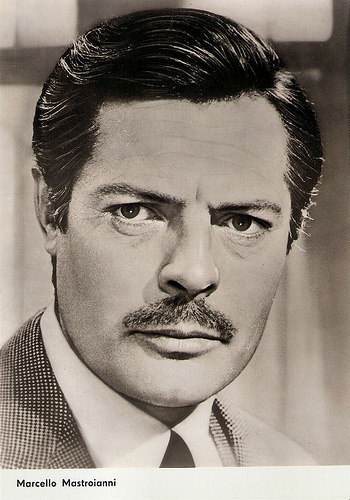
East-German postcard by VEB Progress Film-Vertrieb, Berlin, no. 2634. Photo: publicity still for Matrimonio all'italiana / Marriage Italian Style (Vittorio De Sica, 1964).
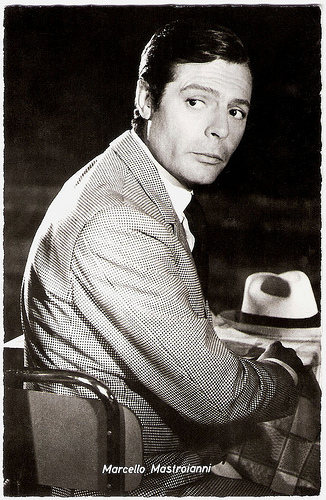
German postcard by Friedrich W. Sander Verlag, Minden. Photo: Inter Film. Still for Casanova 70 (Mario Monicelli, 1965).

Romanian postcard by Casa Filmului Acin. Marcello Mastroianni in Lo Straniero / The Stranger (Luchino Visconti, 1967).
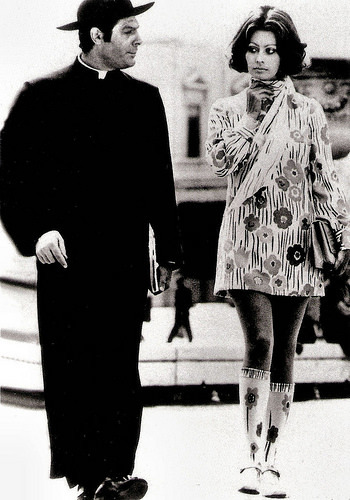
German postcard by pwe Verlag, München (Munich). Photo: publicity still for La moglie del prete / The Priest's Wife (Dino Risi, 1970) with Sophia Loren.
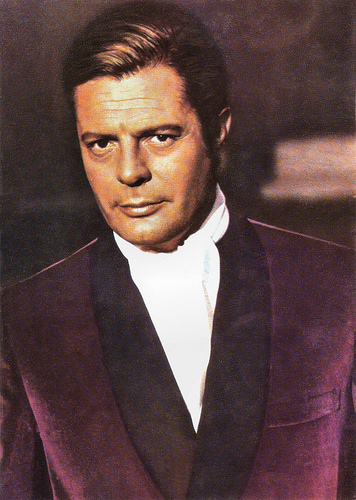
Romanian postcard by Casa Filmului Acin, no. 4881.
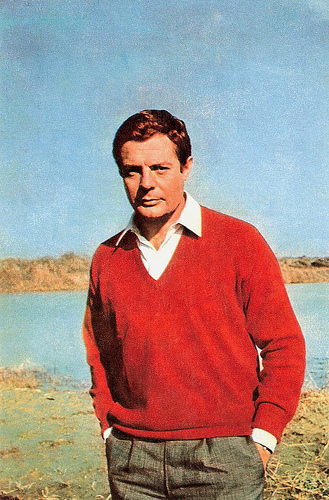
Russian postcard by Izdanije Byuro Propogandy Sovietskogo Kinoiskusstva, no. 3624, 1975. This postcard was printed in an edition of 200.000 cards. Retail price: 5 kop.

Romanian postcard by Casa Filmului Acin. Photo: publicity still for La terrazza (Ettore Scola, 1980) with Marie Trintignant.
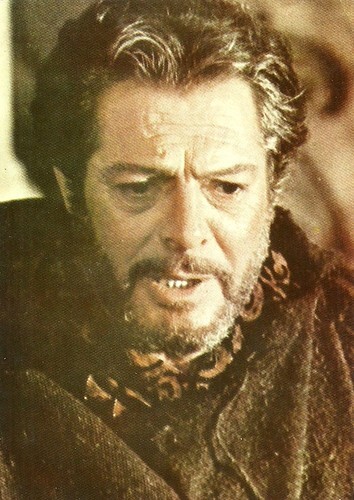
Romanian postcard by Casa Filmului Acin. Photo: publicity still for Enrico IV / Henry IV (Marco Bellocchio, 1984).

Big East-German card by VEB Progress Film-Verleih, Berlin, no. 1020. Jack Lemmon and Marcello Mastroianni in Maccheroni / Macaroni (Ettore Scola, 1985).
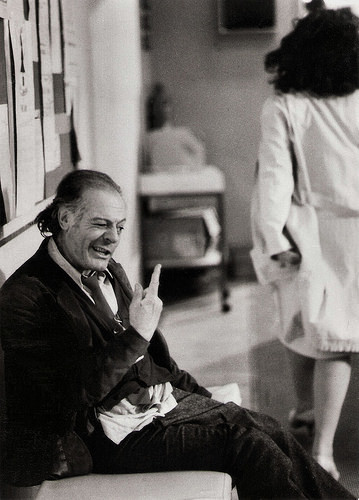
German press photo, no. 5. Photo: Tobis. Publicity still for Ginger e Fred (Federico Fellini, 1986).
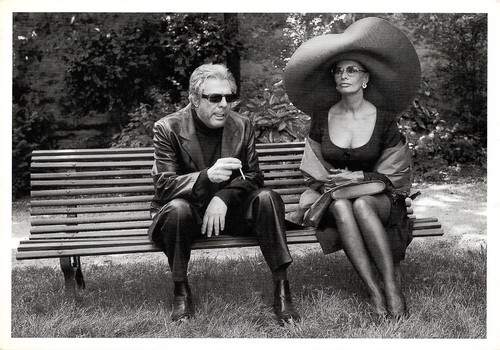
French postcard in the Collection Magie Noire by Éditions Hazan, Paris, 1997, no. 6521. Photo: Constant Anée. Marcello Mastroianni and Sophia Loren in Prêt-à-Porter (Robert Altman, 1994).
Wonderfully nostalgic
In the latter stages of his career, Marcello Mastroianni continued to take serious dramatic roles. For instance, he played the senior citizen who simply looks back on his past. In Stanno tutti bene / Everybody's Fine (Giuseppe Tornatore, 1990), he is an elderly man who is absorbed in his memories, and who travels through Italy to call on his five adult children. In Oci ciornie / Dark Eyes (Nikita Mikhalkov, 1987), he gives a tour-de-force performance as a once young and idealistic aspiring architect who married a banker's daughter, fell into a lifestyle of afternoon snoozes and philandering, and proved incapable of holding onto what was important to him.
His on-screen presence has also been directly linked to his earlier screen characterisations. In Prêt-à-Porter / Ready to Wear (Robert Altman, 1994), he was reunited with Sophia Loren , and at one point in the scenario, she recreated her famous steamy striptease sequence from Yesterday, Today, and Tomorrow. Loren was as beguiling as she had been 30 years earlier but Mastroianni was no longer the attentive young lover, so Sophia's seductive moves only put him to sleep. Mastroianni's appearance in two of Fellini's final features is especially sentimental. Ginger e Fred / Ginger and Fred (Federico Fellini, 1996) is sweetly nostalgic for its union of Mastroianni and Giulietta Masina , two of the maestro's then-ageing but still vibrant stars of the past.
In Intervista (Federico Fellini, 1987), he appears as himself with Anita Ekberg , with whom he had starred decades before in La dolce vita. Mastroianni's entrance is especially magical; the sequence in which he and Ekberg (who, he remarks, he has not seen since making La dolce vita) observe their younger selves in some famous clips from that film is wonderfully nostalgic. with a Lifetime Achievement Award at the European Film Awards. He kept appearing in critically acclaimed films like To meteoro vima tou pelargou / The Suspended Step of the Stork (Theodoros Angelopoulos, 1991), in which he was quietly poignant as an obscure man who may have once been an important Greek politician who had disappeared years earlier.
Other films were Al di là delle nuvole / Beyond the Clouds (Michelangelo Antonioni, 1995) and Trois vies et une seule mort / Three Lives and Only One Death (Raúl Ruiz, 1996) with Anna Galiena. His final film was Viagem ao Princípio do Mundo / Voyage to the Beginning of the World (Manoel de Oliveira, 1997). Marcello Mastroianni was married to Italian actress Flora Carabella (1926-1999) from 1948 until his death. They had one child together, Barbara. Mastroianni also had a daughter, actress Chiara Mastroianni, with French film star Catherine Deneuve , his longtime lover during the 1970s.
Both Flora and Catherine were at his bedside in Paris when he died of pancreatic cancer at the age of 72, as was his partner at the time, author and filmmaker Anna Maria Tatò. According to Christopher Wiegand and Paul Duncan in their book Federico Fellini, when Mastroianni died in 1996, the Fontana di Trevi (Trevi Fountain), which is so famously associated with him due to his role in Fellini's La dolce vita, was symbolically turned off and draped in black as a tribute. His brother Ruggero Mastroianni (1929-1996) was a highly regarded film editor who edited several of Marcello's films directed by Federico Fellini and appeared alongside Marcello in Scipione detto anche l'Africano / Scipio the African (Luigi Magni, 1971), a comedic take on the once popular Peplum, the Sword and Sandal film genre. Marcello Mastroianni has held starring roles in about 120 films throughout his long career.
Trailer for Domenica d'agosto (1950). Source: Ugo Tramontano (YouTube).
The classic Trevi Fountain scene in La dolce vita/The Sweet Life (1960) with Anita Ekberg . Source: רונן אברהם (YouTube).
Trailer for 8 1/2 (1961). Source: BFI (YouTube).
Trailer for La Notte (1961). Source: Hadalat (YouTube).
Trailer for Ieri, oggi, domain / Yesterday, Today, and Tomorrow (1963). Source: Jeffrey M. Anderson (YouTube).
Trailer for La Grande Bouffe/Blow Out (1973). Source: Arrow Video (YouTube).
Trailer for Una giornata particulate / A Special Day (1977). Source: Argent Films (YouTube).
Trailer for La città delle done / City of Women (1980). Source: Das Film Feuilleton (YouTube).
Trailer for Ginger e Fred / Ginger and Fred (1986). Source: Movieclips Trailer Vault (YouTube).
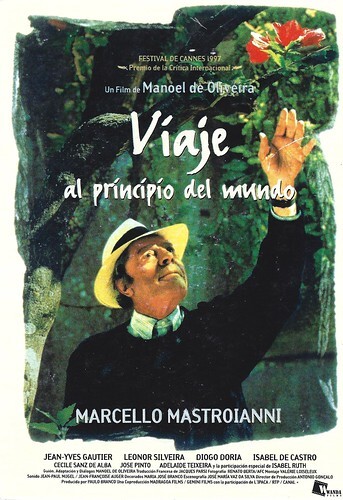
Spanish poster postcard. Marcello Mastroianni in the Franco-Portuguese film Voyage to the Beginning of the World / Viagem ao Princípio do Mundo / Voyage au début du Monde (Manoel de Oliveira, 1997). It was Mastroianni's final film.
Sources: Elaine Mancini (Film Reference; updated by Rob Edelman), Hal Erickson (AllMovie - Page now defunct), Jason Ankeny (AllMovie - Page now defunct), Wikipedia and .

American postcard by Fotofolio, no. Z860. Photo: Milton H. Greene. Caption: Marcello Mastroianni, Rome, 1963.

Italian postcard by Turismofoto, no. 76.

Italian postcard by Rotal Foto, Milano (Milan), no. 250.

Franco-German postcard by Ufa AG, Berlin / Editions P.I., Paris. Photo: Betzler / Bavaria / Schorcht Film.

German postcard by Ufa, Berlin-Tempelhof, no. FK 3486. Photo: G.B. Poletto. Publicity still for Le notti bianche / White Nights (Luchino Visconti, 1957) with Maria Schell.

Romanian postcard by Casa Filmului Acin, no. 159. Anouk Aimée and Marcello Mastroianni in La dolce vita / The Sweet Life (Federico Fellini, 1960).

Chinese postcard. Marcello Mastroianni and Jeanne Moreau in La Notte / The Night (Michelangelo Antonioni, 1961).

French postcard by Edition La Malibran, Paris, no. MC 38, 1990. Photo: Claude Schwartz. Publicity still for Otto e Mezzo / 8½ (Federico Fellini, 1963) with Claudia Cardinale.

Italian postcard by Bromofoto, no. 1445. Photo: Cineriz.

Russian postcard from 1987. Collection: Pierre sur le Ciel.
Forced-labour camp
Marcello Vincenzo Domenico Mastroianni was born in Fontana Liri, a small village in the Apennines, in 1924. He was the son of Ida (née Irolle) and Ottone Mastroianni, who ran a carpentry shop. Marcello grew up in Turin and Rome. He appeared as an uncredited extra in Marionette (Carmine Gallone, 1939) and later appeared as an extra in Una storia d'amore / Love Story (Mario Camerini, 1942) and I bambini ci guardano / The Children Are Watching Us ( Vittorio De Sica , 1944). He worked in his father's carpentry shop, but during World War II he was put to work by the Germans drawing maps. From 1943 to 1944 he was imprisoned in a forced labour camp, but he escaped and hid in Venice.
In 1944, Mastroianni started working as a cashier for the film company Eagle Lion (Rank) in Rome. He began taking acting lessons and acted with the University of Rome dramatic group. In the university's production of Angelica (1948), he appeared with Giulietta Masina . His first real film credit was in I Miserabili / Les misérables (Riccardo Freda, 1948) with Gino Cervi . That year Mastroianni joined Luchino Visconti's repertory company, which was bringing to Italy a new kind of theatre and novel ideas of staging. The young actor played Mitch in 'A Streetcar Named Desire', Happy in 'Death of a Salesman', Stanley Kowalski in Visconti's second staging of Streetcar, and roles in Anton Chekhov's 'Three Sisters' and 'Uncle Vanya'.
He also acted in radio plays and he had his first substantial film role in the comedy Una domenica d'agosto / Sunday in August (Luciano Emmer, 1949). In 1955 Mastroianni co-starred with Vittorio De Sica and Sophia Loren - an actress with whom he would frequently be paired in the years to come - in the Screwball comedy Peccato che Sia una Canaglia / Too Bad She's Bad (Alessandro Blasetti, 1955) and later worked with De Sica again on the comedy Padri e Figli / Like Father, Like Son (Mario Monicelli, 1957).
His roles gradually increased in importance, but for the most part, both the casts and crews of his projects were undistinguished, and he remained unknown outside of Italy. Mastroianni permanently sealed his stardom in Italy, playing a timid clerk whose love is not reciprocated by Maria Schell , in Le notti bianche/White Nights (Luchino Visconti, 1957). He soon became a major international star appearing in films like I soliti ignoti/Big Deal on Madonna Street (Mario Monicelli, 1958) with Vittorio Gassman . In this classic crime caper, he displayed a light touch of comedy, playing the exasperated member of an inept group of burglars.
In 1960 he played his most famous role as a disillusioned and world-weary tabloid columnist who spends his days and nights exploring Rome's high society in Federico Fellini's La dolce vita / The Sweet Life (1960) with Anita Ekberg . La dolce vita changed the look and direction of the Italian cinema. Hal Erickson at AllMovie : "Throughout his adventures, Marcello's dreams, fantasies, and nightmares are mirrored by the hedonism around him. With a shrug, he concludes that, while his lifestyle is shallow and ultimately pointless, there's nothing he can do to change it so he might as well enjoy it. Fellini's hallucinatory, circus-like depictions of modern life first earned the adjective 'Felliniesque' in this celebrated movie, which also traded on the idea of Rome as a hotbed of sex and decadence. A huge worldwide success, La Dolce Vita won several awards, including a New York Film Critics Circle award for Best Foreign Film and the Palme d'Or at the Cannes Film Festival."

Italian postcard by Bromofoto, Milano, no. 460. Photo: Atlantis Film. Marcello Mastroianni in Febbre di vivere / Eager to Live (Claudio Gora, 1953).

Spanish postcard by F.A.G. Marcello Mastroianni and Marina Vlady in Giorni d'amore / Days of Love (Giuseppe De Santis, 1954).

Italian postcard by Turismofoto, no. 94.

Big East-German card by VEB Progress Film-Vertrieb, Berlin, no. 68/72. Photo: Steffen.

Italian postcard by B.F.F. Edit., no. 3163. Photo: Titanus. Publicity still for La Bella Mugnaia / The Miller's Beautiful Wife (Mario Camerini, 1955).

Dutch postcard by Uitg. Takken, no. AX 3203. Photo: Standaardfilms. Publicity still for Padri e figli... / Fathers and Sons (Mario Monicelli, 1957).

German postcard by Kolibri-Verlag, Minden / Westf., no. 2361. Photo: Bavaria / Schorcht / Vogelmann. Publicity still for Mädchen und Männer / La ragazza della salina / Sand, Love and Salt (1957).

Italian postcard. Marcello Mastroianni in I soliti ignoti/ Big Deal on Madonna Street (Mario Monicelli, 1958). The old man in the back is Carlo Pisacane.

Vintage photo. Marcello Mastroianni and Rosanna Schiaffino in Un ettaro di cielo / Piece of the Sky (Aglauco Casadio, 1958).

Italian postcard by Nuova Arti Grafiche Ricordi S.R.L. / Cinisello Balsamo, no. 2996, 1998. Photo: publicity still for Il bell' Antonio/Bell' Antonio (Mauro Bolognini, 1960).

Small Czechoslovakian card by Pressfoto, Praha (Prague), no. S 83/7, 1965. Retail price: 0,50 Kcs. Anita Ekberg and Marcello Mastroianni in La dolce vita (Federico Fellini, 1960).

Small Czech collector card by Pressfoto, Praha (Prague), 1965, no. S 83/6. Stefania Sandrelli and Marcello Mastroianni in Divorzio all'italiana / Divorce, Italian Style (Pietro Germi, 1961).
Not one-dimensional pretty boys
During the 1960s Marcello Mastroianni played in many great films and regularly worked with top Italian and French filmmakers. He appeared as the title character in Il bell'Antonio / Bell' Antonio (Mauro Bolognini, 1960) and starred in Michelangelo Antonioni’s masterpiece La notte / The Night (1961), where again his distanced, expressionless demeanour fit perfectly into the film's air of alienation and remote emotionality. He appeared in interesting films like L'assassino / The Assassin (Elio Petri, 1961), La Vie Privée / A Very Private Affair (Louis Malle, 1962) with Brigitte Bardot , and Cronaca familiare / Family Diary (Valerio Zurlini, 1962) with Jacques Perrin .
Mastroianni followed La dolce vita with another signature role for Fellini, that of Fellini’s alter-ego, a film director who, amidst self-doubt and troubled love affairs, finds himself in a creative block while making a film in Otto e Mezzo / 8½ (Federico Fellini, 1962). The film won two Academy Awards. Mastroianni won the British BAFTA award twice for his roles in the black comedy Divorzio all'Italiana / Divorce, Italian Style (Pietro Germi, 1963) and the deliciously funny three-part sex farce Ieri, oggi, domani / Yesterday, Today, and Tomorrow (Vittorio De Sica, 1963) costarring with Sophia Loren . He and Loren starred together again in the equally amusing sex comedy Matrimonio all'italiana/Marriage Italian Style (Vittorio De Sica, 1964).
According to Elaine Mancini on Film Reference “Mastroianni's masculinity blends perfectly with Loren's exuberant earthy personality” in both these films. While he was to become known for playing Latin lover roles (which he spoofed in Casanova 70 (Mario Monicelli, 1965), his characters often were far more complexly drawn. They were not one-dimensional pretty boys; rather, beneath their handsome exteriors they were lazy, world-weary, and doubt-ridden. Other films were La decima vittima/The Tenth Victim (Elio Petri, 1965) with Ursula Andress and the Albert Camus adaptation Lo Straniero/The Stranger (Luchino Visconti, 1967) with Anna Karina .
Mastroianni won the Best Actor award at the Cannes Film Festival for Dramma della gelosia - tutti i particolari in cronaca/Drama of Jealousy (Ettore Scola, 1970). In 1987 he would win the award again for Oci ciornie/Dark Eyes (Nikita Mikhalkov, 1987). Mastroianni, Dean Stockwell and Jack Lemmon are the only actors to have won the award twice. During the 1970s Mastroianni continued to work in interesting films by prolific directors like Leo the Last (John Boorman, 1970), Permette? Rocco Papaleo/My Name Is Rocco Papaleo (Ettore Scola, 1971) with Lauren Hutton, Che?/What? (Roman Polanski, 1972) with Sydne Rome and La donna della domenica/The Sunday Woman (Luigi Comencini, 1975) with Jacqueline Bisset .
He often worked with controversial director Marco Ferreri at Liza (Marco Ferreri, 1972) with Catherine Deneuve , La Grande Bouffe/Blow Out (Marco Ferreri, 1973), Touche pas à la femme blanche/ Don't Touch the White Woman! (Marco Ferreri, 1974), and Ciao maschio/Bye Bye Monkey (Marco Ferreri, 1978) with Gérard Depardieu .Other interesting films are Così come sei/Stay as You Are (Alberto Lattuada, 1978) with Nastassja Kinski , L'ingorgo - Una storia impossibile/Traffic Jam (Luigi Comencini, 1979) with Annie Girardot , and La terrazza/The Terrace (Ettore Scola, 1980) with Vittorio Gassman . He played against his Latin lover image in Scola’s Una giornata particolare/A Special Day (Ettore Scola, 1977), in which Mastroianni's homosexual and Sophia Loren 's oppressed housewife come together on the day in 1938 when Adolph Hitler was cheered on the streets of Rome during his visit to Benito Mussolini. His seemingly detached air was perfectly suited to satire as well, as he demonstrated in films as diverse as the historical drama Allonsanfàn (Paolo and Vittorio Taviani, 1974), and La città delle donne / City of Women (Federico Fellini, 1980).

Small Czechoslovakian card by Presseojo, Praha (Prague), no. 83/9, 1965. Retail price: 0,50 Kcs. Marcello Mastroianni in 8½ (Federico Fellini, 1963).

Small Czechoslovakian card by Pressfoto, Praha (Prague), no. S 83/8, 1965. Retail price: 0,50 Kcs. Marcello Mastroianni in I compagni/The Organiser (Mario Monicelli, 1963).

East-German postcard by VEB Progress Film-Vertrieb, Berlin, no. 2634. Photo: publicity still for Matrimonio all'italiana / Marriage Italian Style (Vittorio De Sica, 1964).

German postcard by Friedrich W. Sander Verlag, Minden. Photo: Inter Film. Still for Casanova 70 (Mario Monicelli, 1965).

Romanian postcard by Casa Filmului Acin. Marcello Mastroianni in Lo Straniero / The Stranger (Luchino Visconti, 1967).

German postcard by pwe Verlag, München (Munich). Photo: publicity still for La moglie del prete / The Priest's Wife (Dino Risi, 1970) with Sophia Loren.

Romanian postcard by Casa Filmului Acin, no. 4881.

Russian postcard by Izdanije Byuro Propogandy Sovietskogo Kinoiskusstva, no. 3624, 1975. This postcard was printed in an edition of 200.000 cards. Retail price: 5 kop.

Romanian postcard by Casa Filmului Acin. Photo: publicity still for La terrazza (Ettore Scola, 1980) with Marie Trintignant.

Romanian postcard by Casa Filmului Acin. Photo: publicity still for Enrico IV / Henry IV (Marco Bellocchio, 1984).

Big East-German card by VEB Progress Film-Verleih, Berlin, no. 1020. Jack Lemmon and Marcello Mastroianni in Maccheroni / Macaroni (Ettore Scola, 1985).

German press photo, no. 5. Photo: Tobis. Publicity still for Ginger e Fred (Federico Fellini, 1986).

French postcard in the Collection Magie Noire by Éditions Hazan, Paris, 1997, no. 6521. Photo: Constant Anée. Marcello Mastroianni and Sophia Loren in Prêt-à-Porter (Robert Altman, 1994).
Wonderfully nostalgic
In the latter stages of his career, Marcello Mastroianni continued to take serious dramatic roles. For instance, he played the senior citizen who simply looks back on his past. In Stanno tutti bene / Everybody's Fine (Giuseppe Tornatore, 1990), he is an elderly man who is absorbed in his memories, and who travels through Italy to call on his five adult children. In Oci ciornie / Dark Eyes (Nikita Mikhalkov, 1987), he gives a tour-de-force performance as a once young and idealistic aspiring architect who married a banker's daughter, fell into a lifestyle of afternoon snoozes and philandering, and proved incapable of holding onto what was important to him.
His on-screen presence has also been directly linked to his earlier screen characterisations. In Prêt-à-Porter / Ready to Wear (Robert Altman, 1994), he was reunited with Sophia Loren , and at one point in the scenario, she recreated her famous steamy striptease sequence from Yesterday, Today, and Tomorrow. Loren was as beguiling as she had been 30 years earlier but Mastroianni was no longer the attentive young lover, so Sophia's seductive moves only put him to sleep. Mastroianni's appearance in two of Fellini's final features is especially sentimental. Ginger e Fred / Ginger and Fred (Federico Fellini, 1996) is sweetly nostalgic for its union of Mastroianni and Giulietta Masina , two of the maestro's then-ageing but still vibrant stars of the past.
In Intervista (Federico Fellini, 1987), he appears as himself with Anita Ekberg , with whom he had starred decades before in La dolce vita. Mastroianni's entrance is especially magical; the sequence in which he and Ekberg (who, he remarks, he has not seen since making La dolce vita) observe their younger selves in some famous clips from that film is wonderfully nostalgic. with a Lifetime Achievement Award at the European Film Awards. He kept appearing in critically acclaimed films like To meteoro vima tou pelargou / The Suspended Step of the Stork (Theodoros Angelopoulos, 1991), in which he was quietly poignant as an obscure man who may have once been an important Greek politician who had disappeared years earlier.
Other films were Al di là delle nuvole / Beyond the Clouds (Michelangelo Antonioni, 1995) and Trois vies et une seule mort / Three Lives and Only One Death (Raúl Ruiz, 1996) with Anna Galiena. His final film was Viagem ao Princípio do Mundo / Voyage to the Beginning of the World (Manoel de Oliveira, 1997). Marcello Mastroianni was married to Italian actress Flora Carabella (1926-1999) from 1948 until his death. They had one child together, Barbara. Mastroianni also had a daughter, actress Chiara Mastroianni, with French film star Catherine Deneuve , his longtime lover during the 1970s.
Both Flora and Catherine were at his bedside in Paris when he died of pancreatic cancer at the age of 72, as was his partner at the time, author and filmmaker Anna Maria Tatò. According to Christopher Wiegand and Paul Duncan in their book Federico Fellini, when Mastroianni died in 1996, the Fontana di Trevi (Trevi Fountain), which is so famously associated with him due to his role in Fellini's La dolce vita, was symbolically turned off and draped in black as a tribute. His brother Ruggero Mastroianni (1929-1996) was a highly regarded film editor who edited several of Marcello's films directed by Federico Fellini and appeared alongside Marcello in Scipione detto anche l'Africano / Scipio the African (Luigi Magni, 1971), a comedic take on the once popular Peplum, the Sword and Sandal film genre. Marcello Mastroianni has held starring roles in about 120 films throughout his long career.
Trailer for Domenica d'agosto (1950). Source: Ugo Tramontano (YouTube).
The classic Trevi Fountain scene in La dolce vita/The Sweet Life (1960) with Anita Ekberg . Source: רונן אברהם (YouTube).
Trailer for 8 1/2 (1961). Source: BFI (YouTube).
Trailer for La Notte (1961). Source: Hadalat (YouTube).
Trailer for Ieri, oggi, domain / Yesterday, Today, and Tomorrow (1963). Source: Jeffrey M. Anderson (YouTube).
Trailer for La Grande Bouffe/Blow Out (1973). Source: Arrow Video (YouTube).
Trailer for Una giornata particulate / A Special Day (1977). Source: Argent Films (YouTube).
Trailer for La città delle done / City of Women (1980). Source: Das Film Feuilleton (YouTube).
Trailer for Ginger e Fred / Ginger and Fred (1986). Source: Movieclips Trailer Vault (YouTube).

Spanish poster postcard. Marcello Mastroianni in the Franco-Portuguese film Voyage to the Beginning of the World / Viagem ao Princípio do Mundo / Voyage au début du Monde (Manoel de Oliveira, 1997). It was Mastroianni's final film.
Sources: Elaine Mancini (Film Reference; updated by Rob Edelman), Hal Erickson (AllMovie - Page now defunct), Jason Ankeny (AllMovie - Page now defunct), Wikipedia and .
Published on May 19, 2025 22:00
Paul van Yperen's Blog
- Paul van Yperen's profile
- 13 followers
Paul van Yperen isn't a Goodreads Author
(yet),
but they
do have a blog,
so here are some recent posts imported from
their feed.



